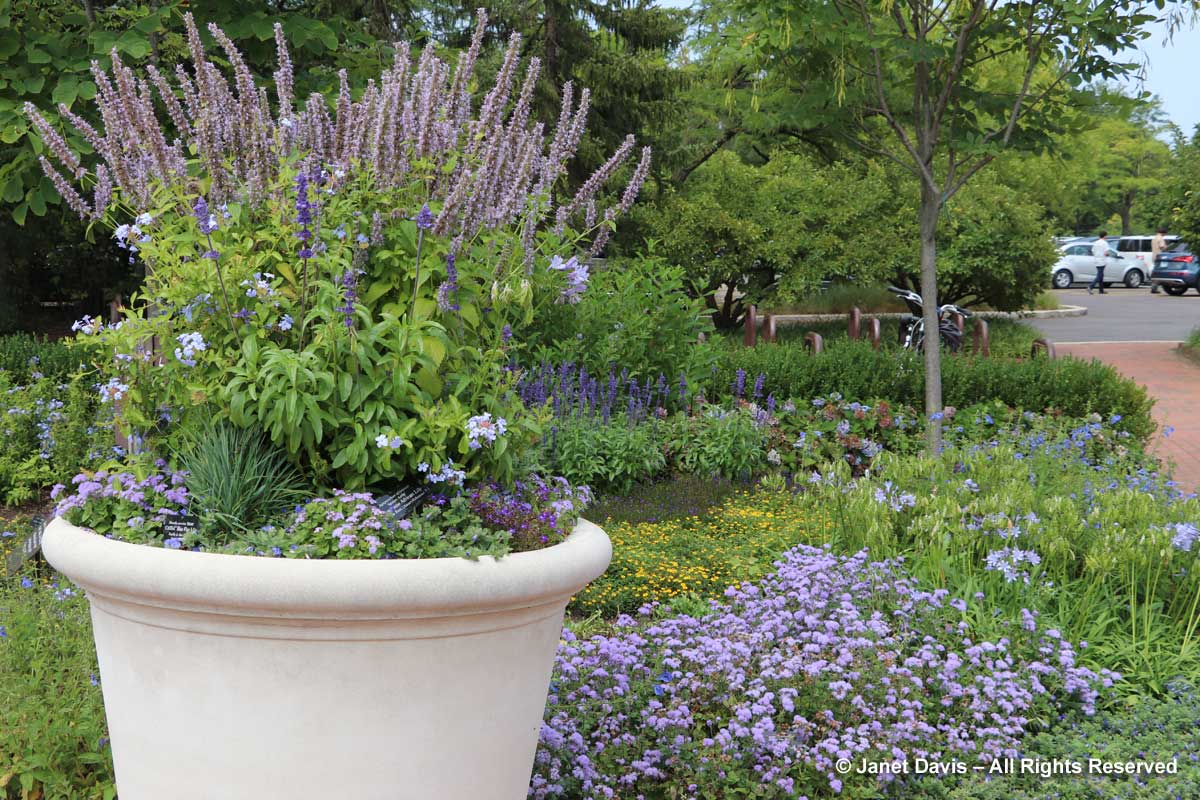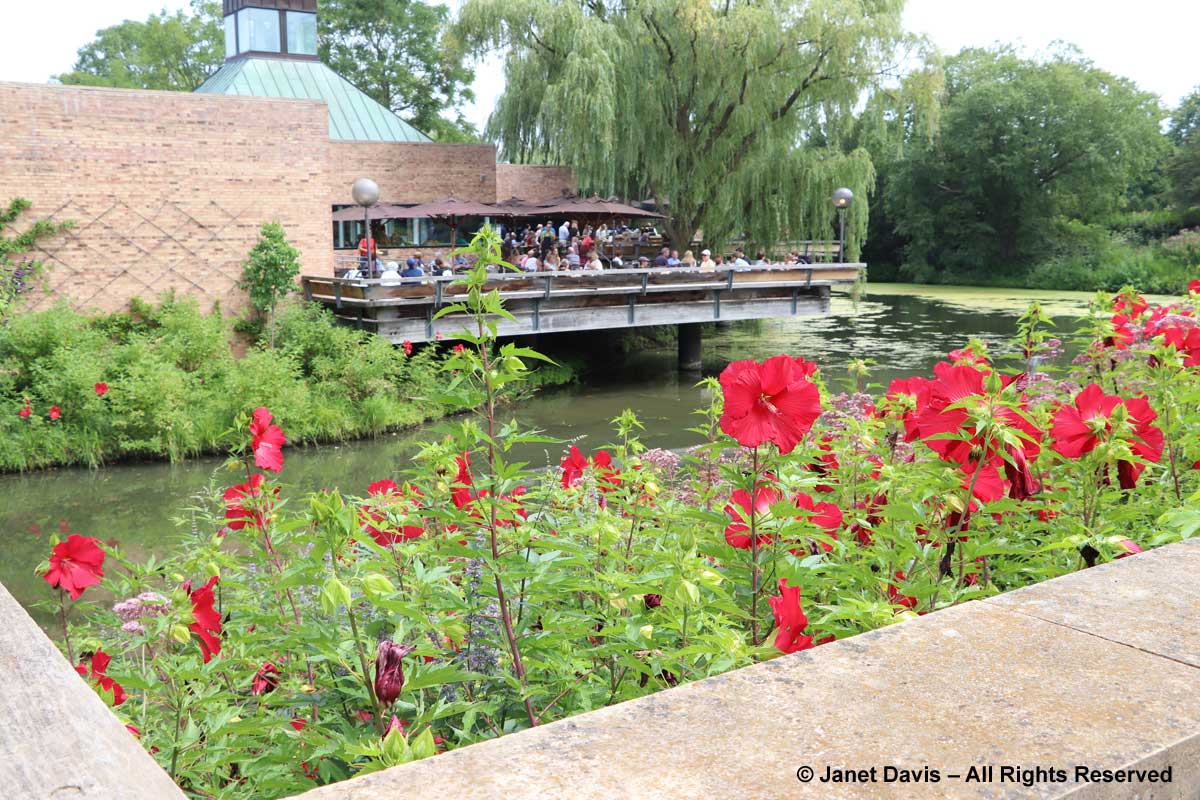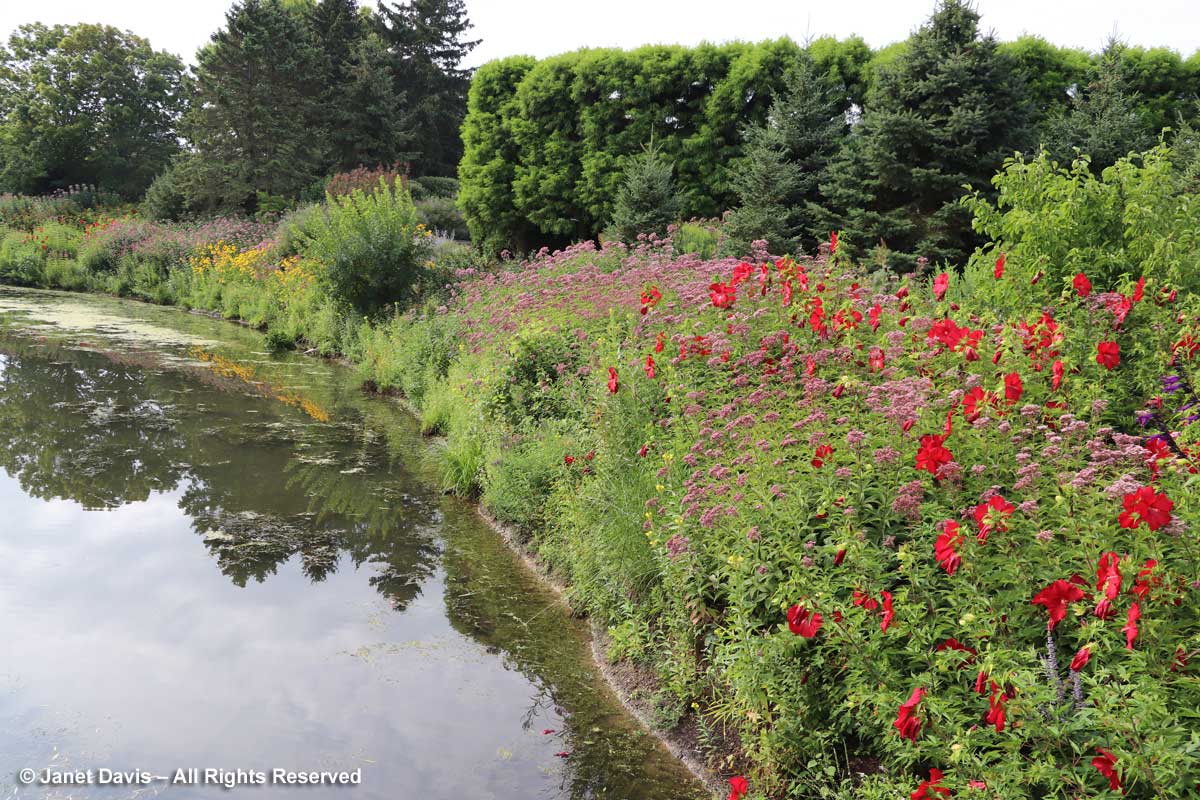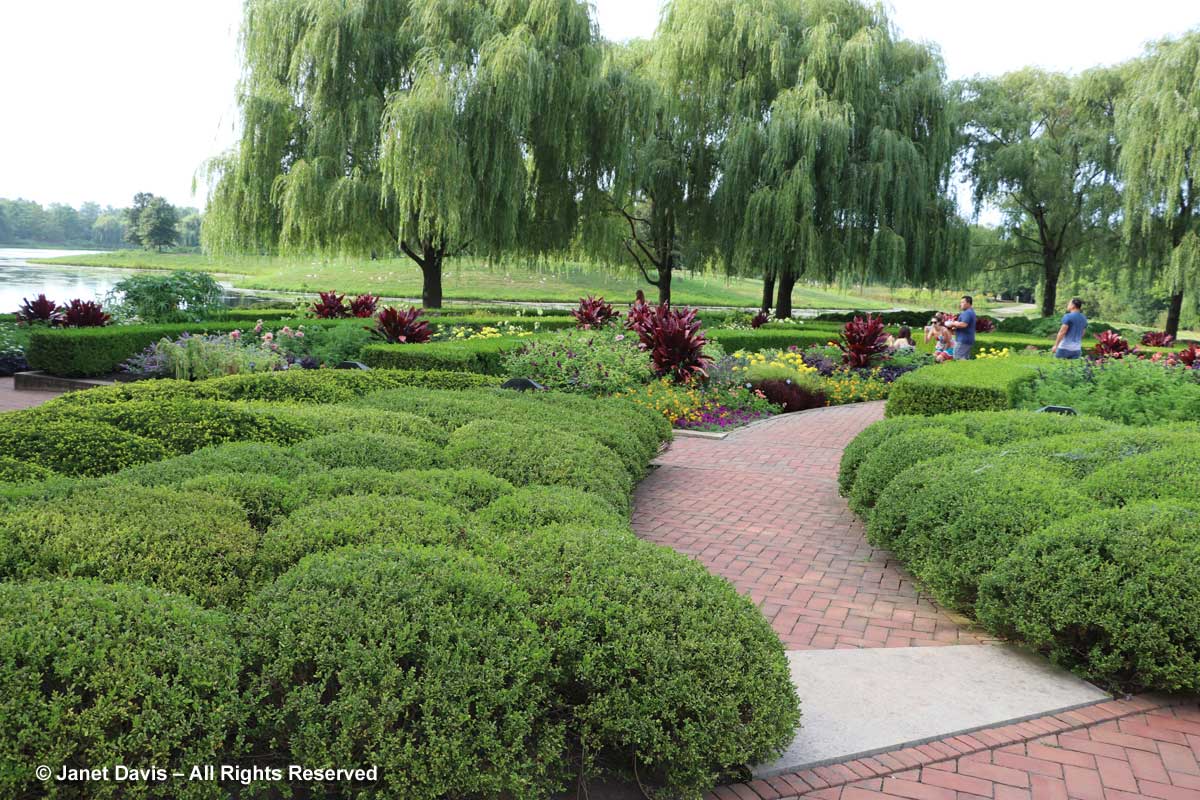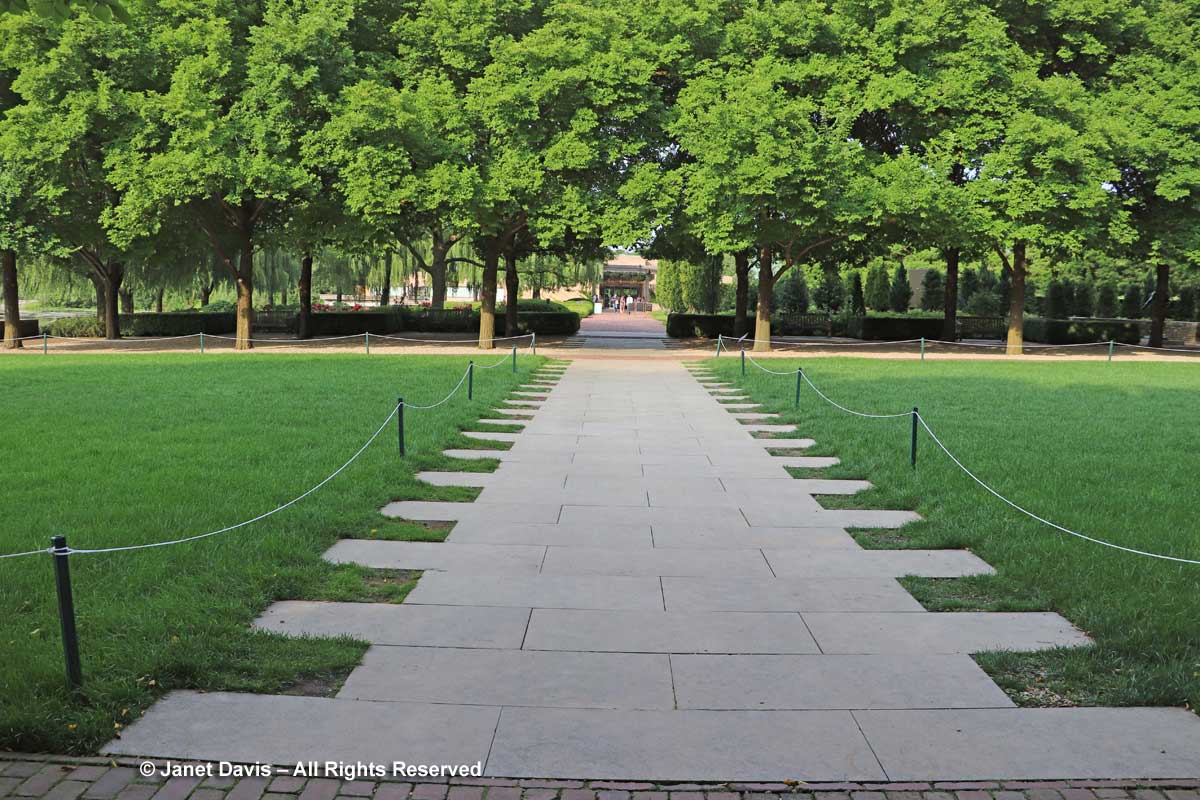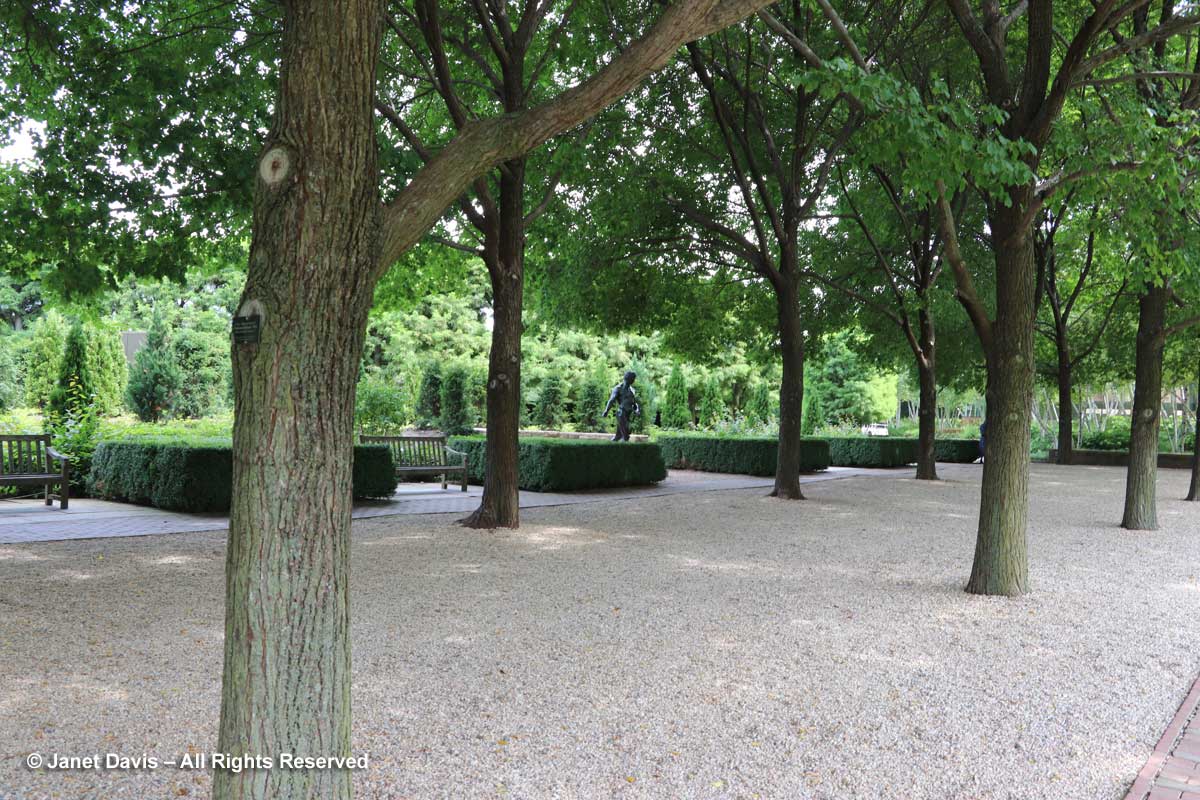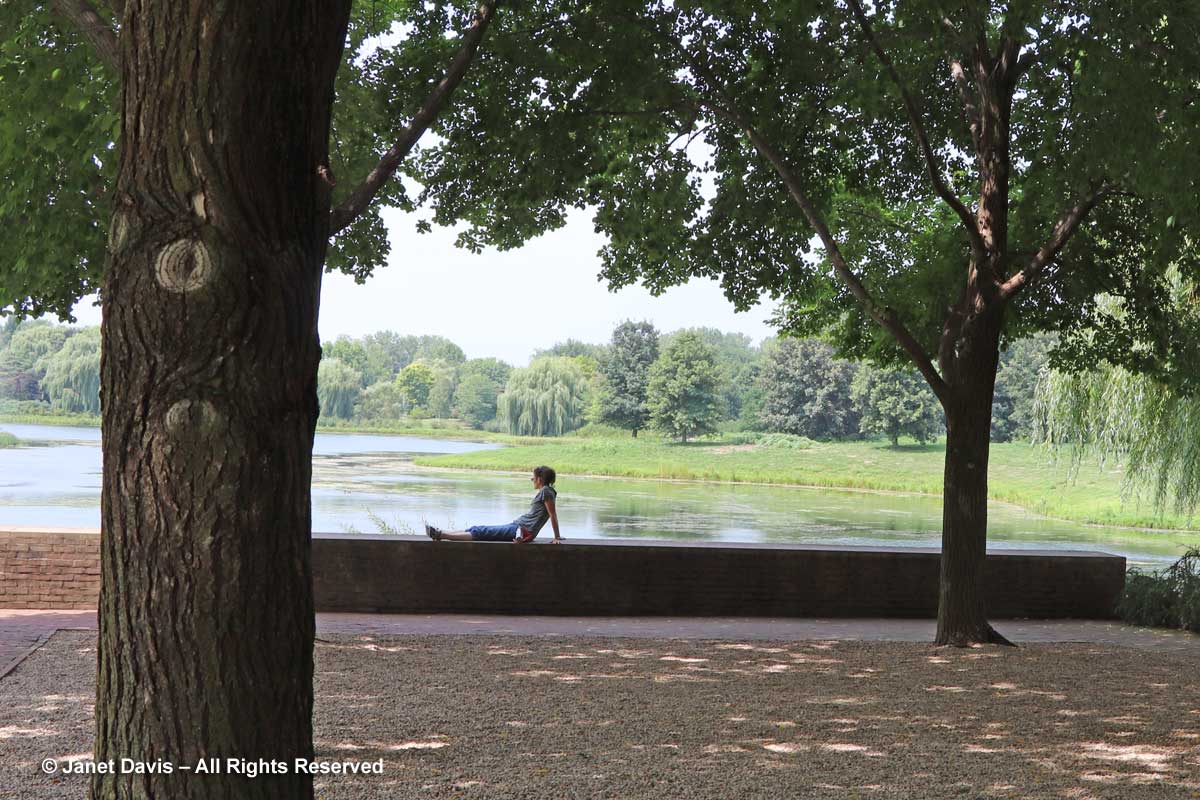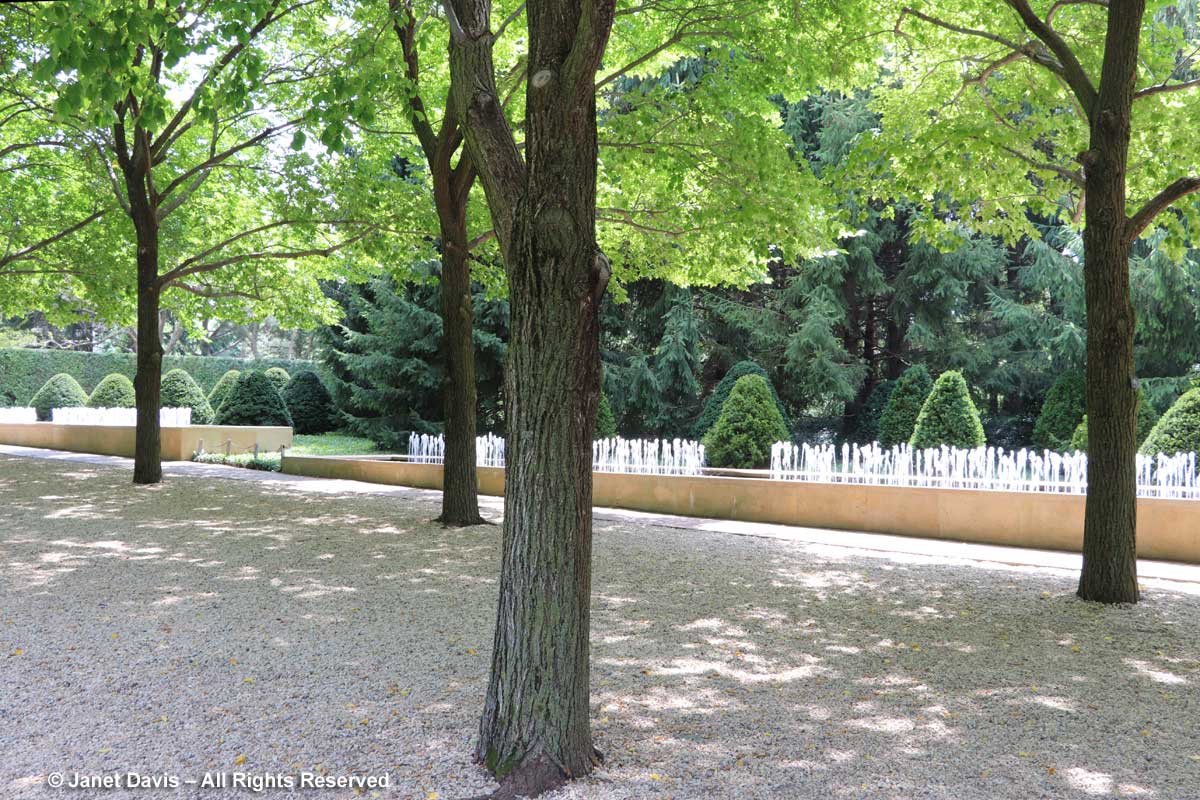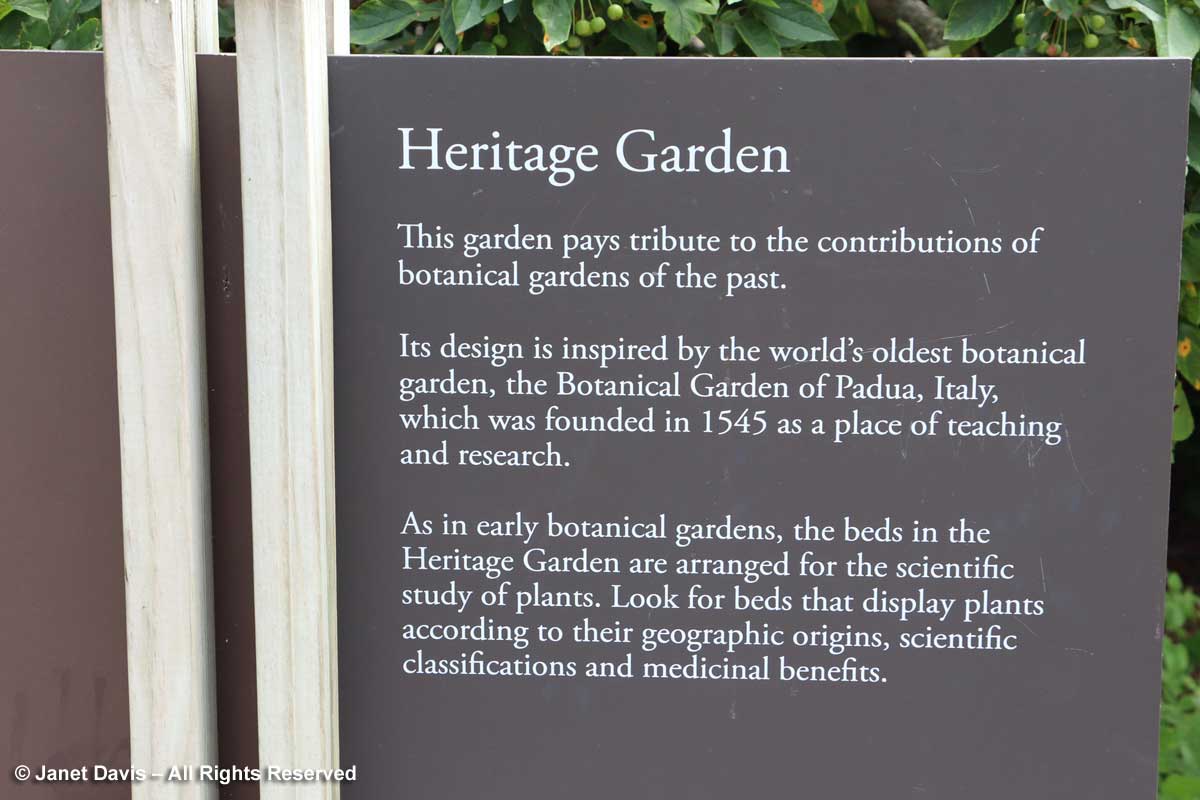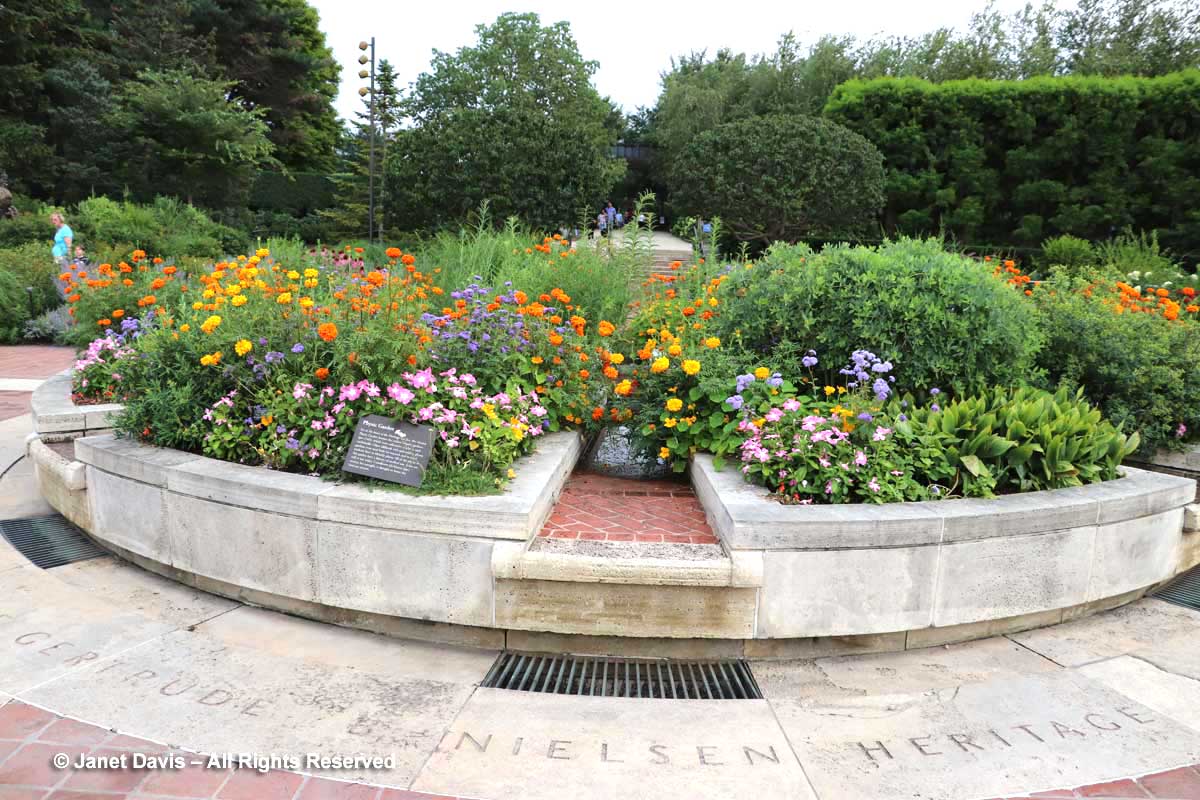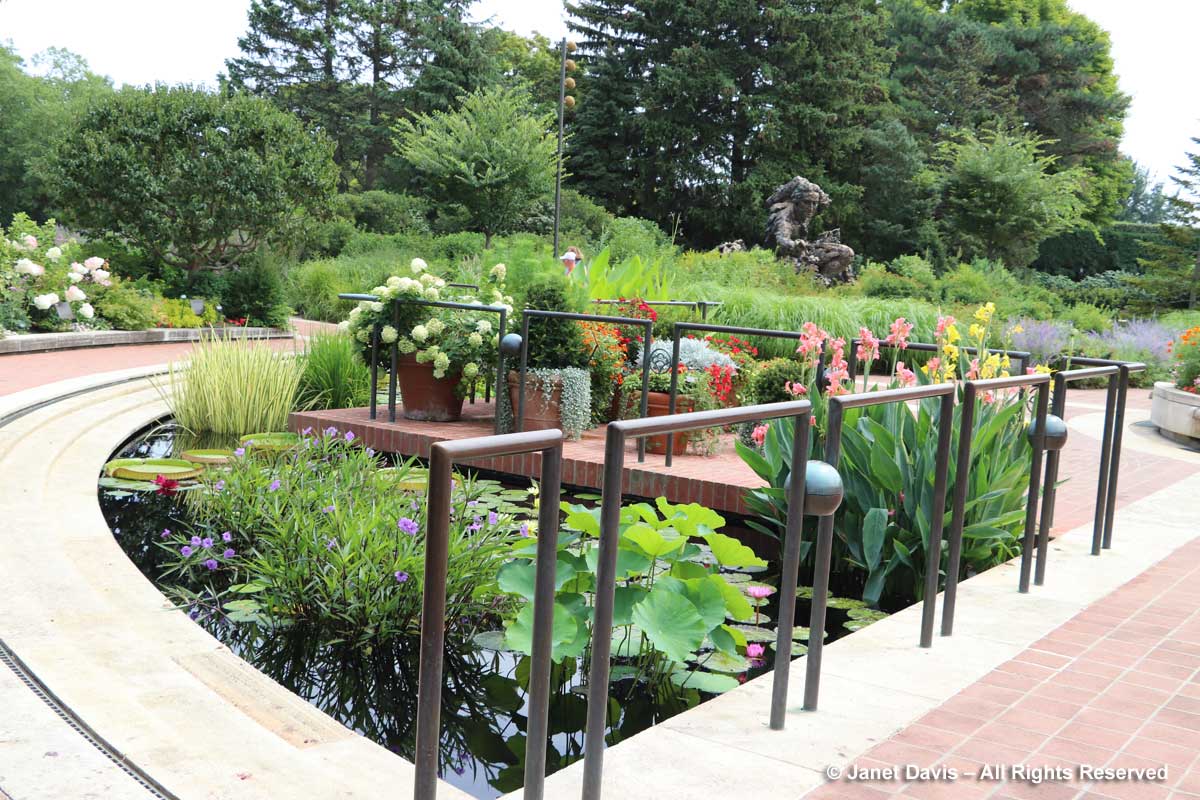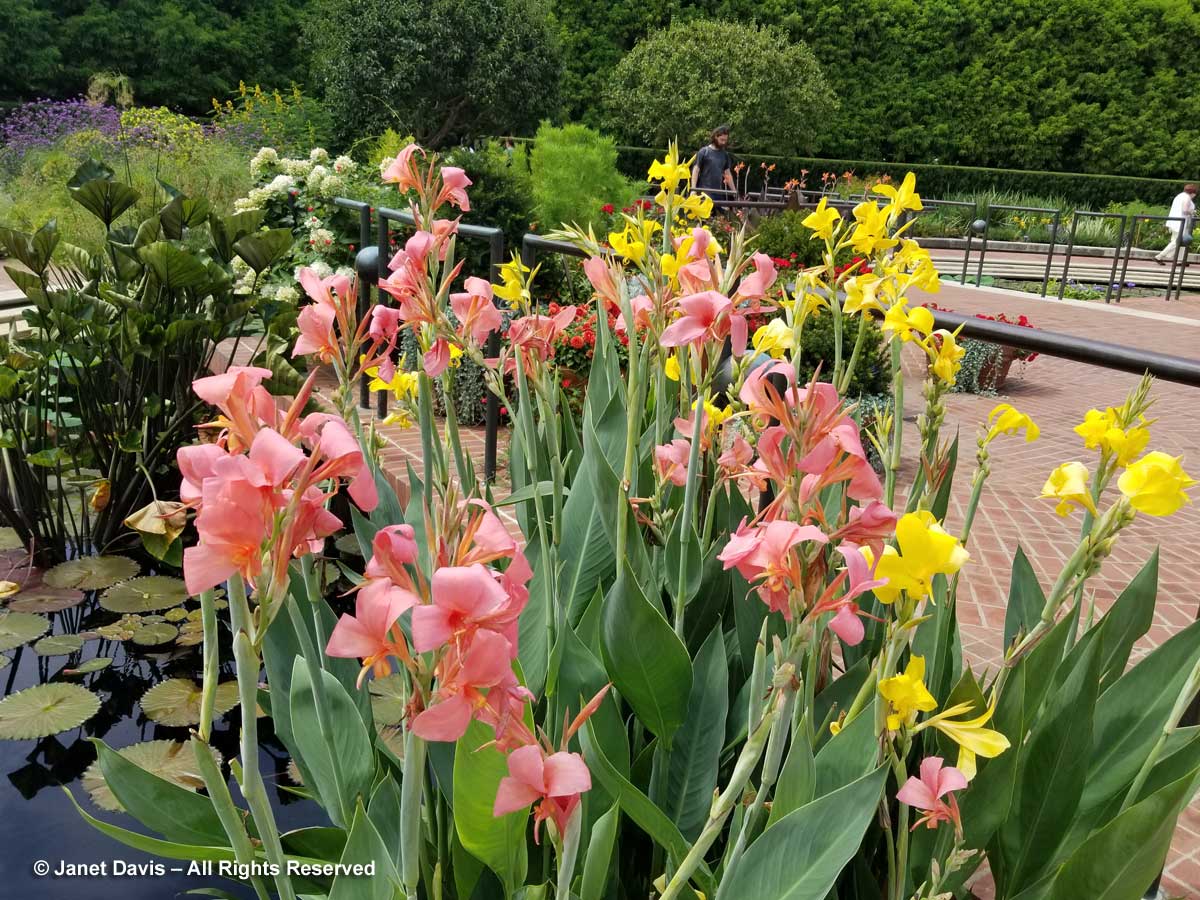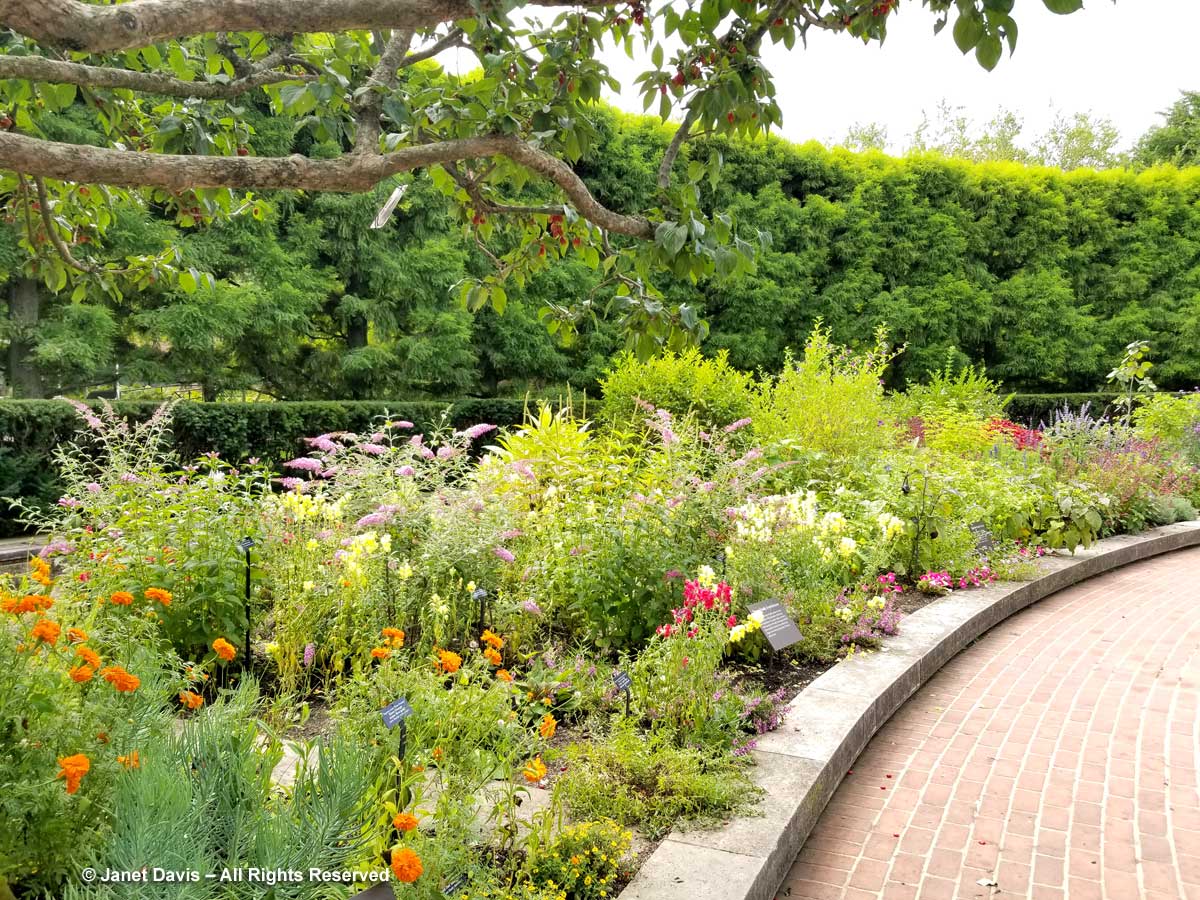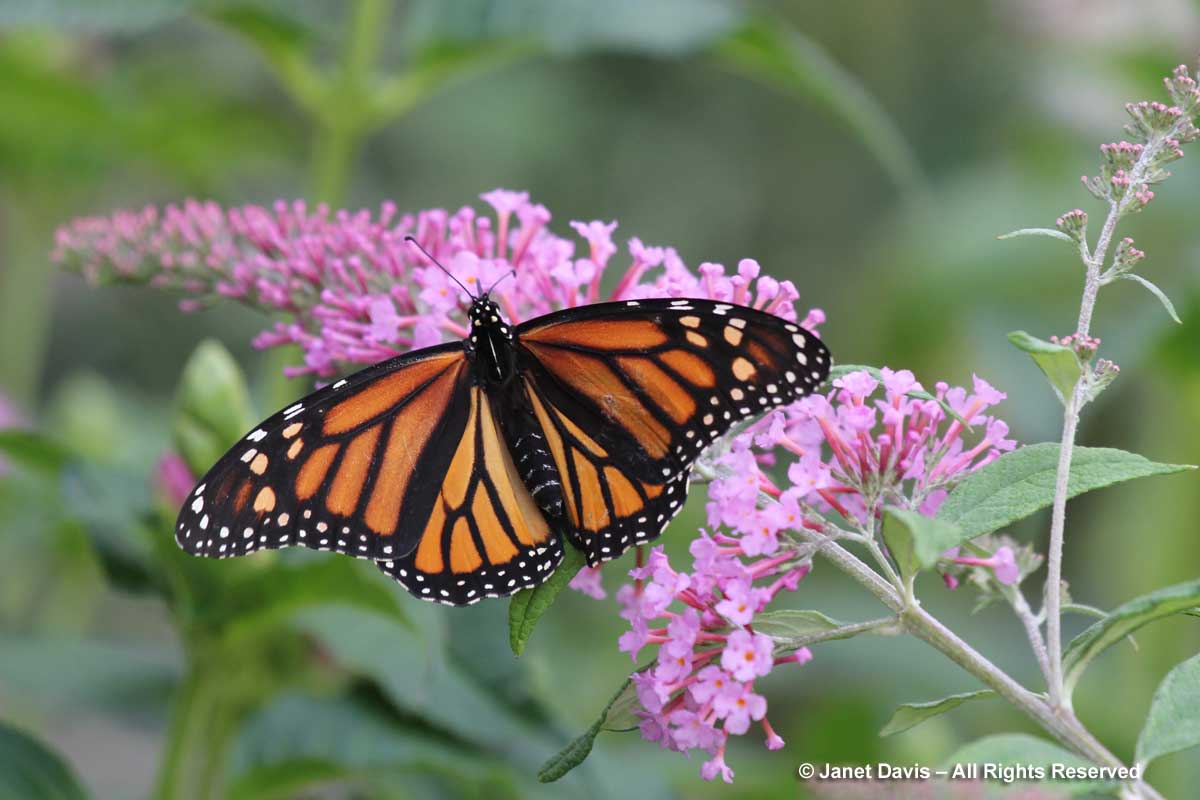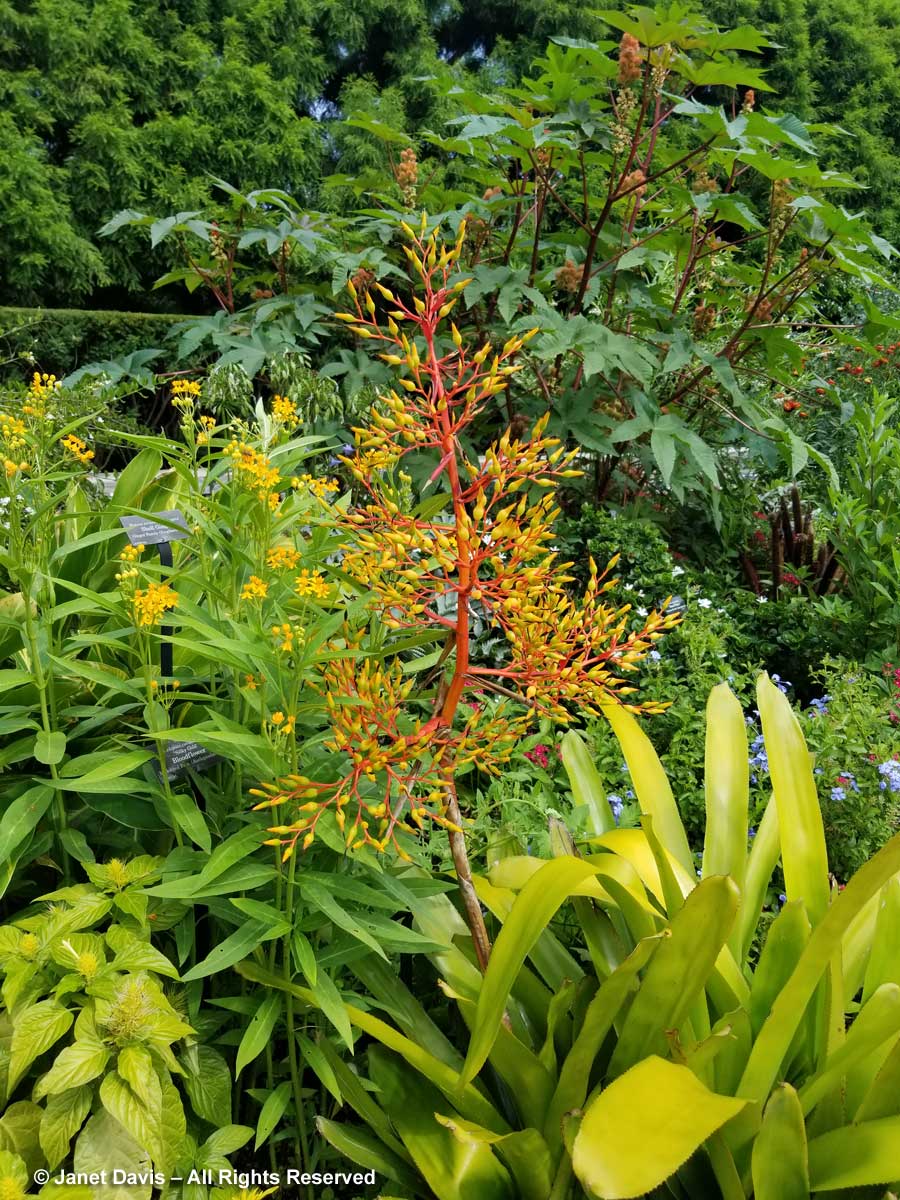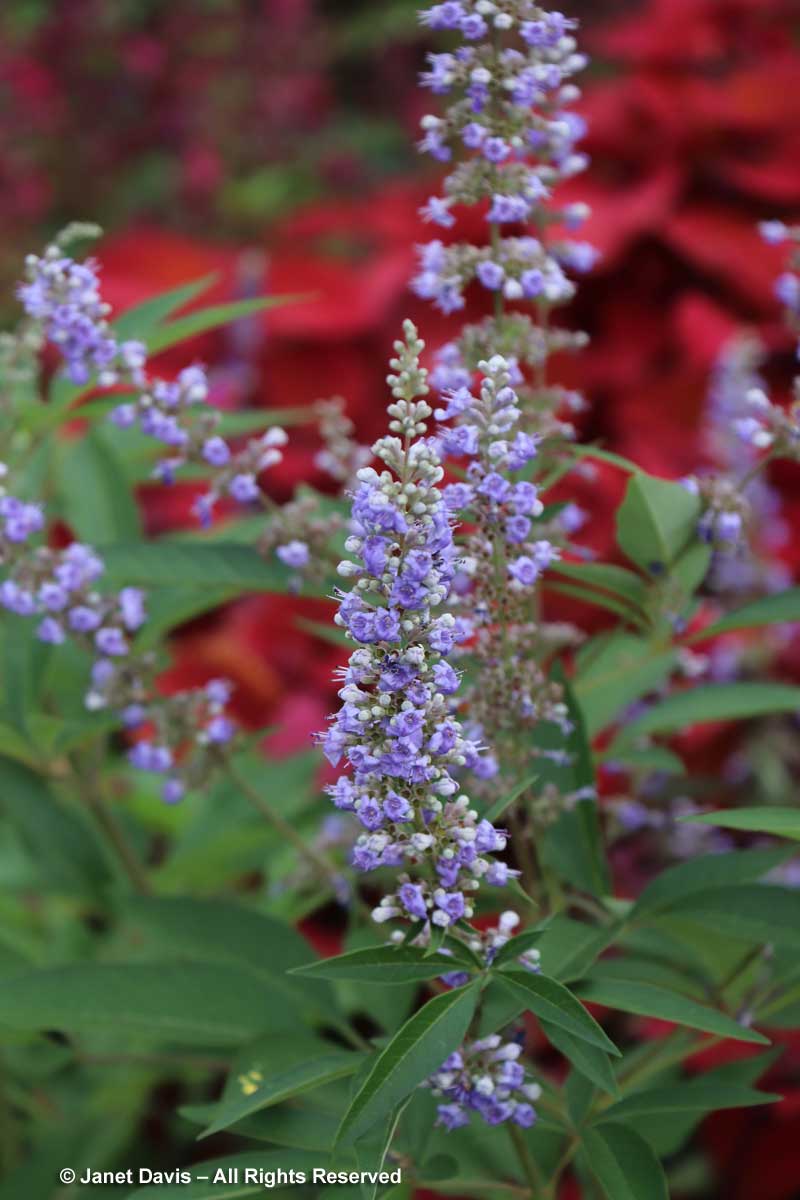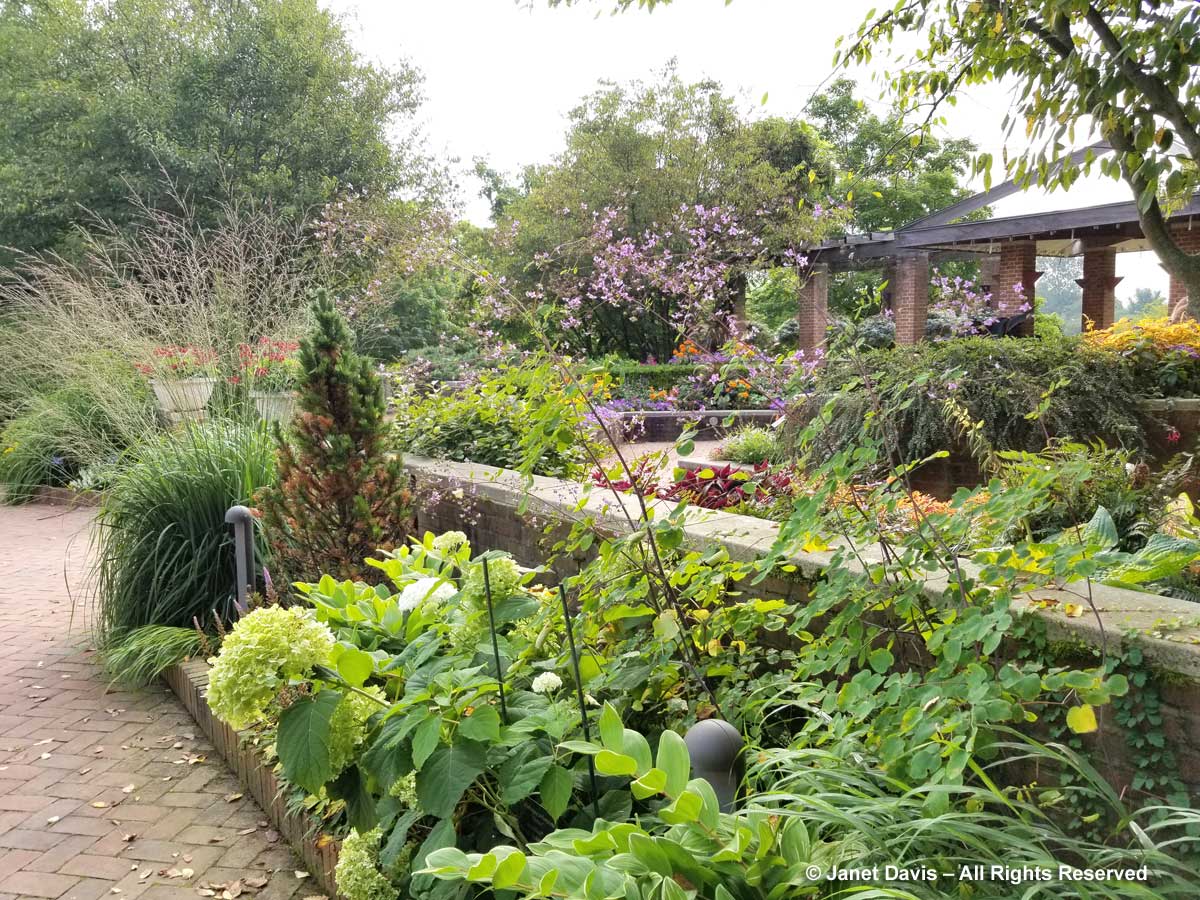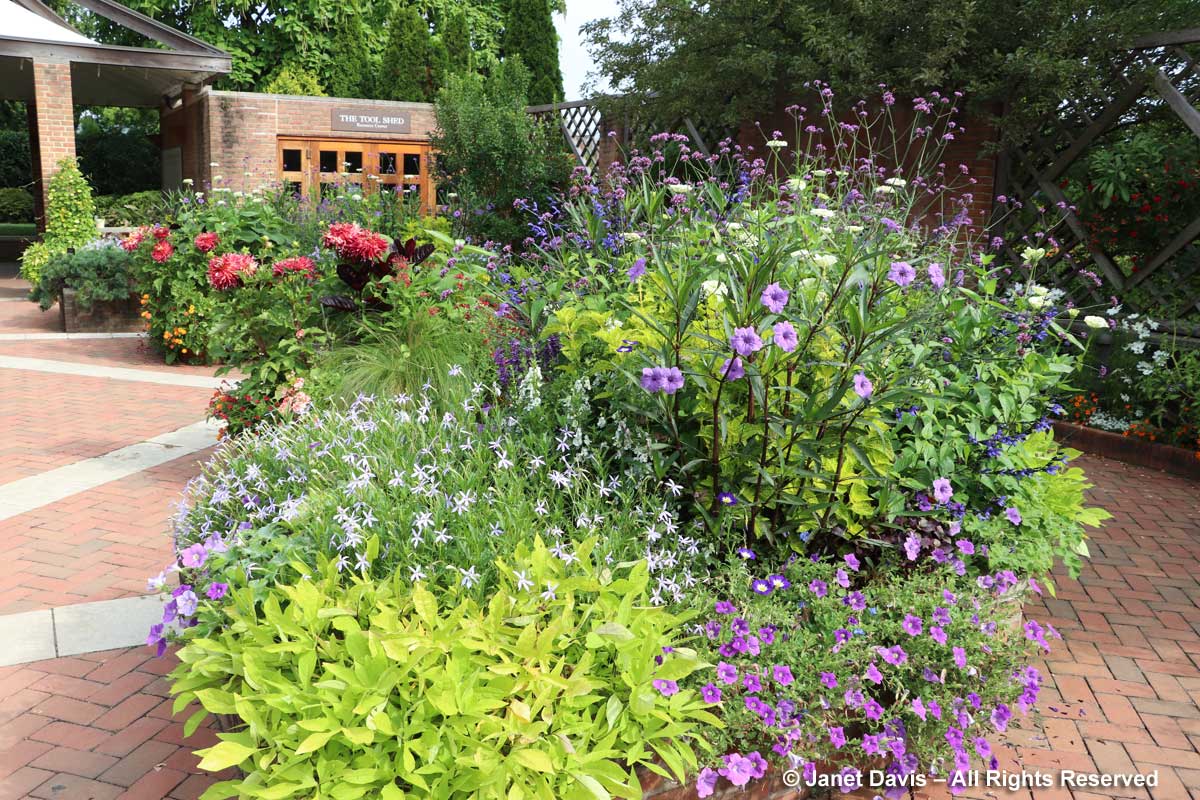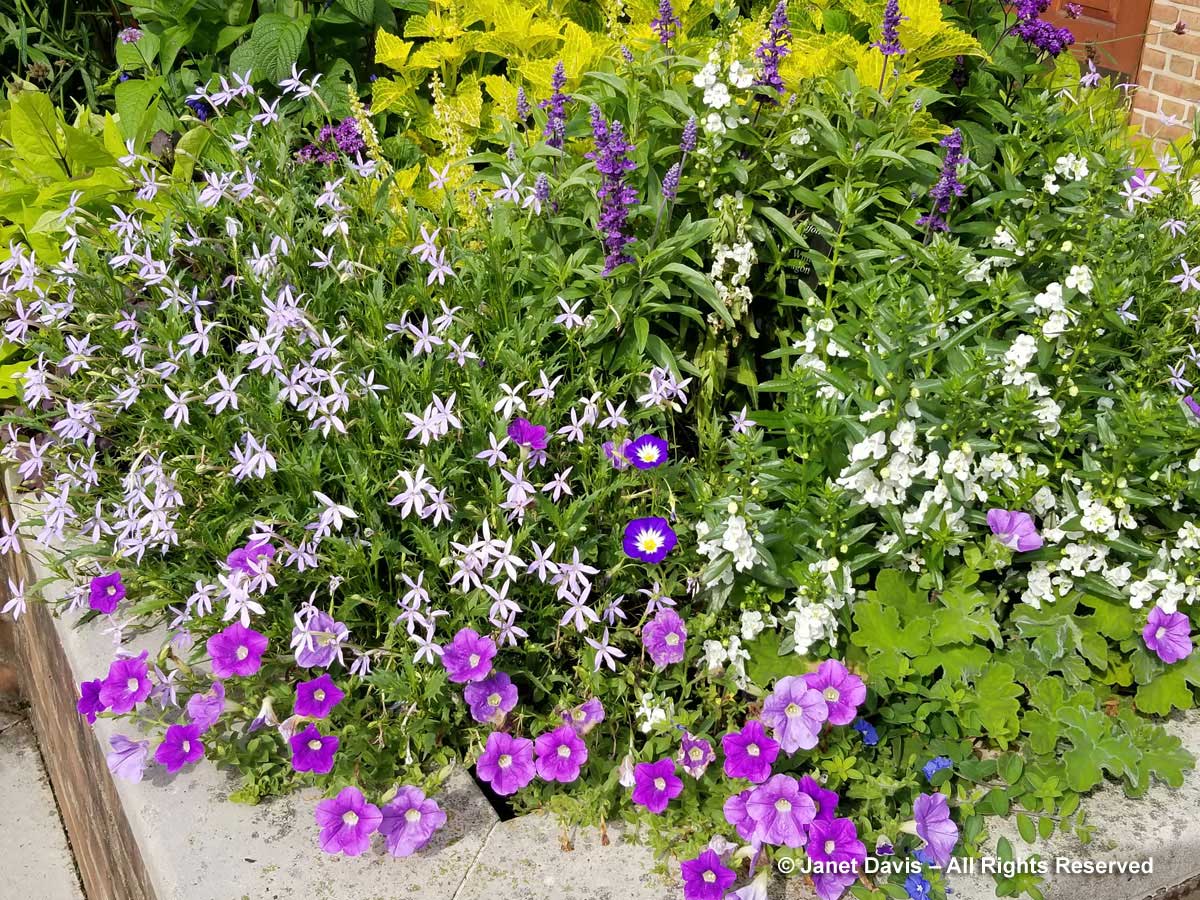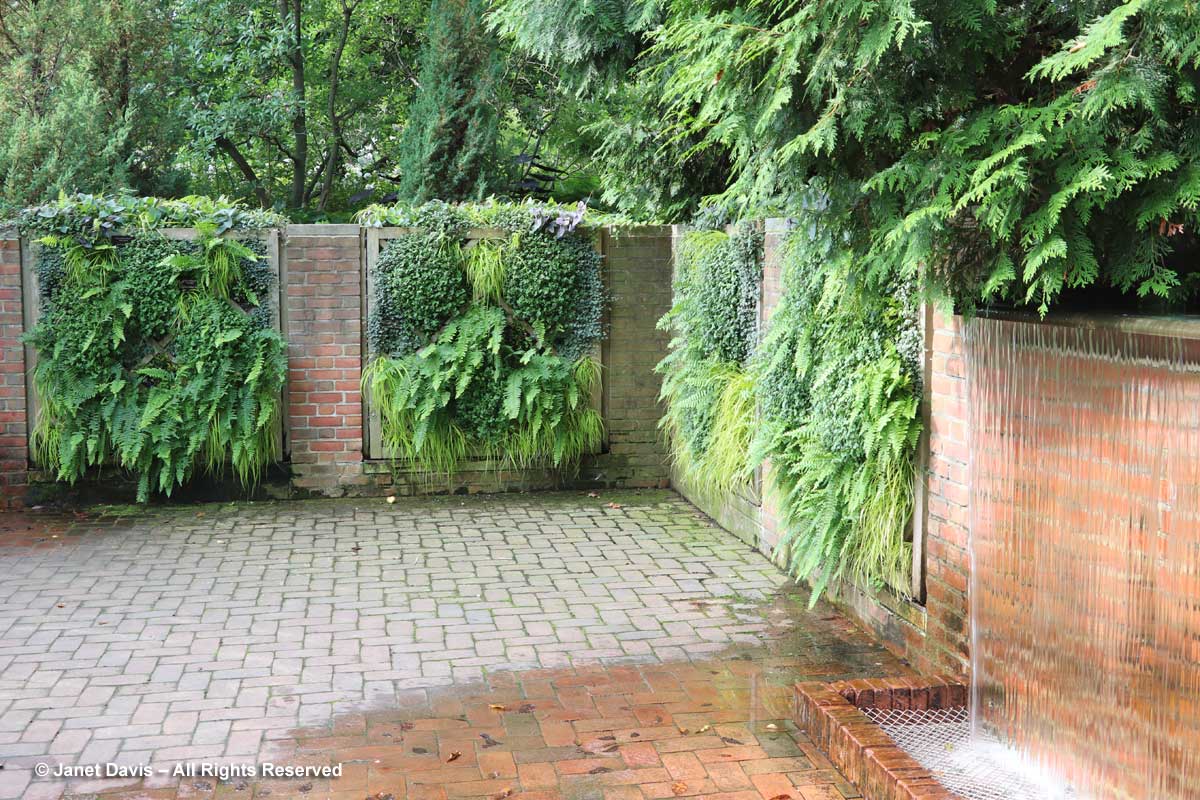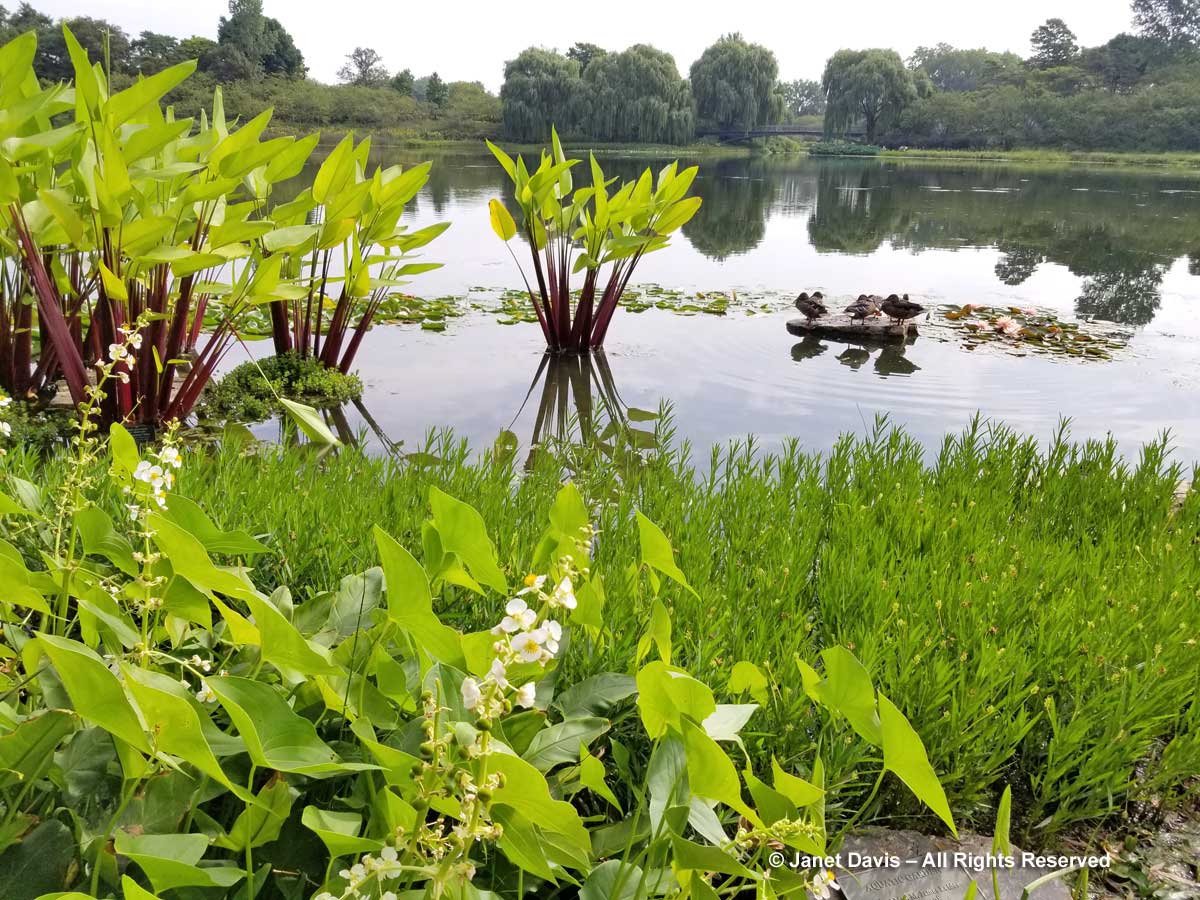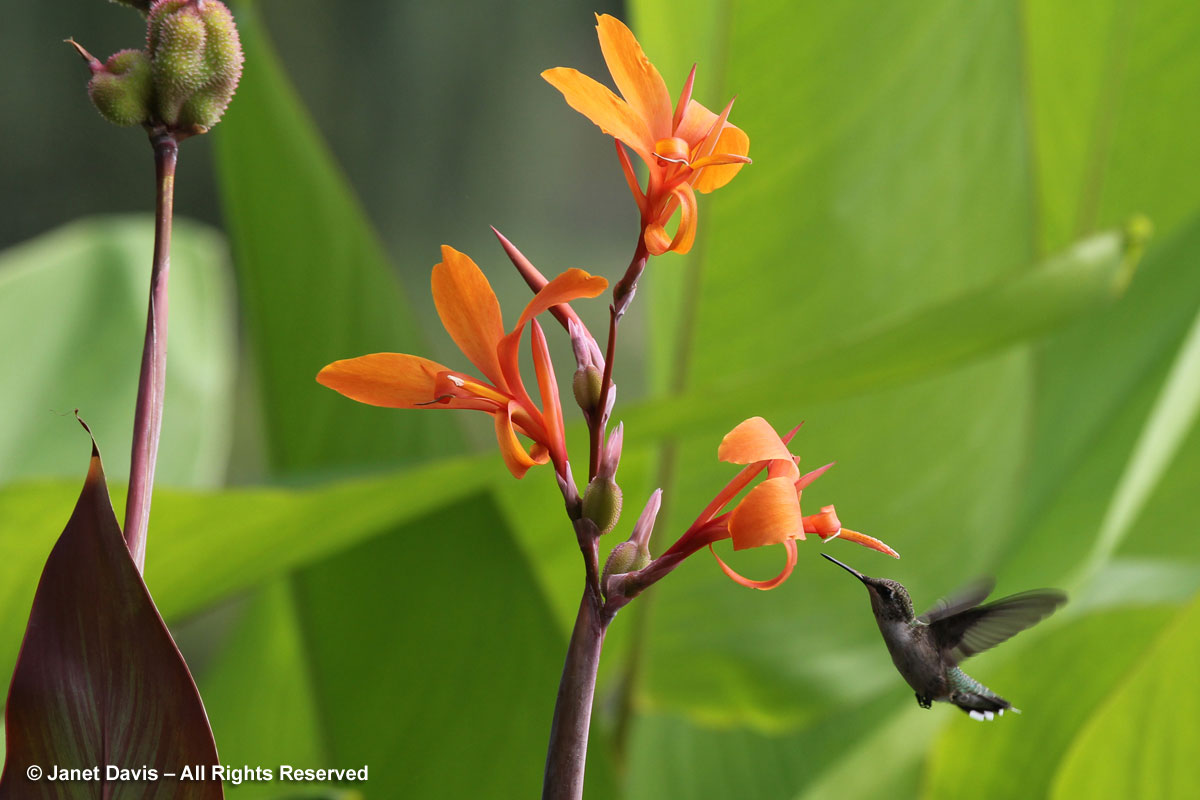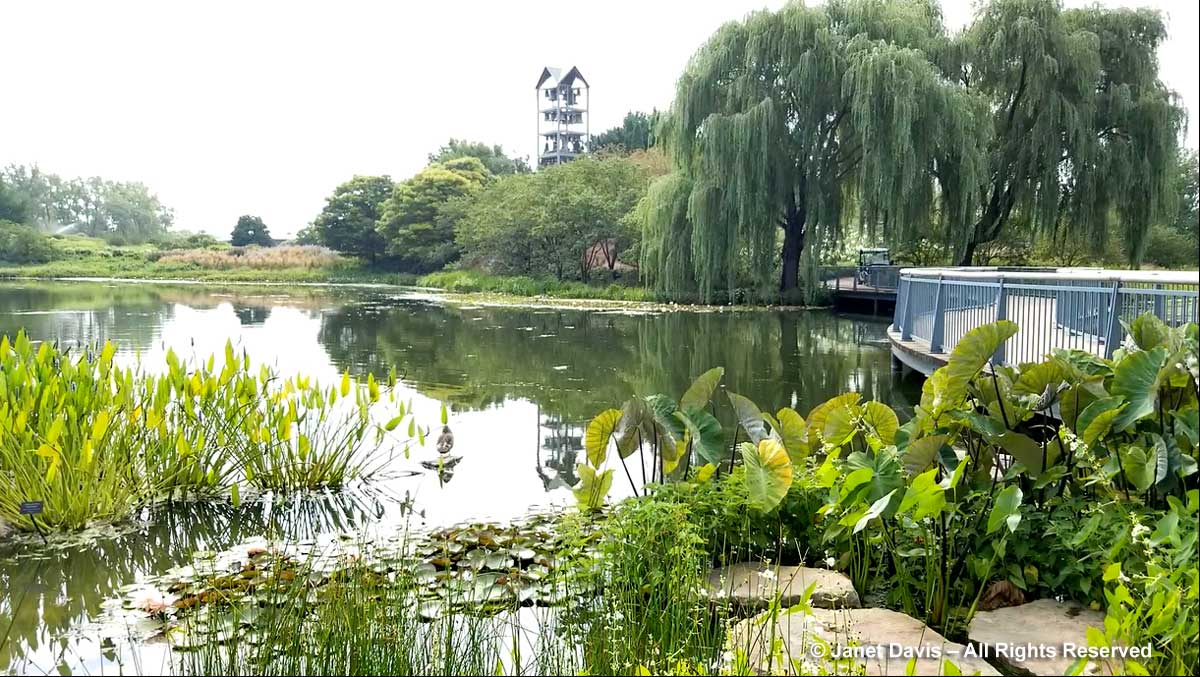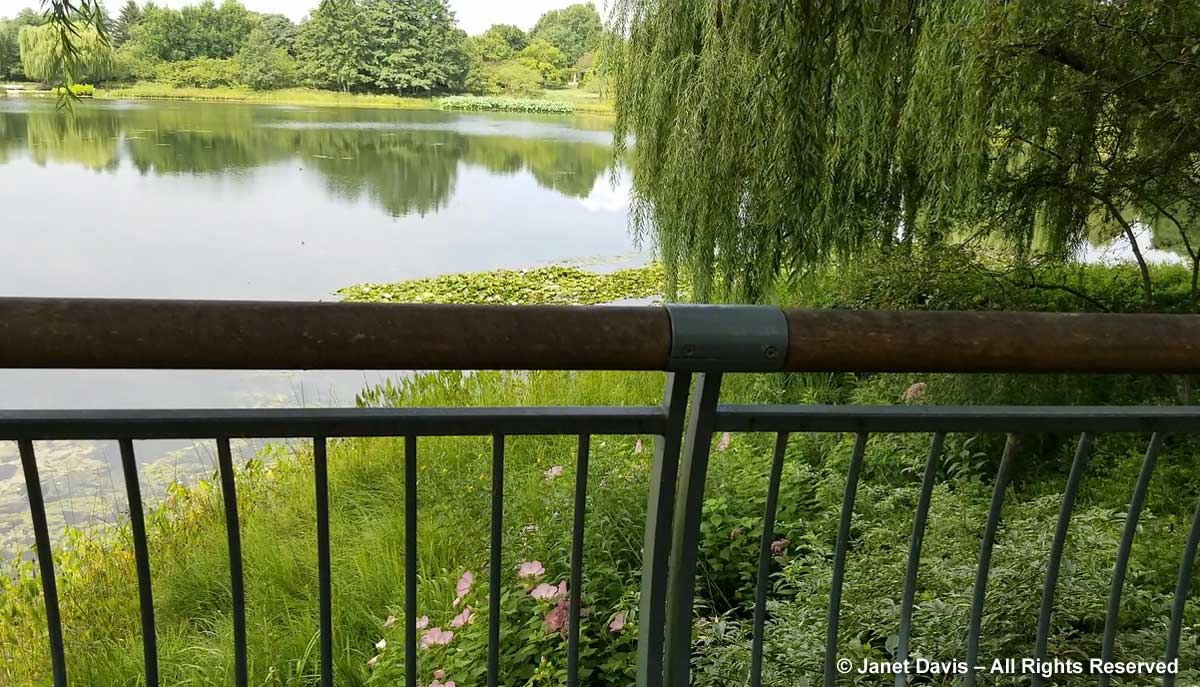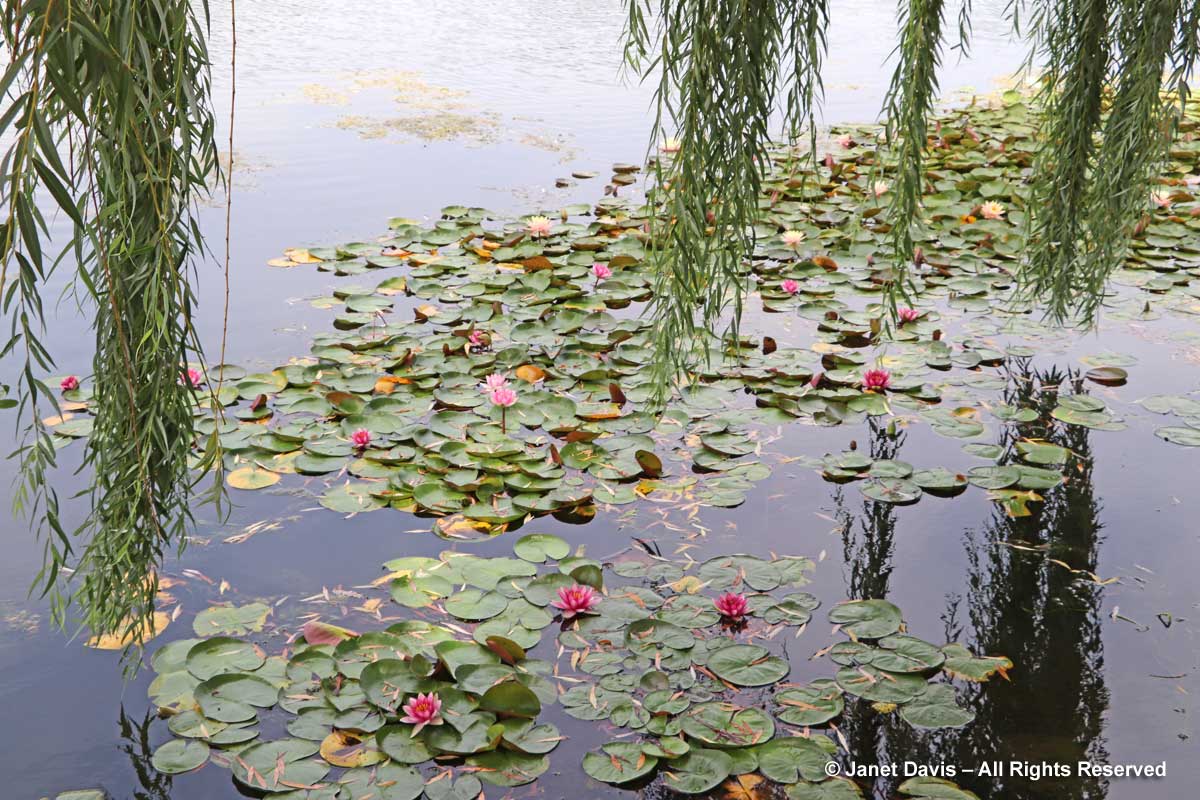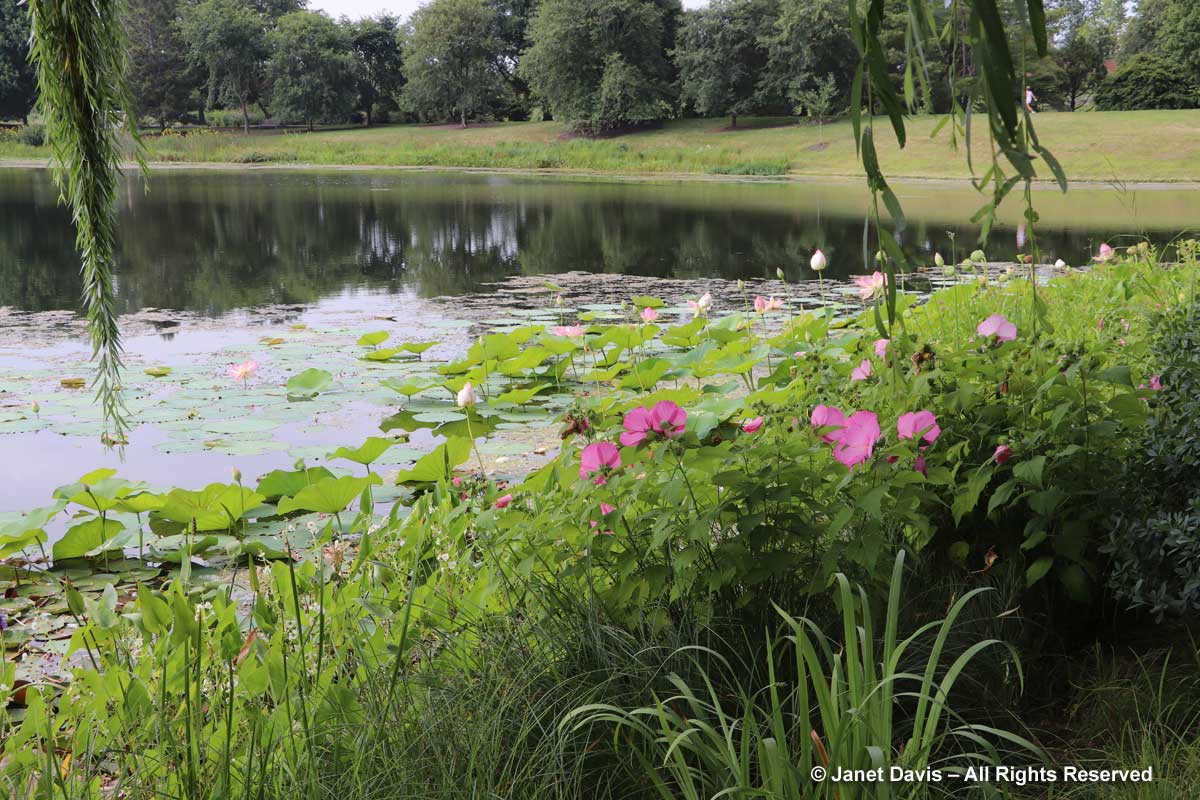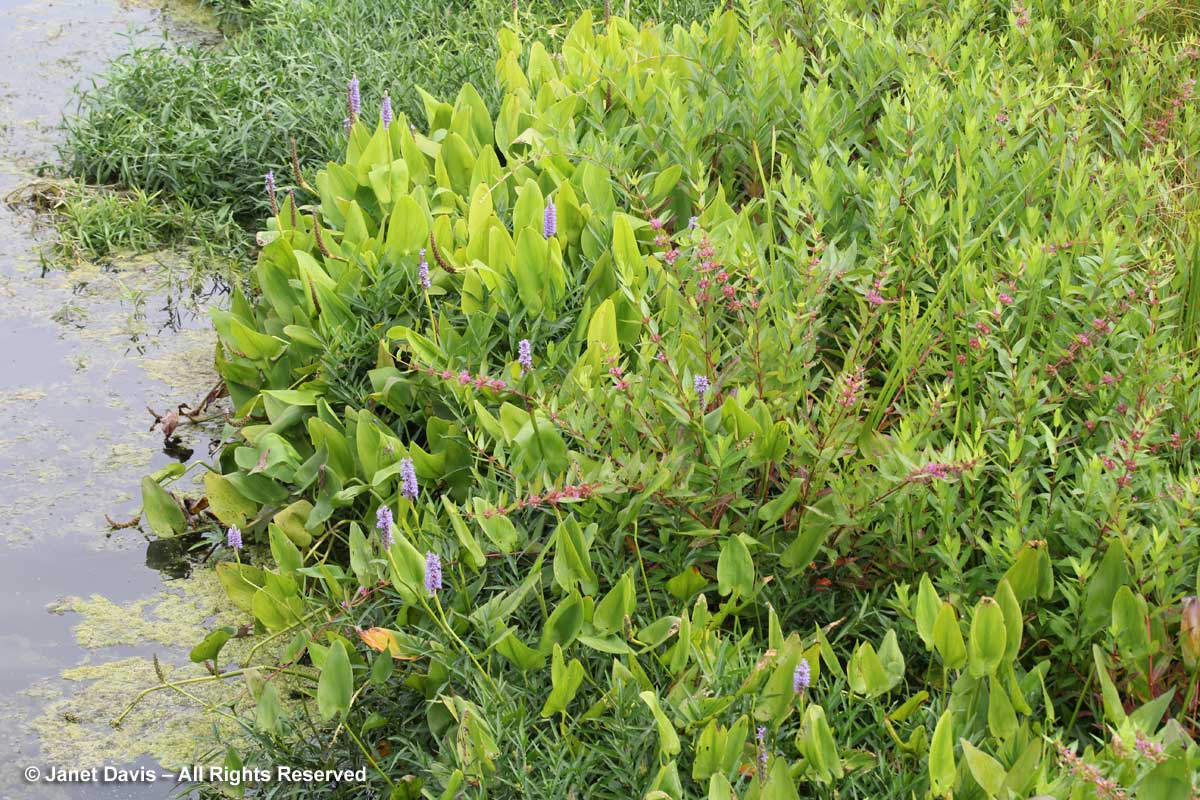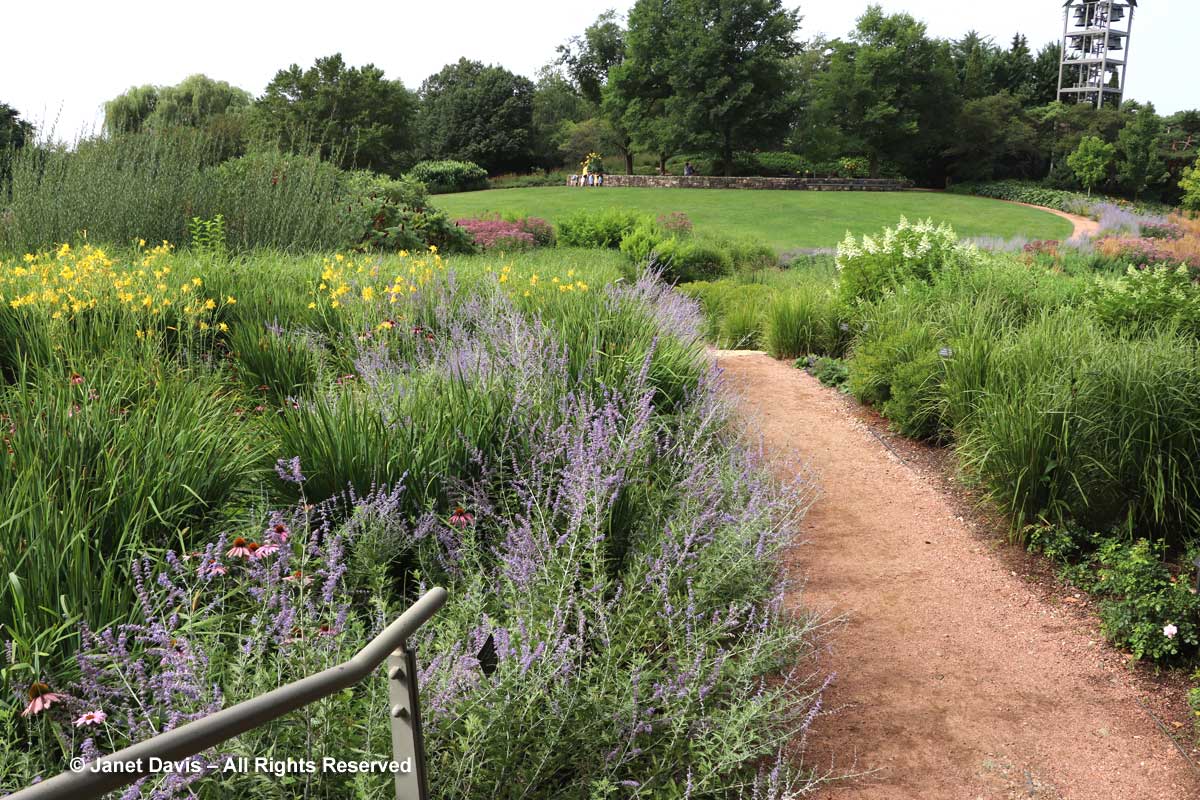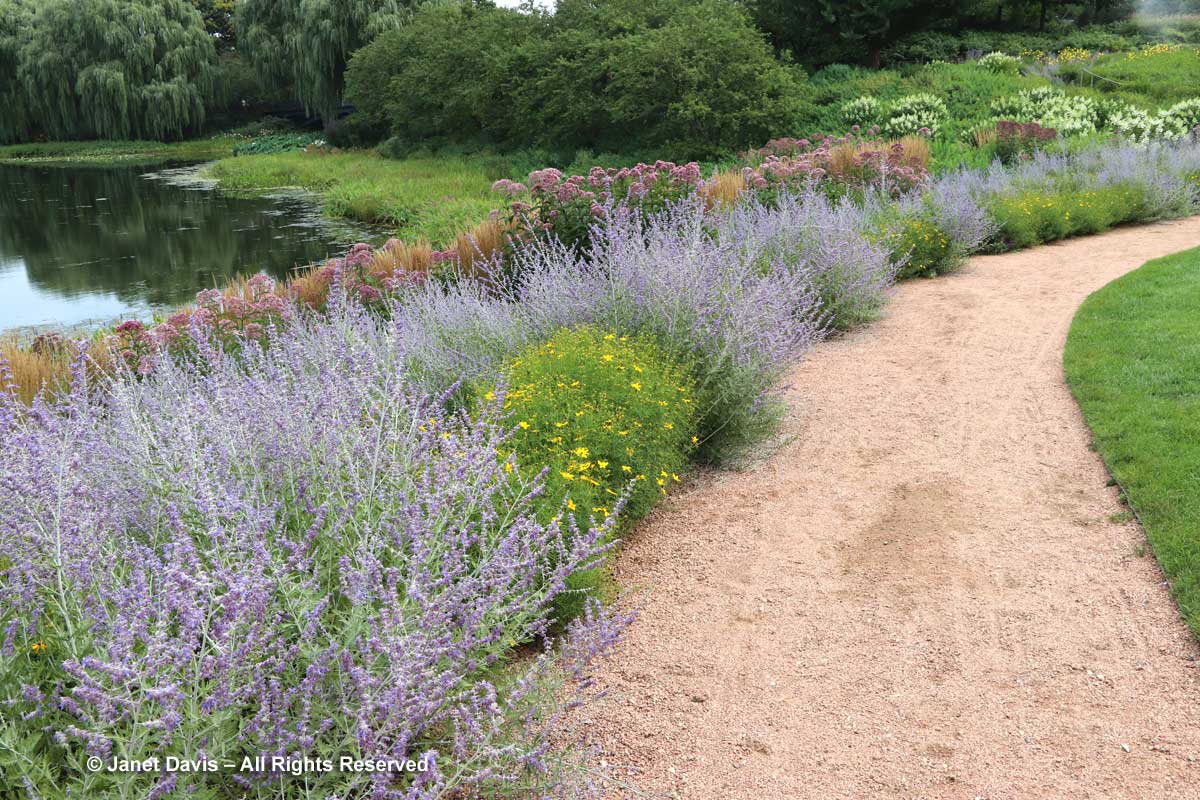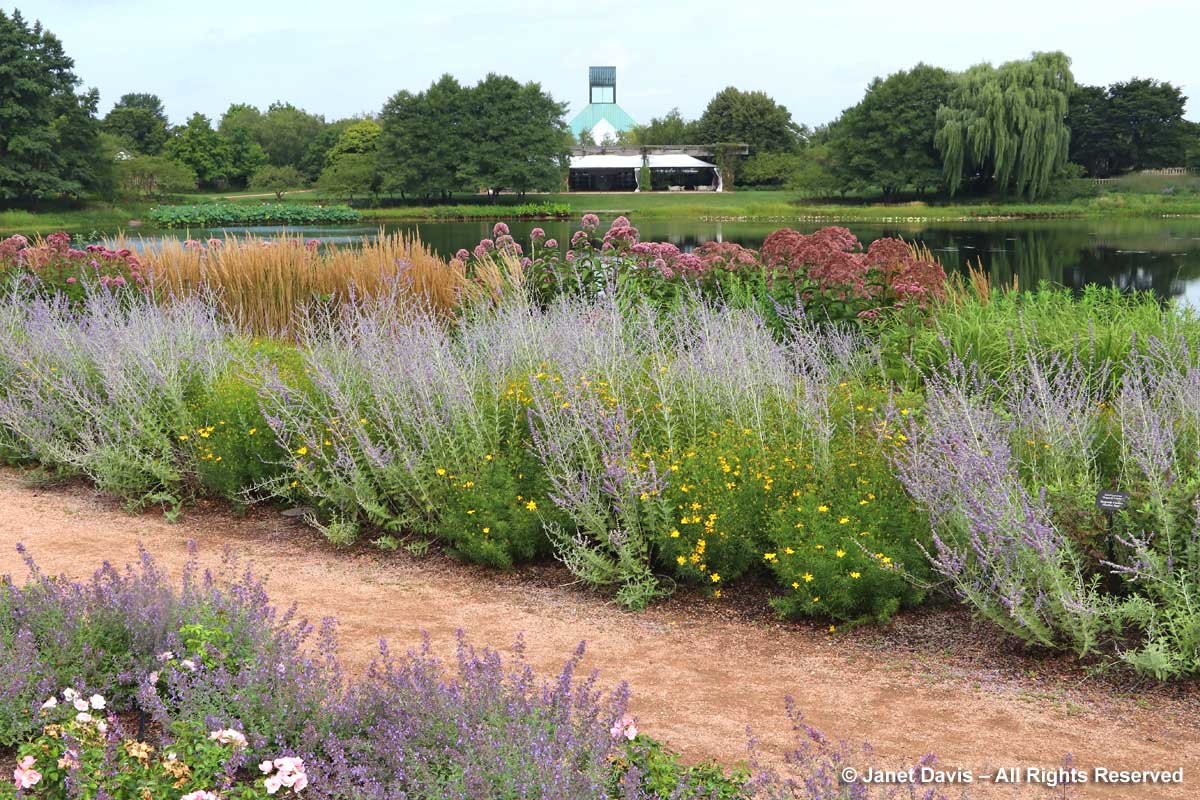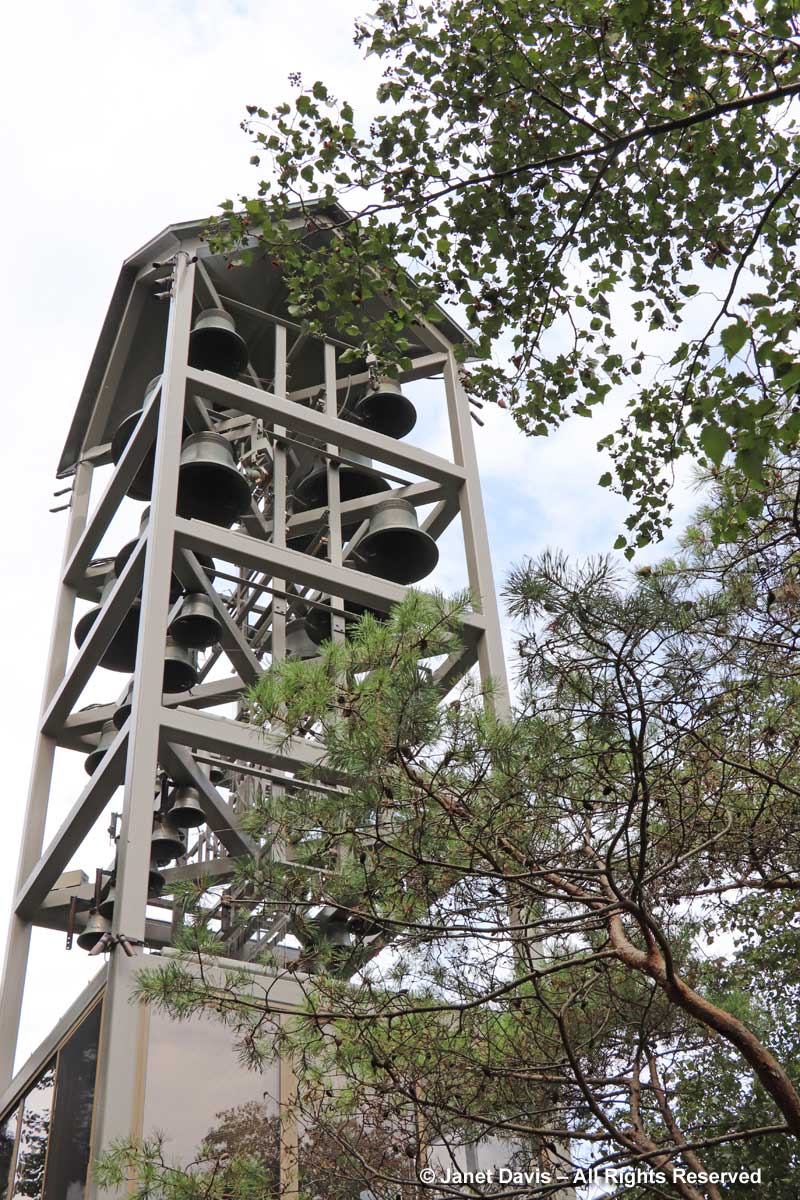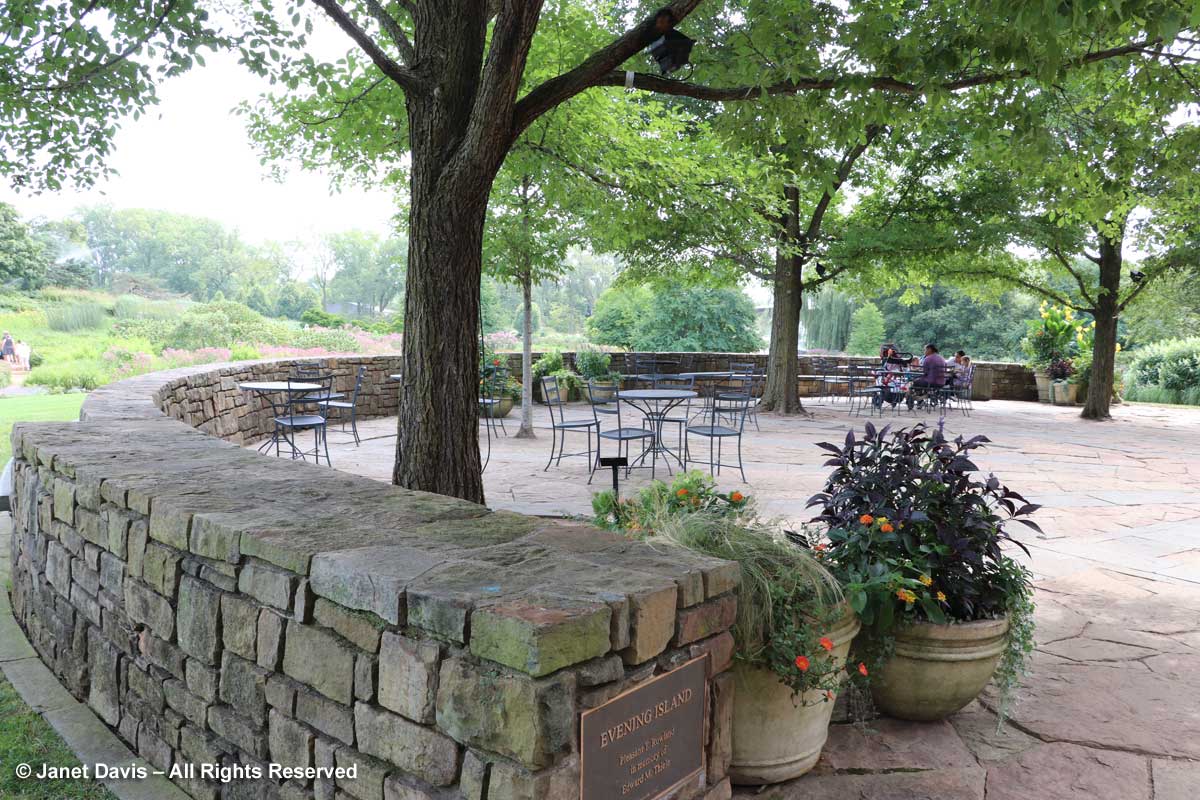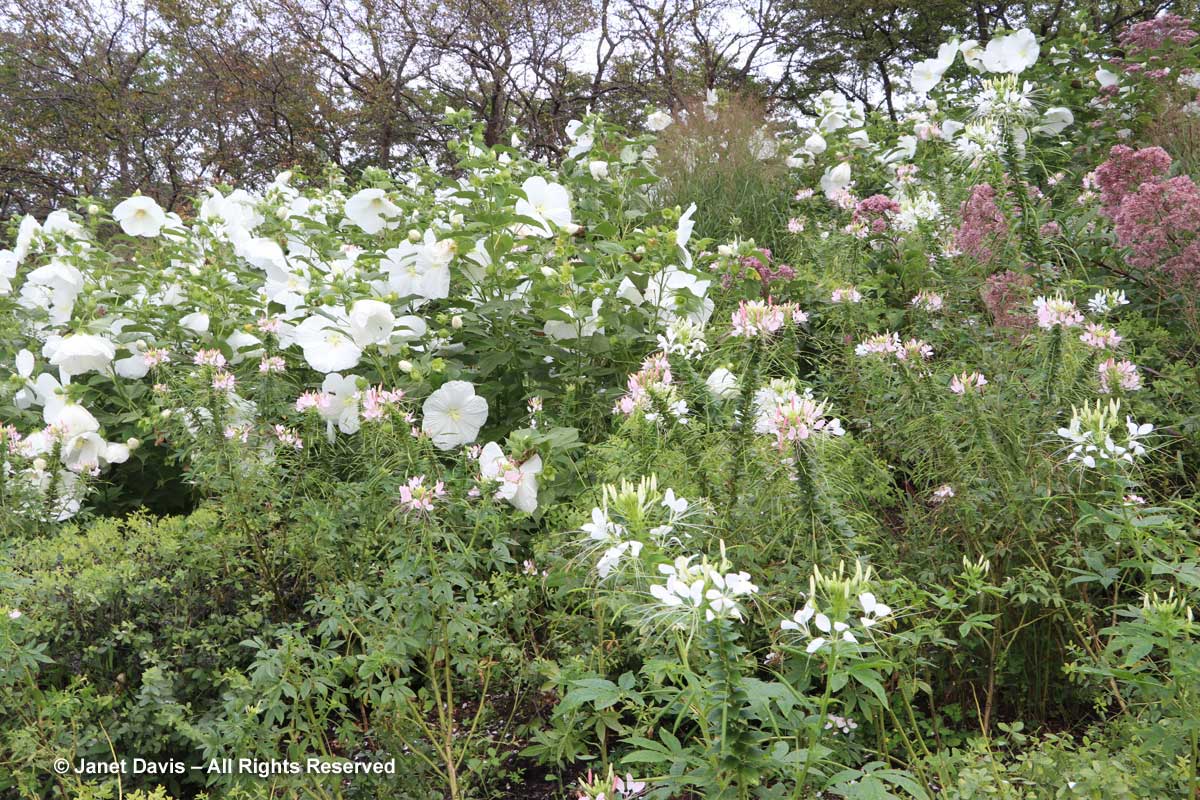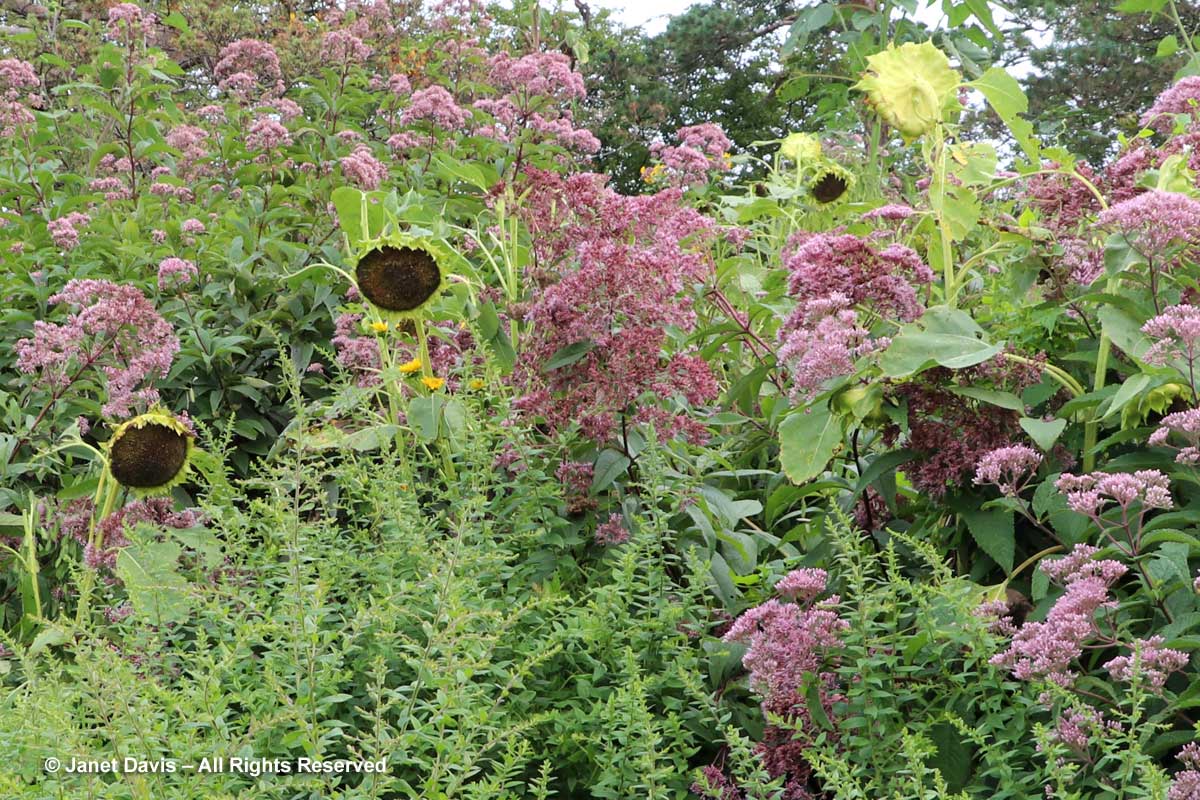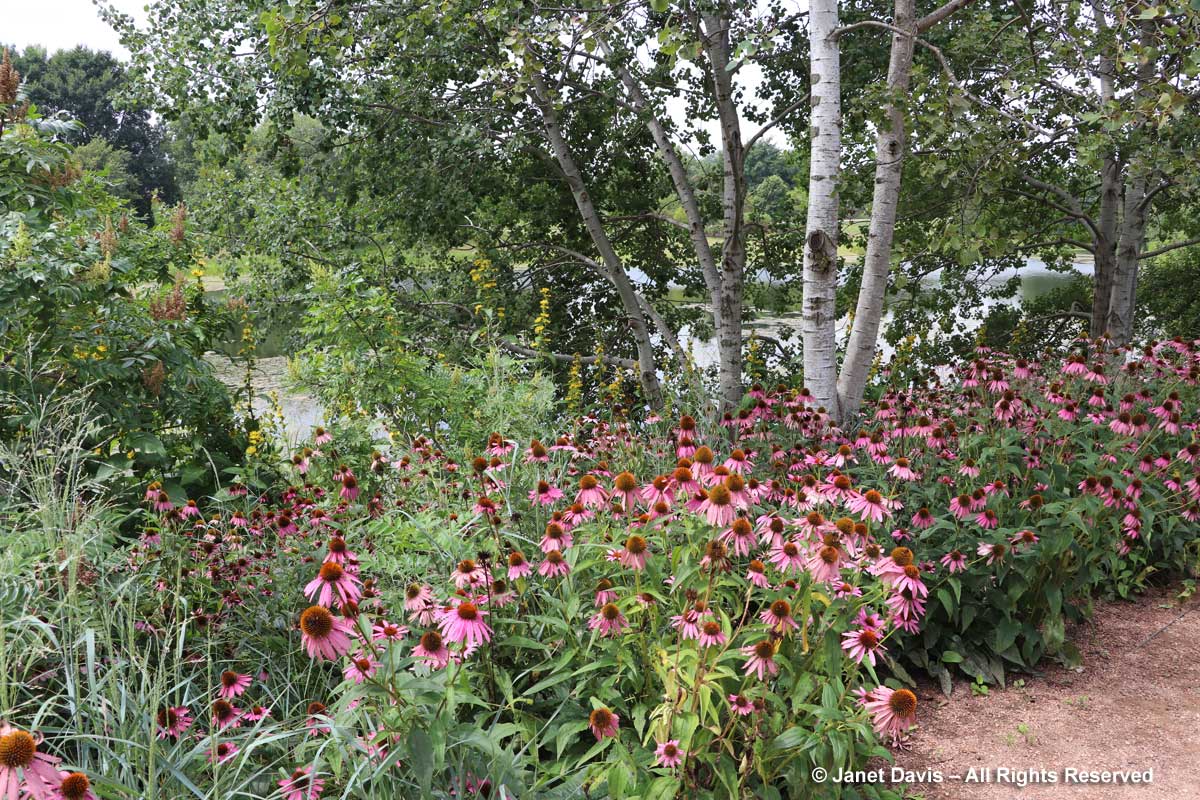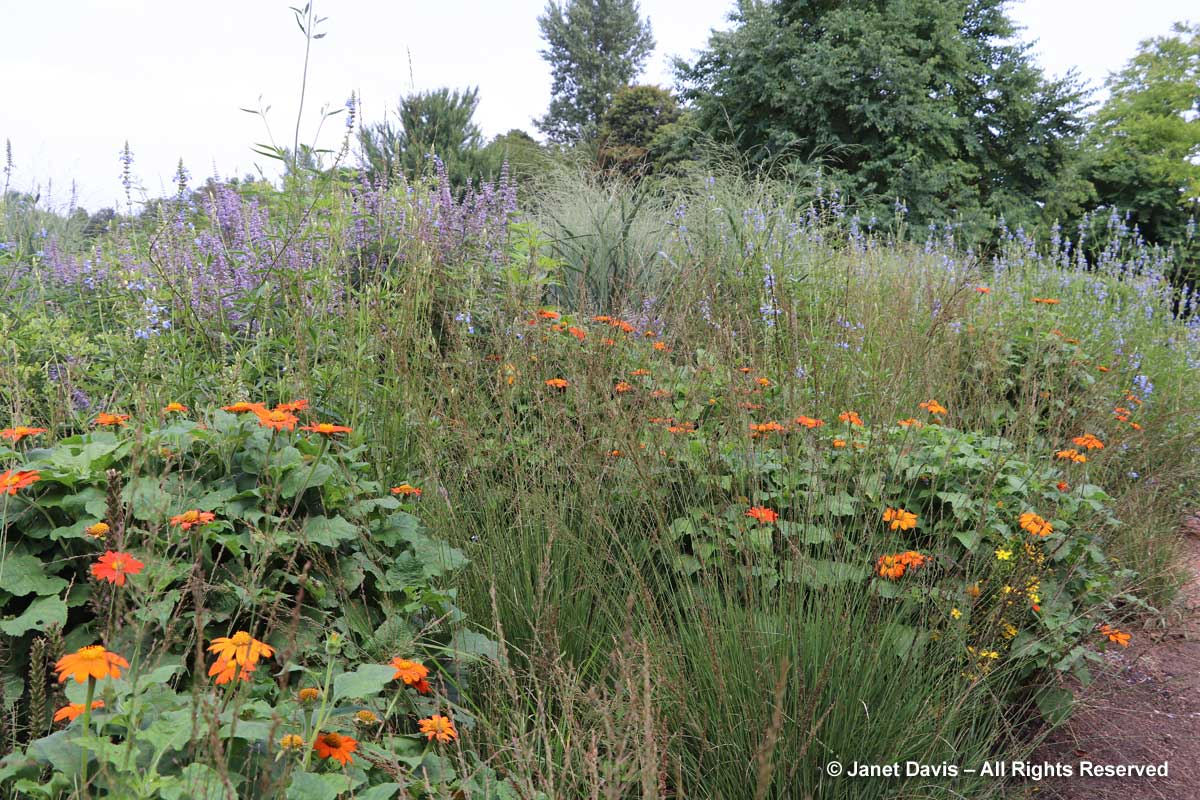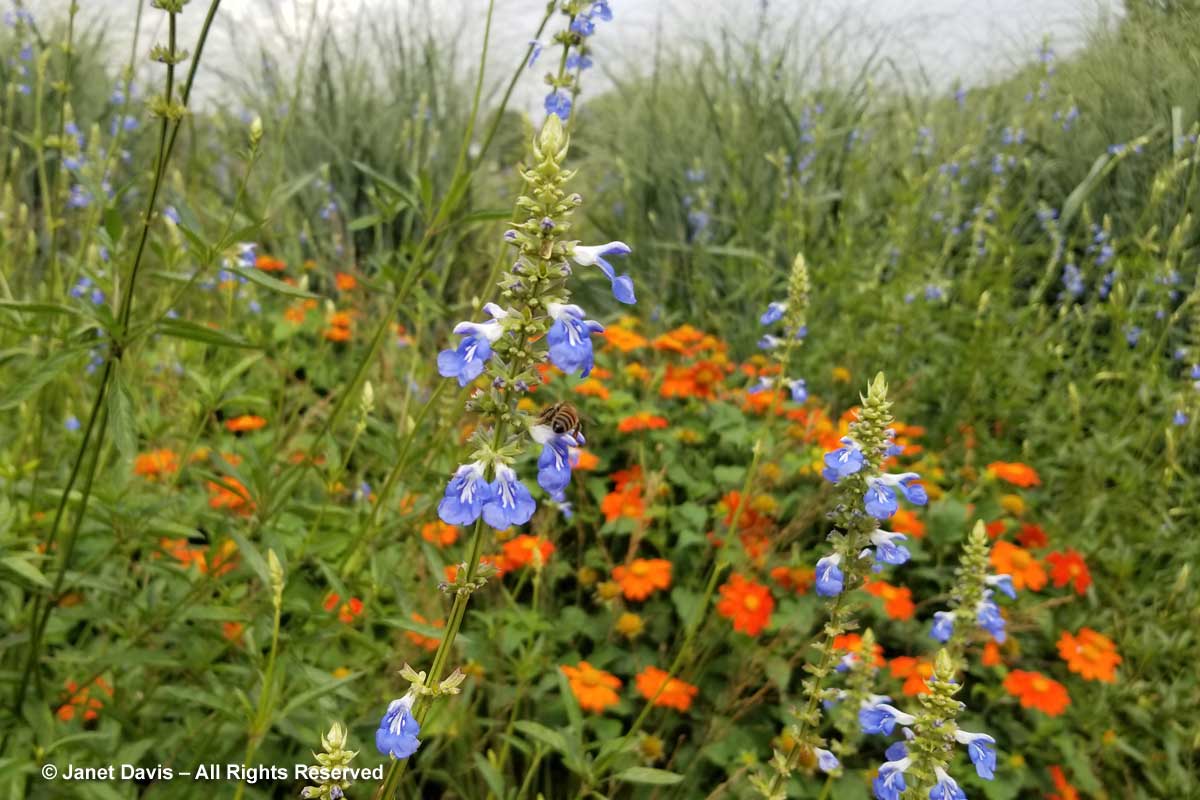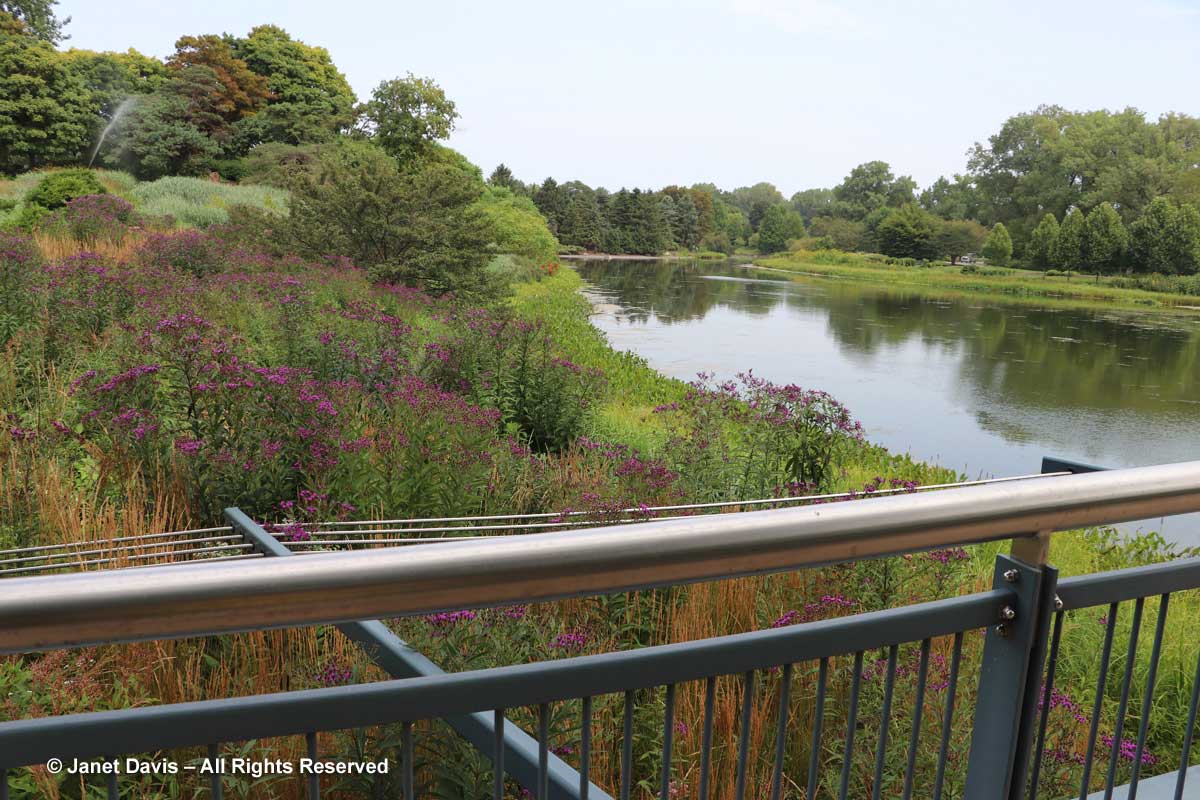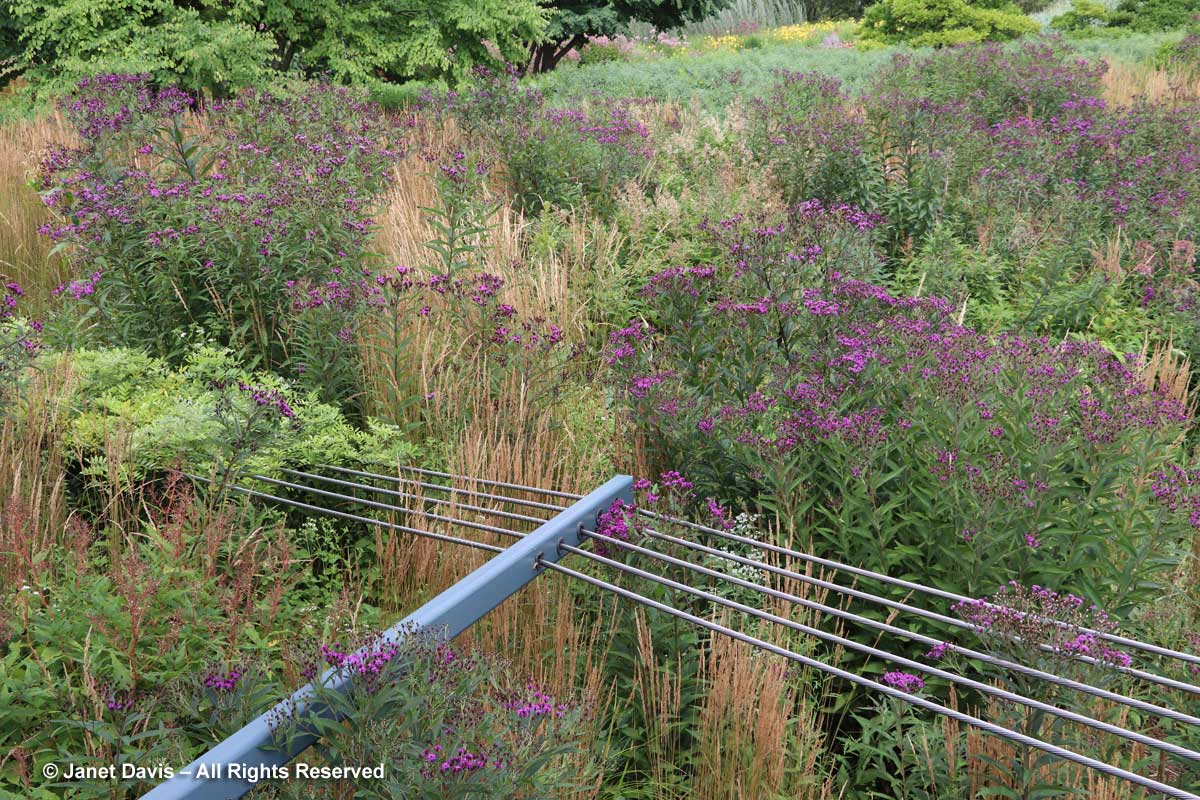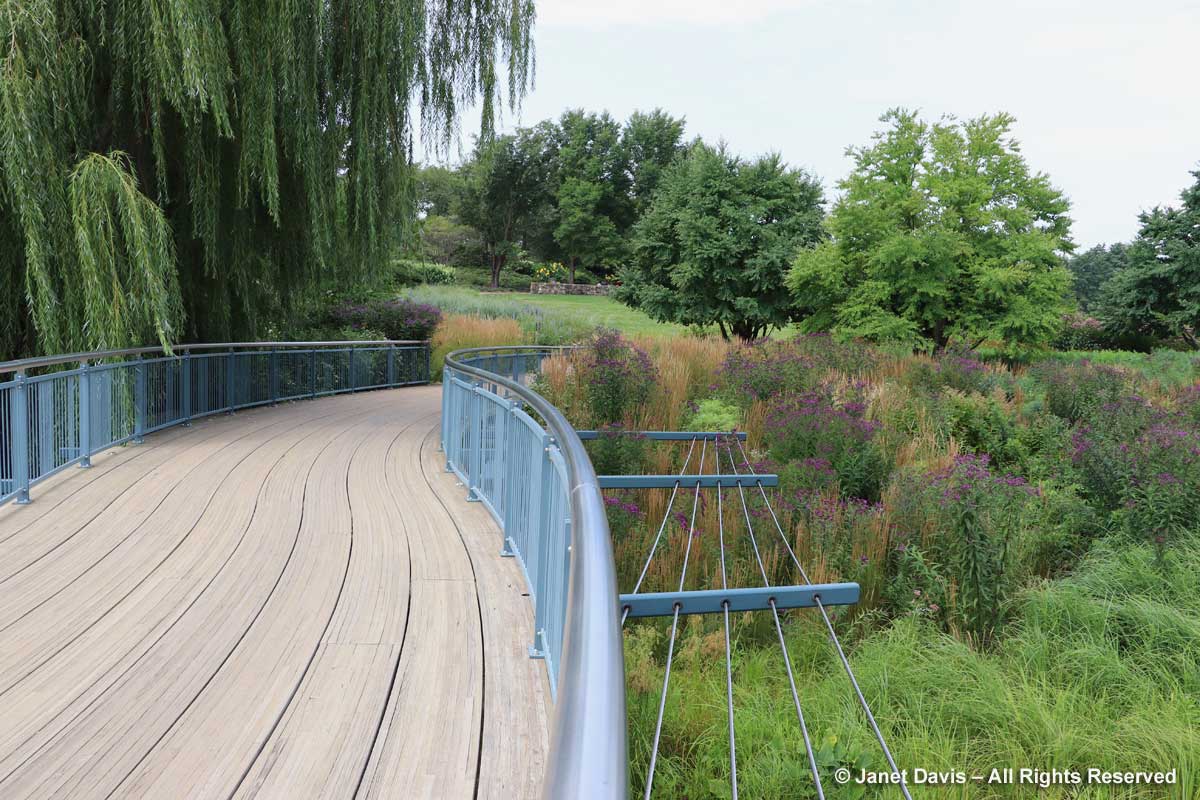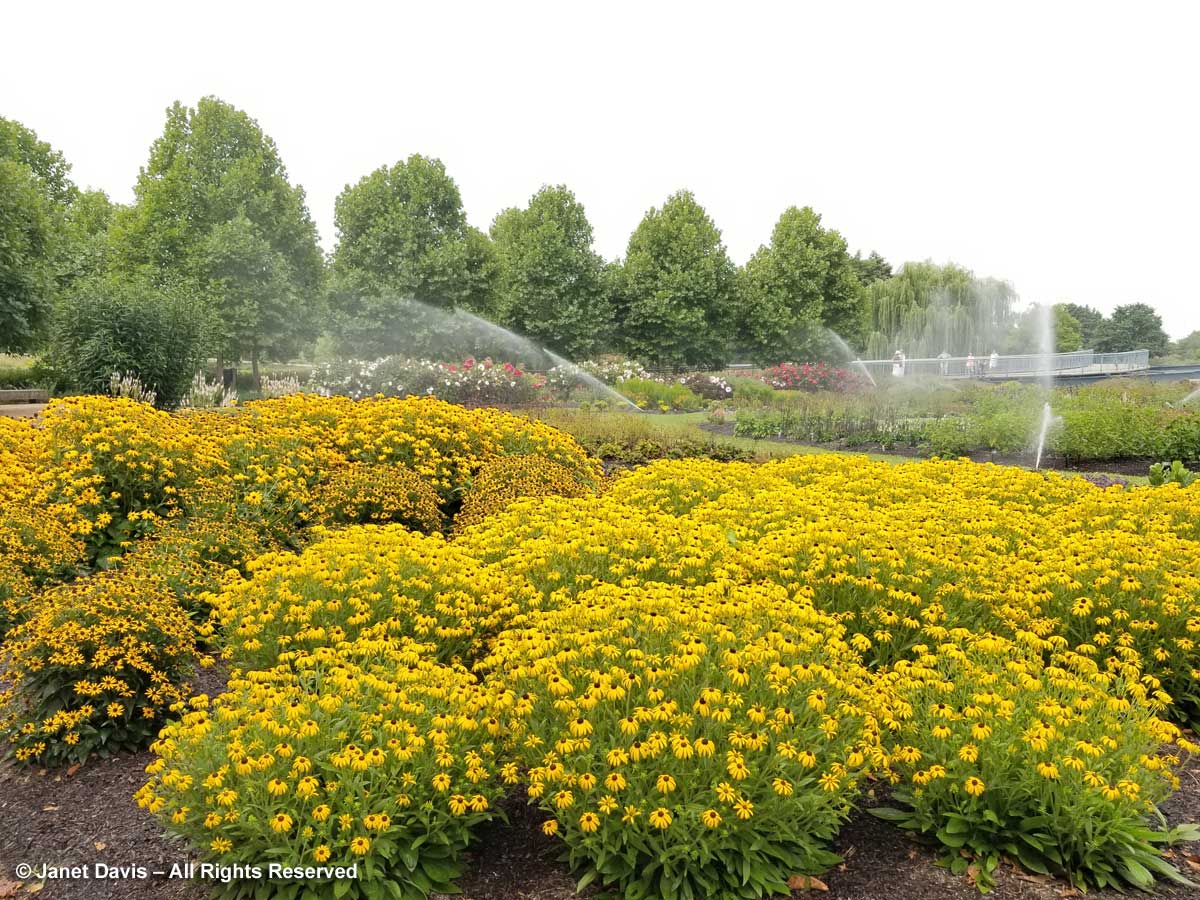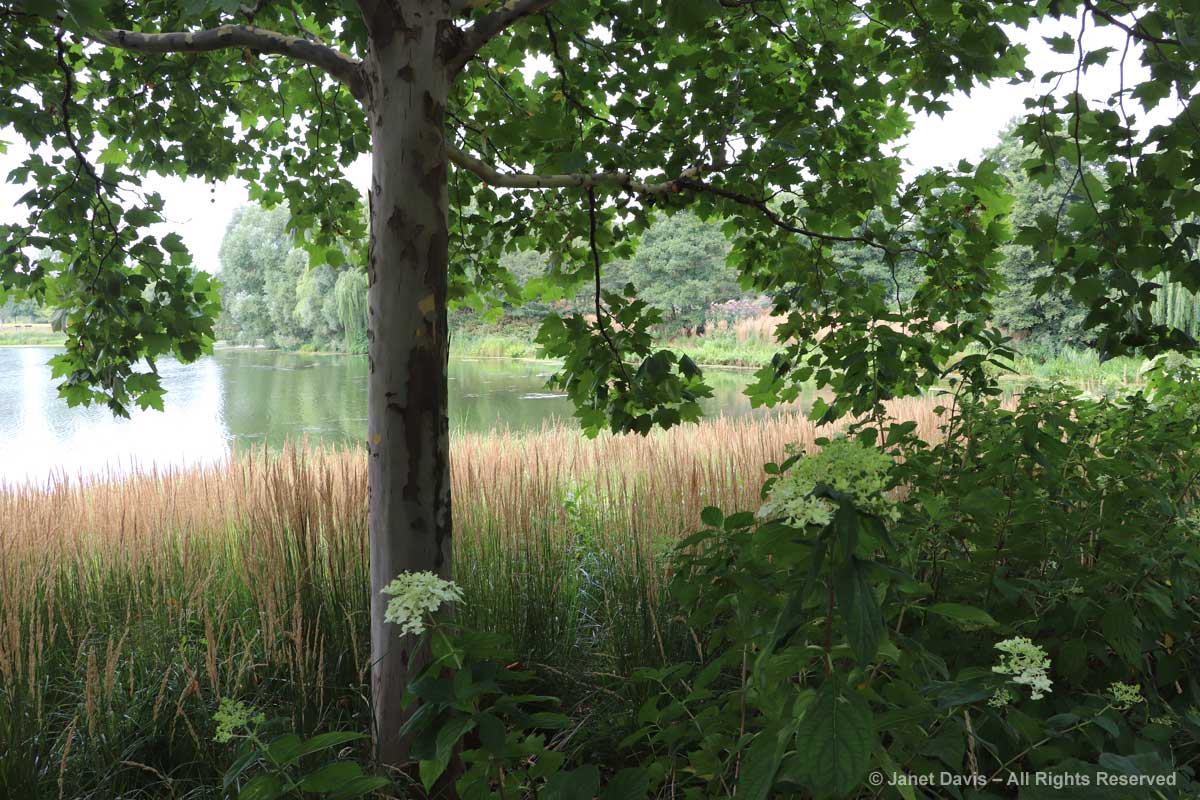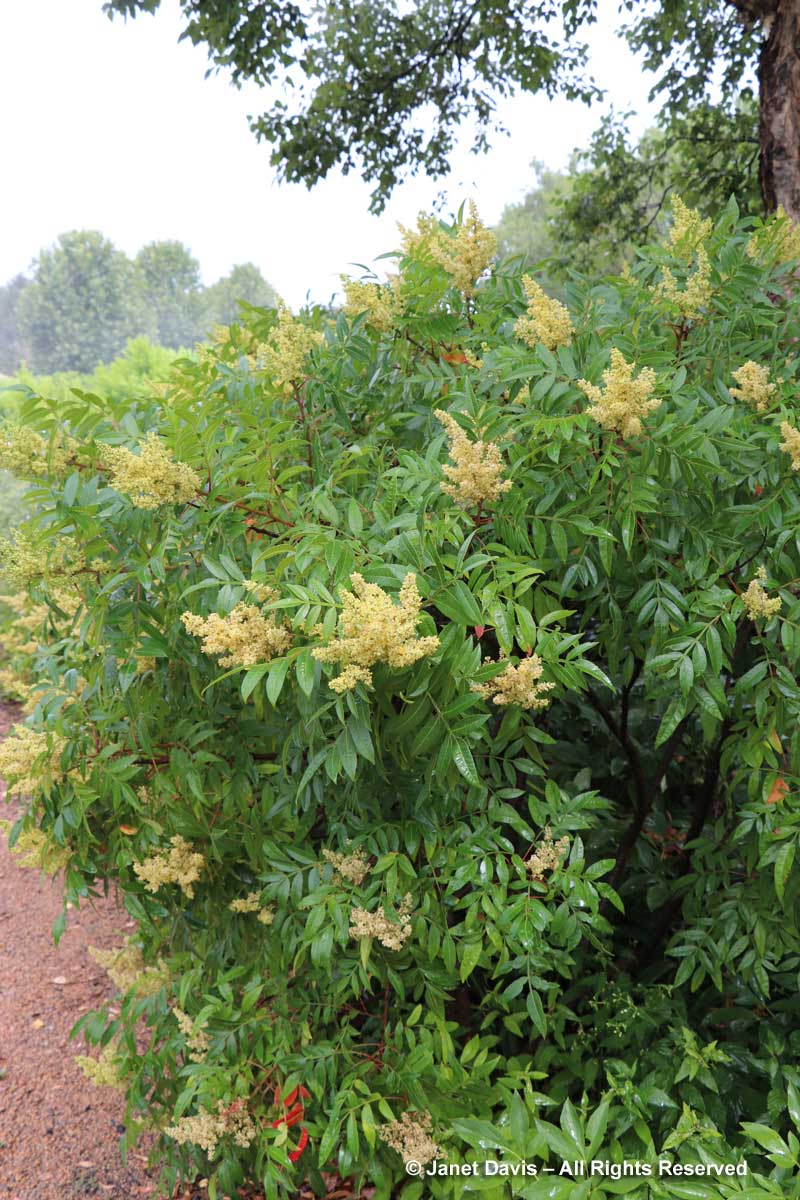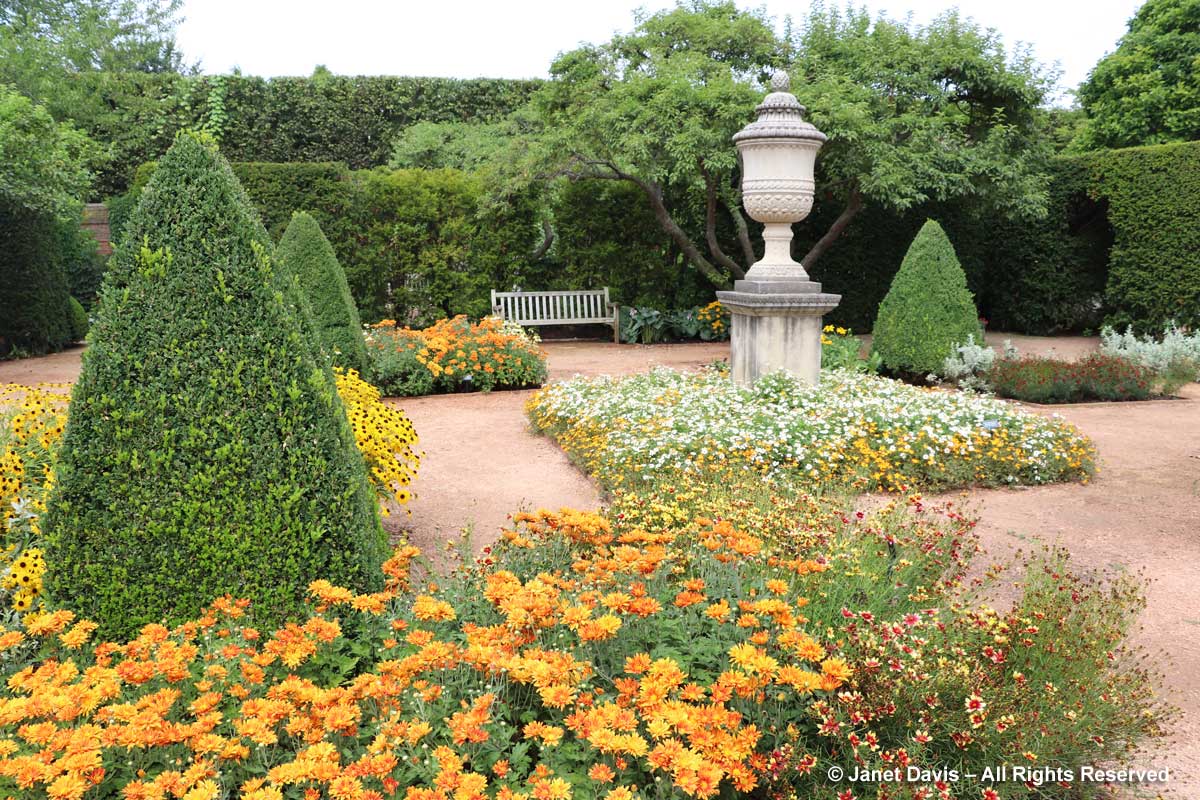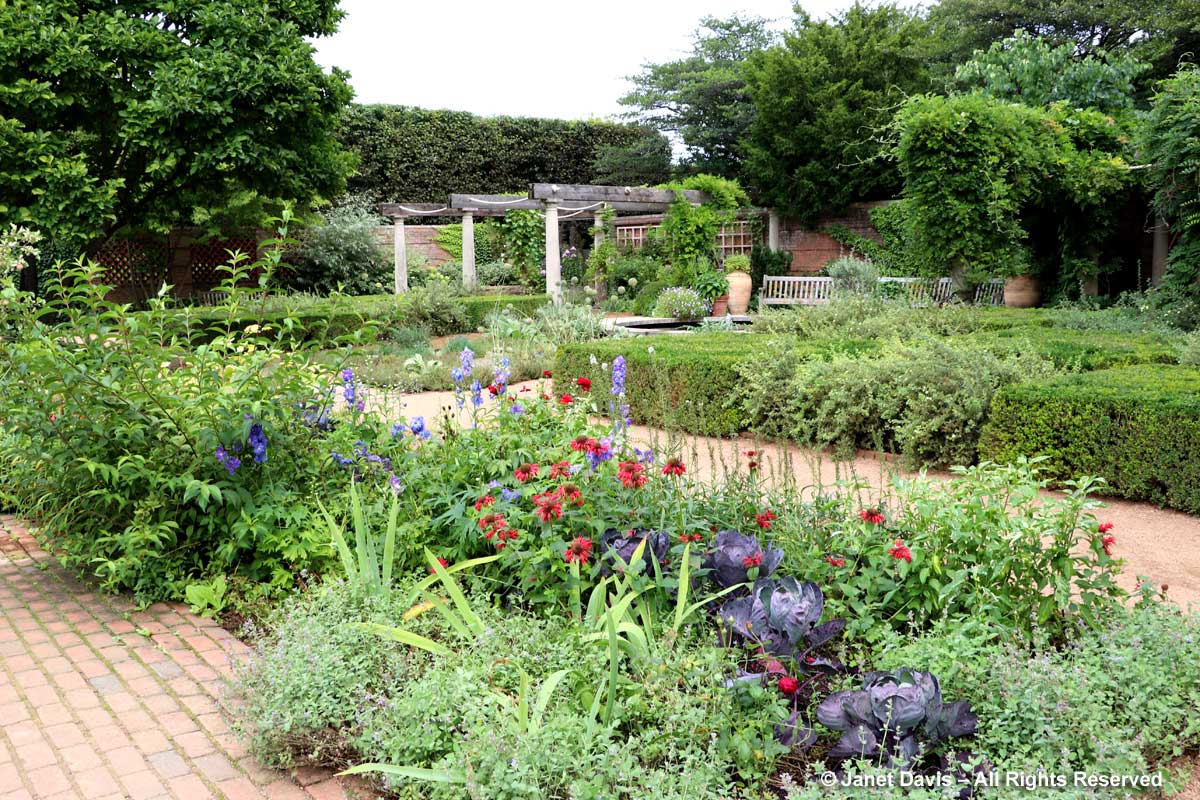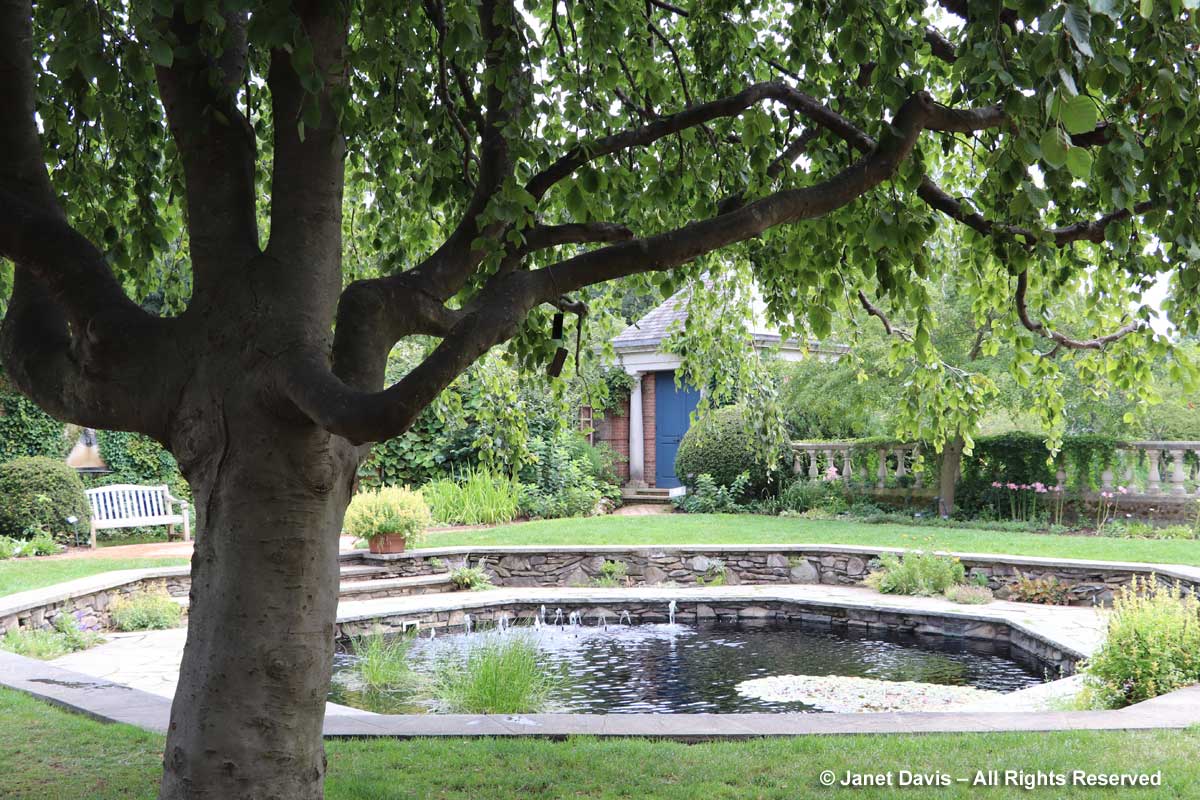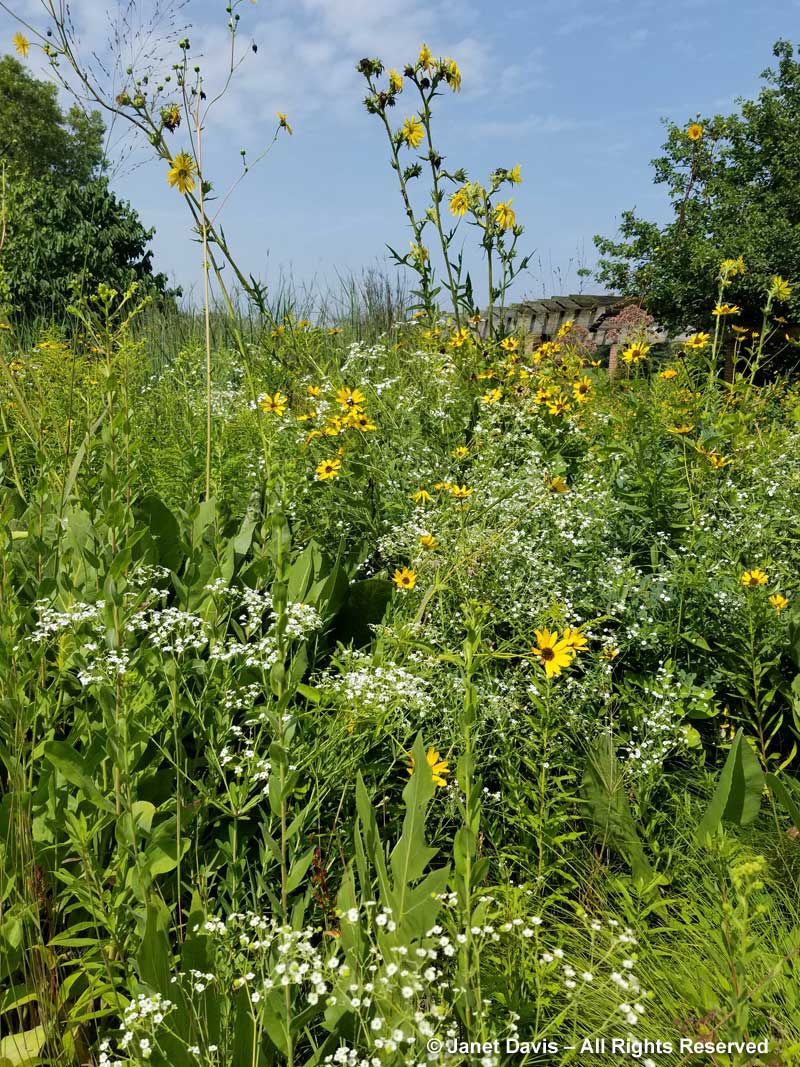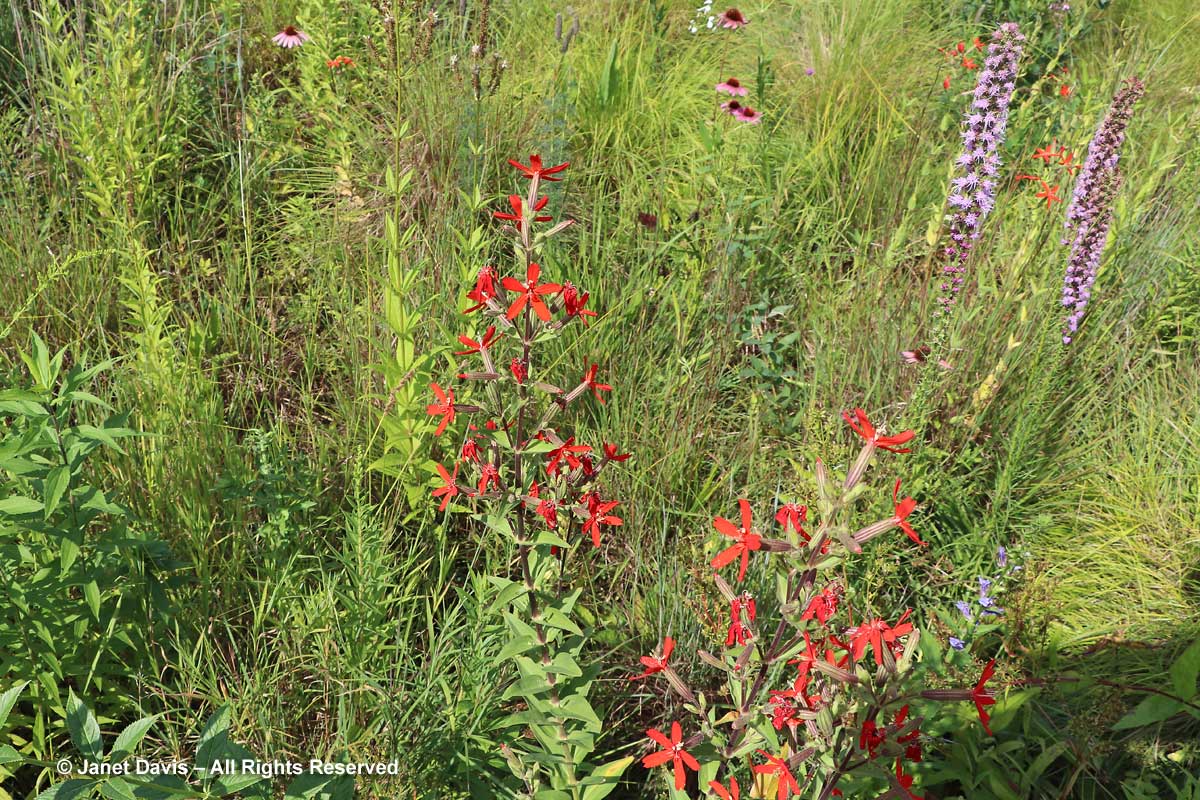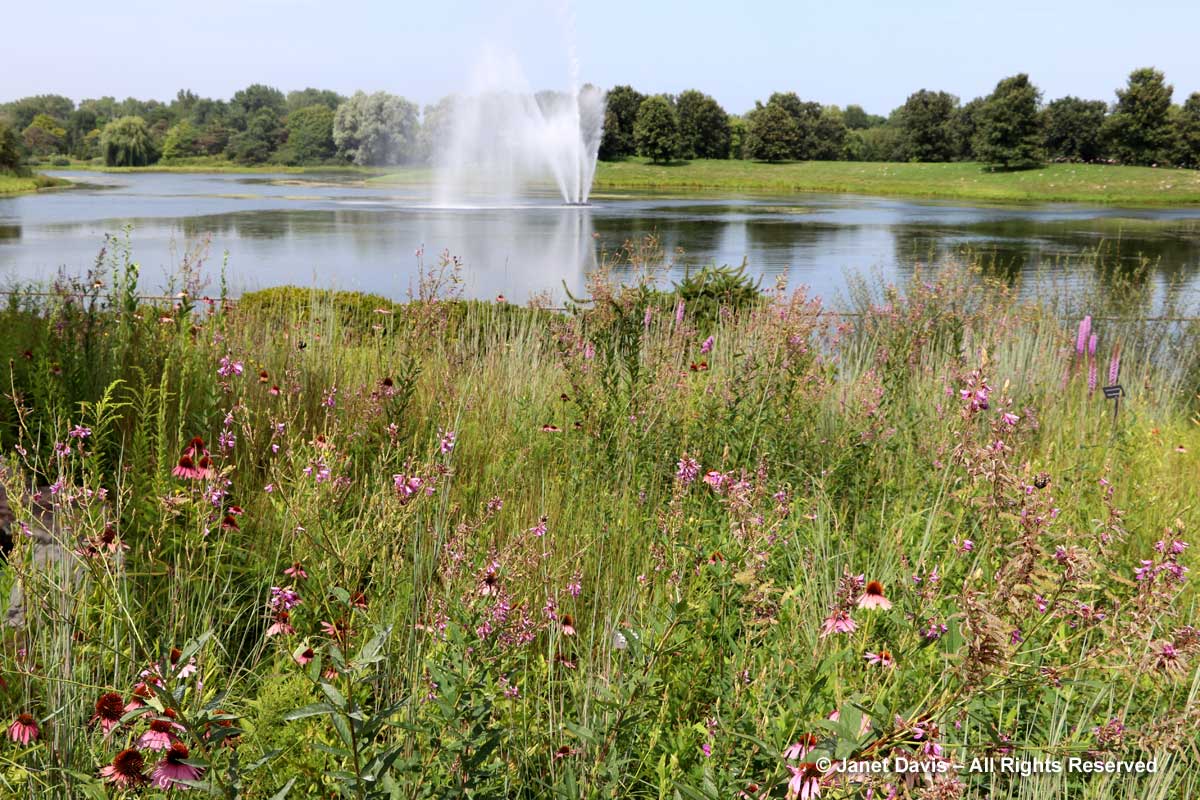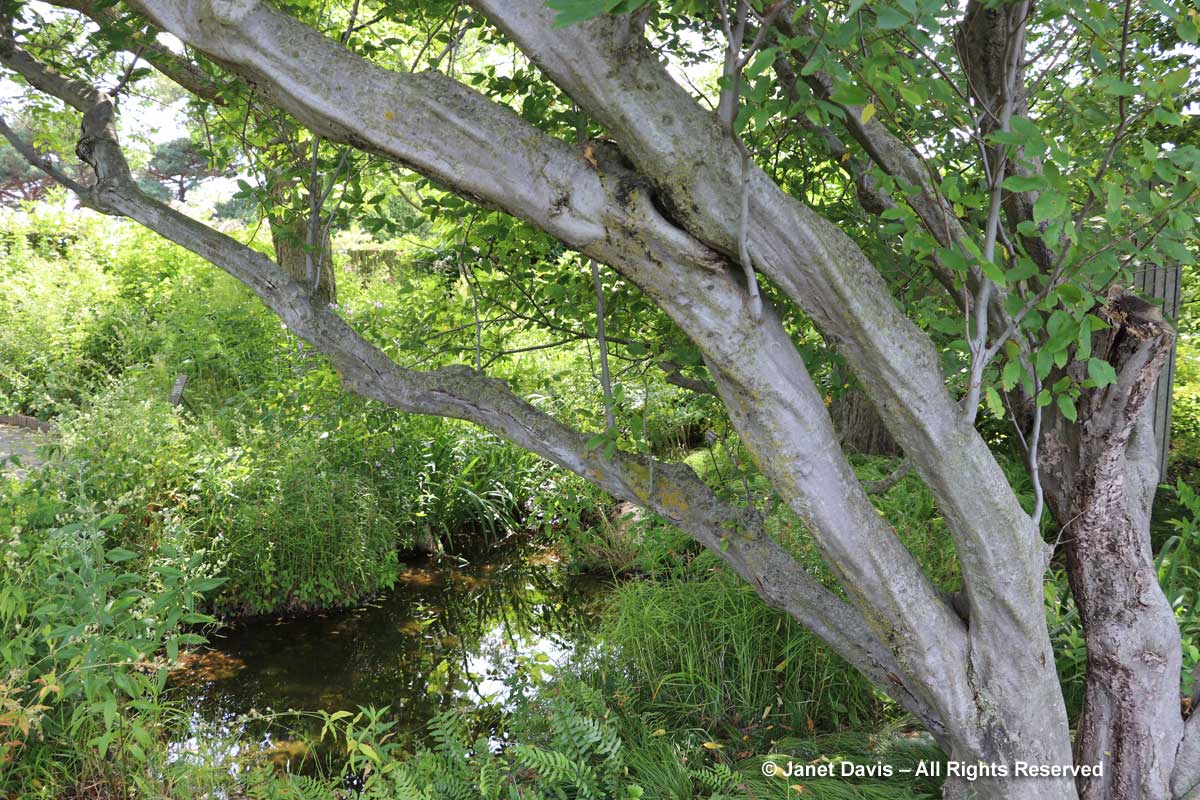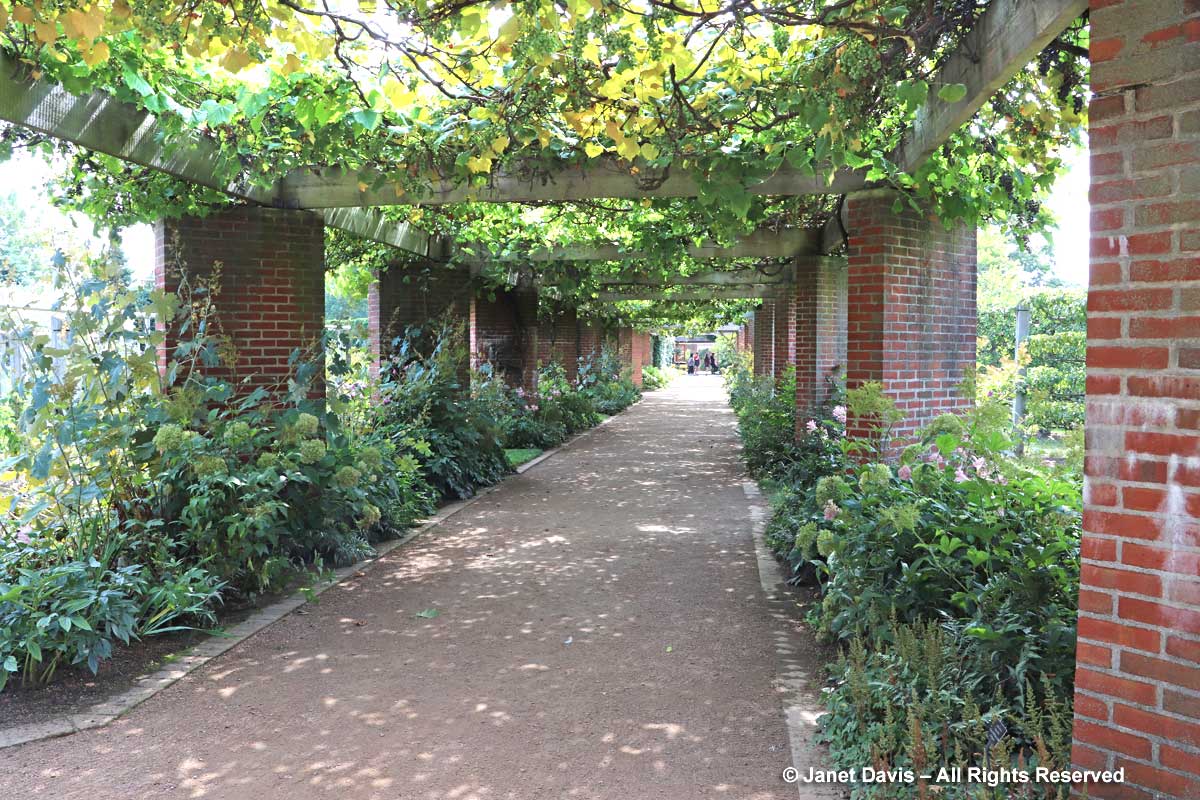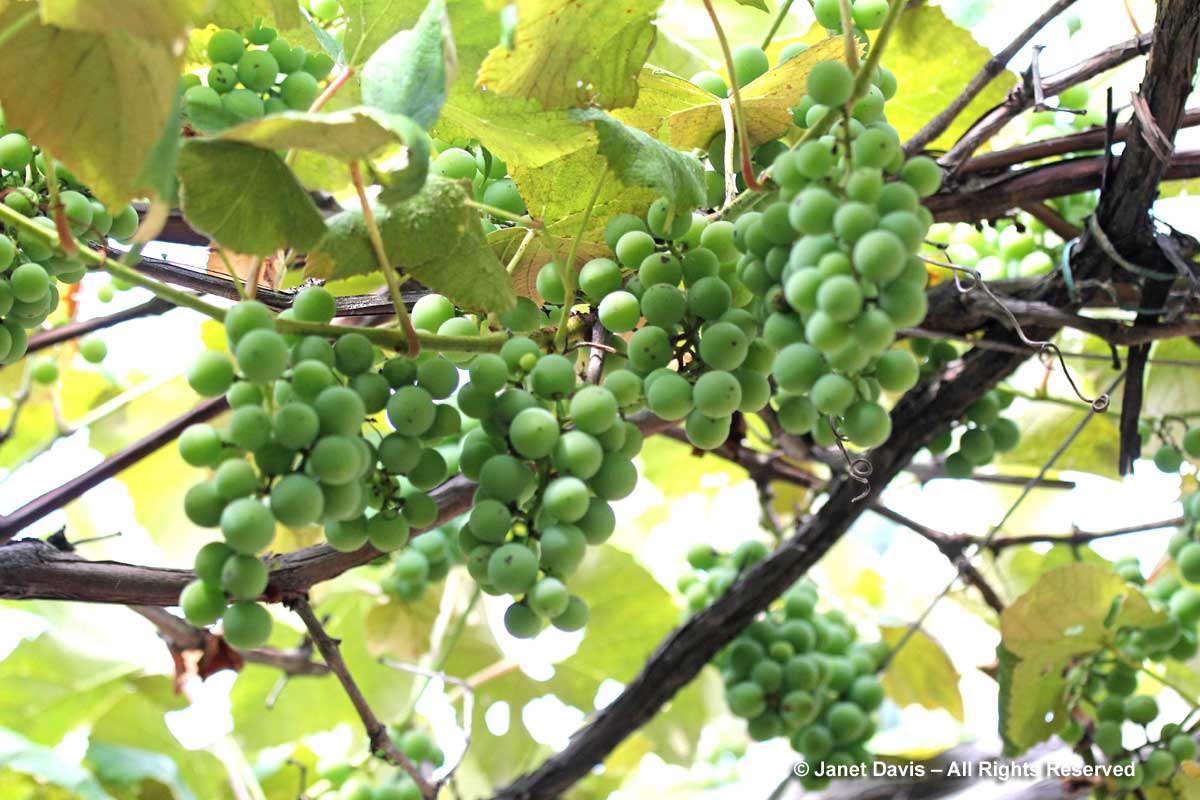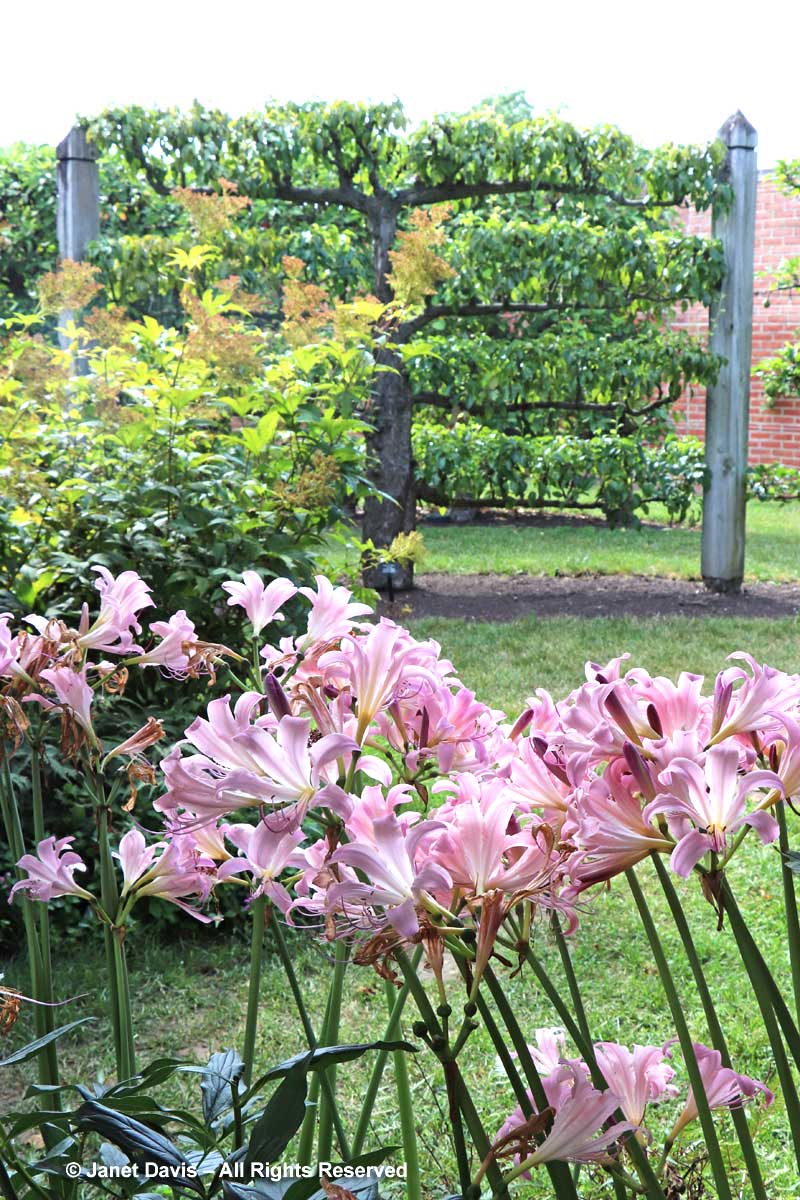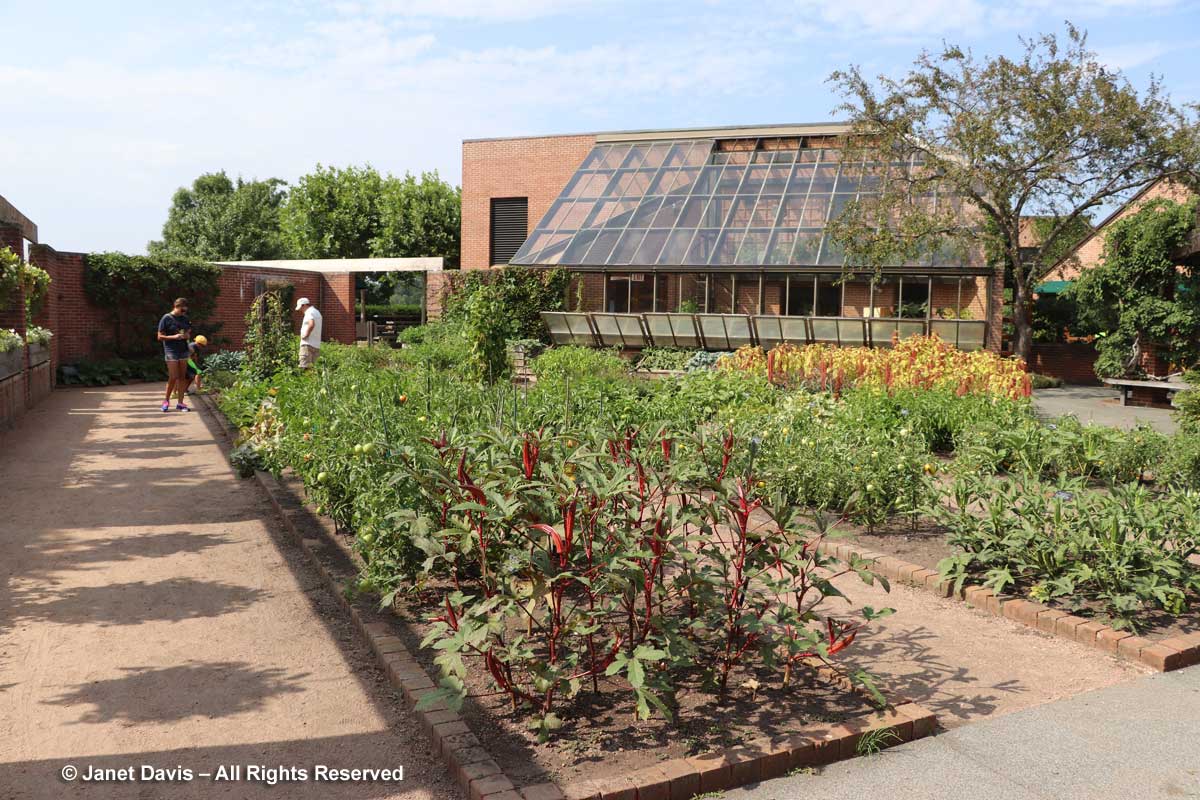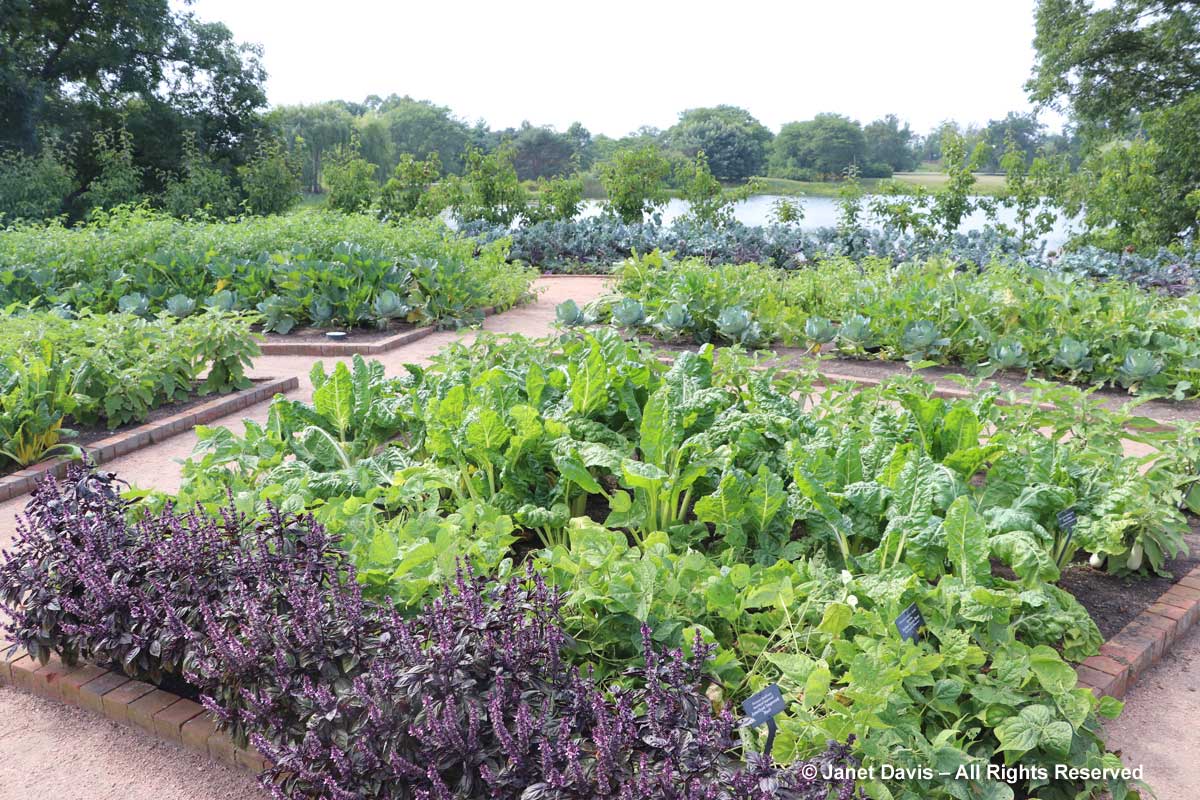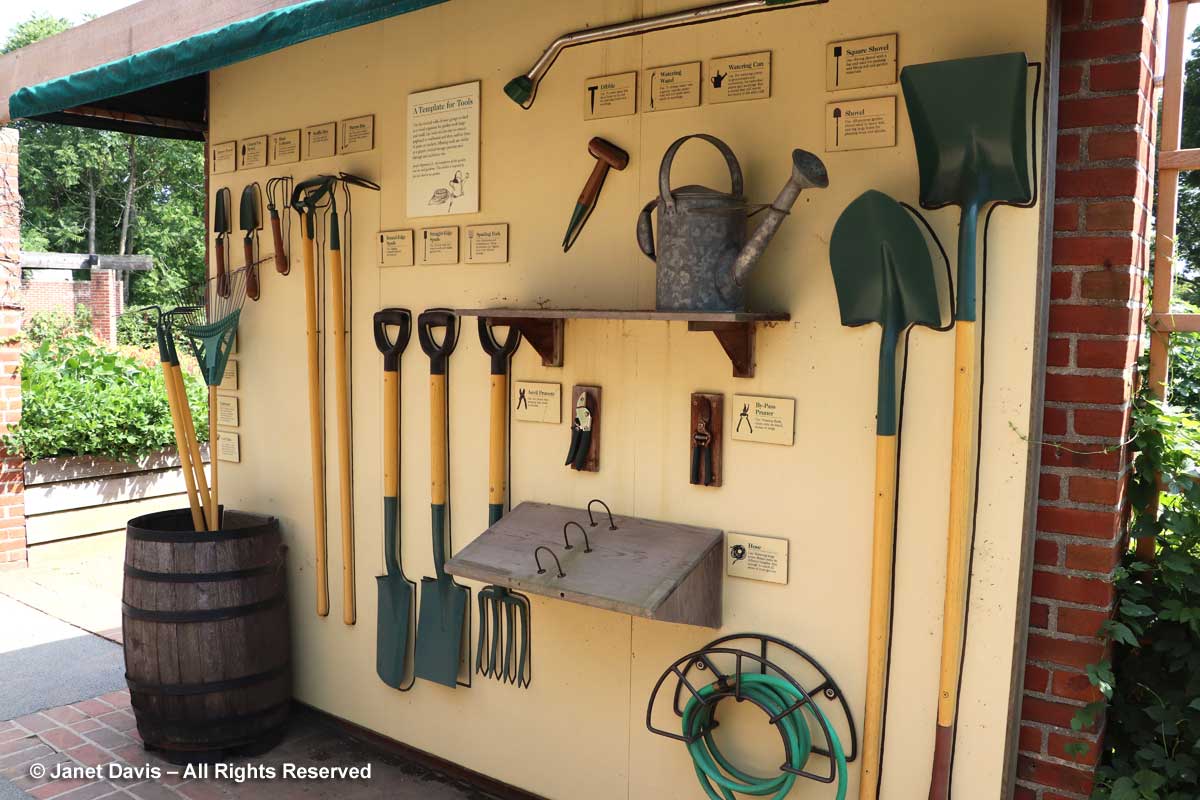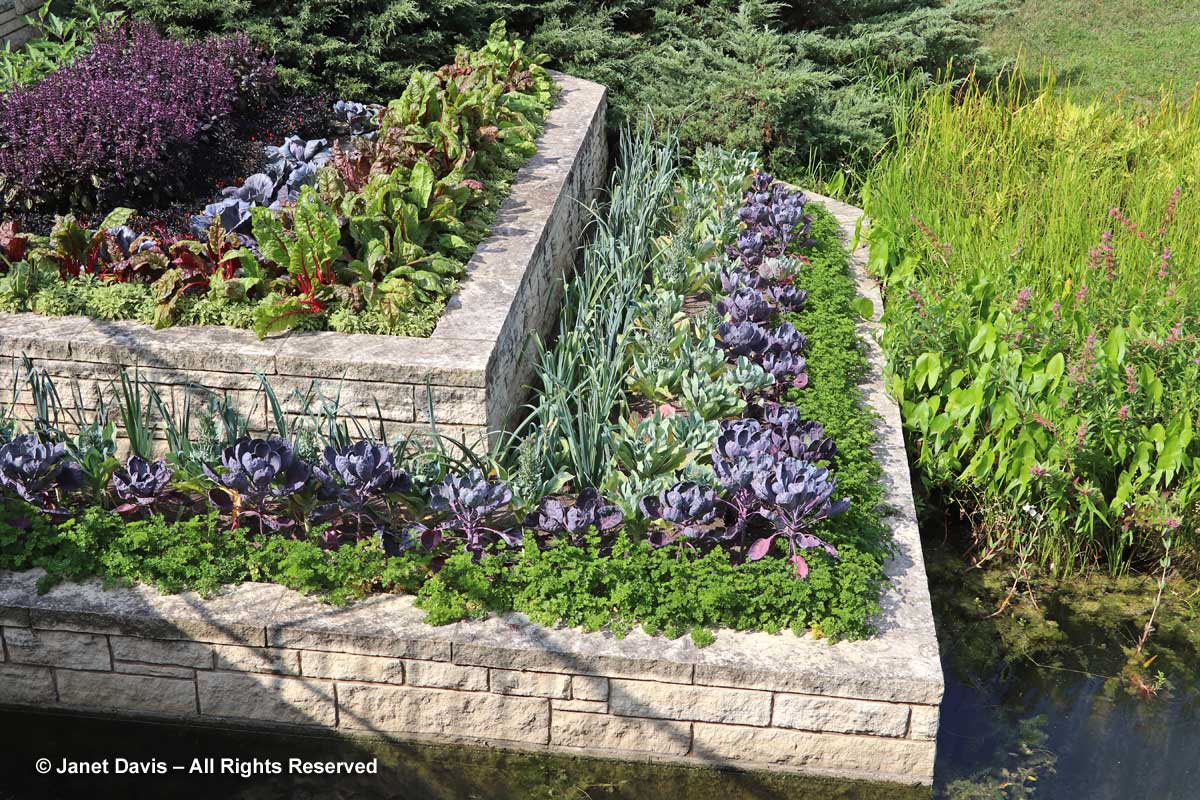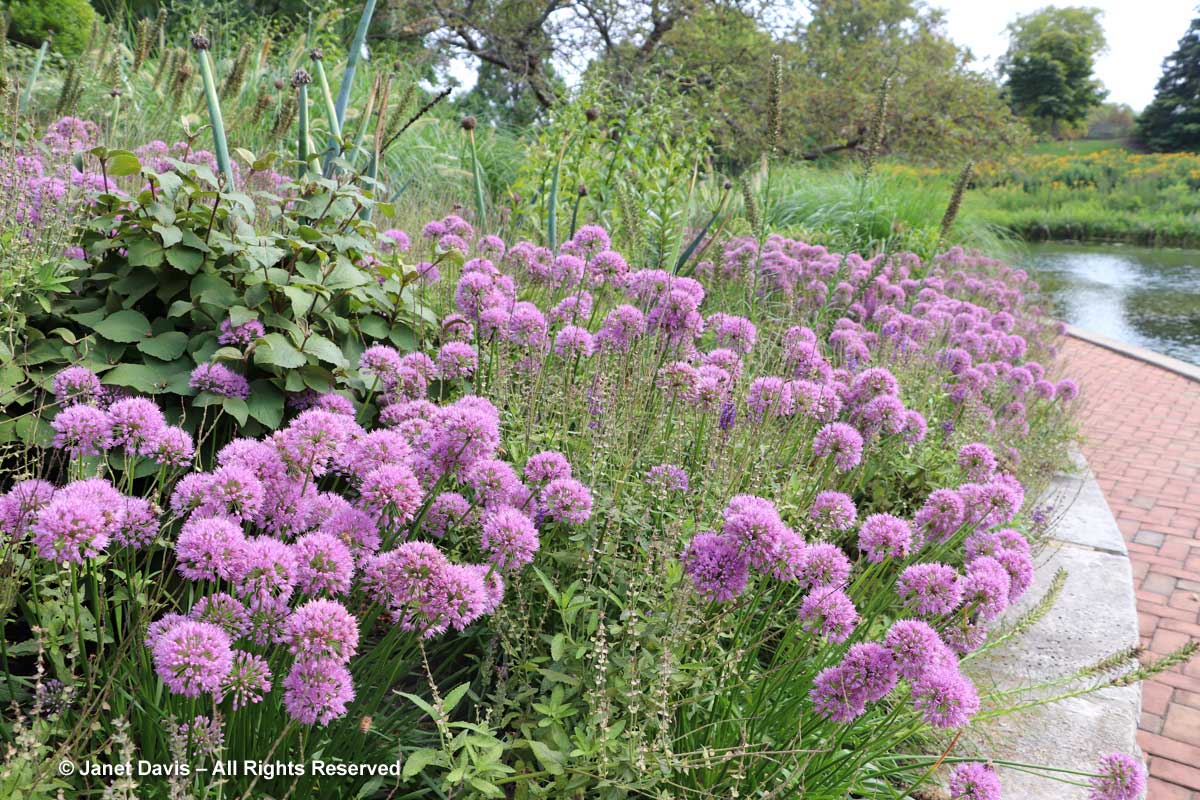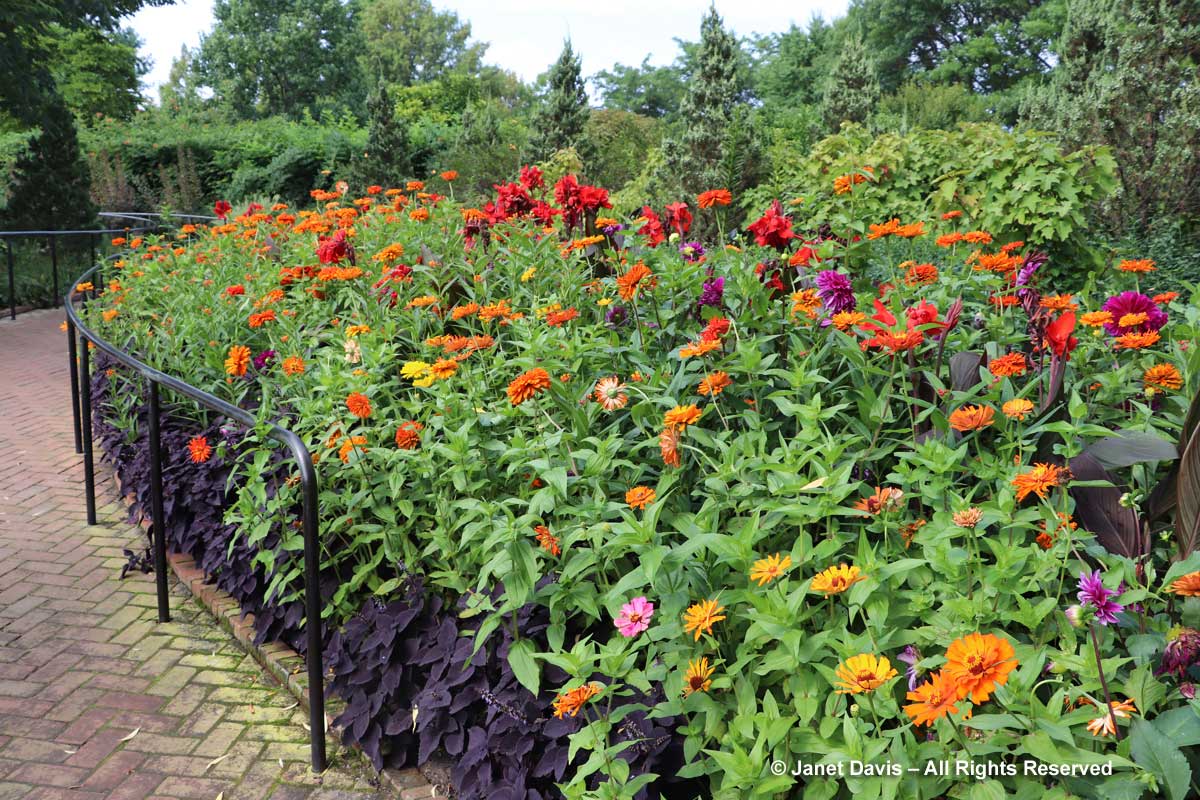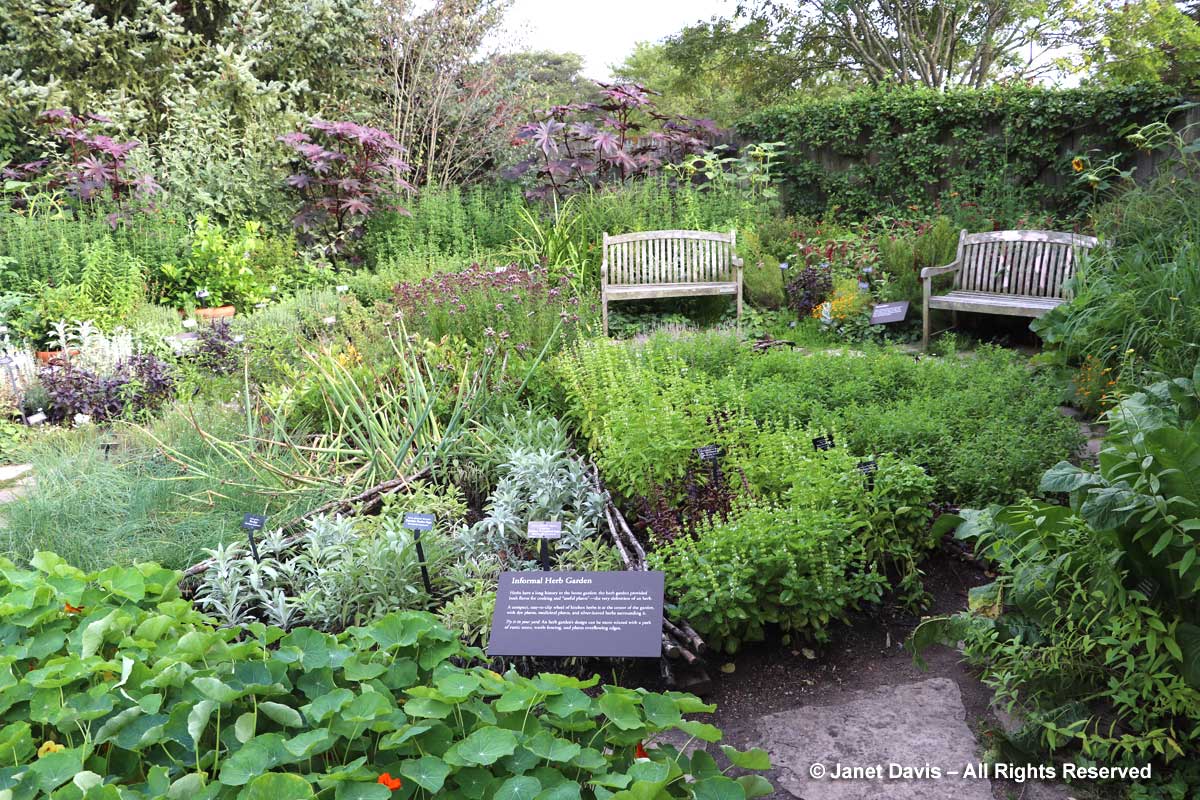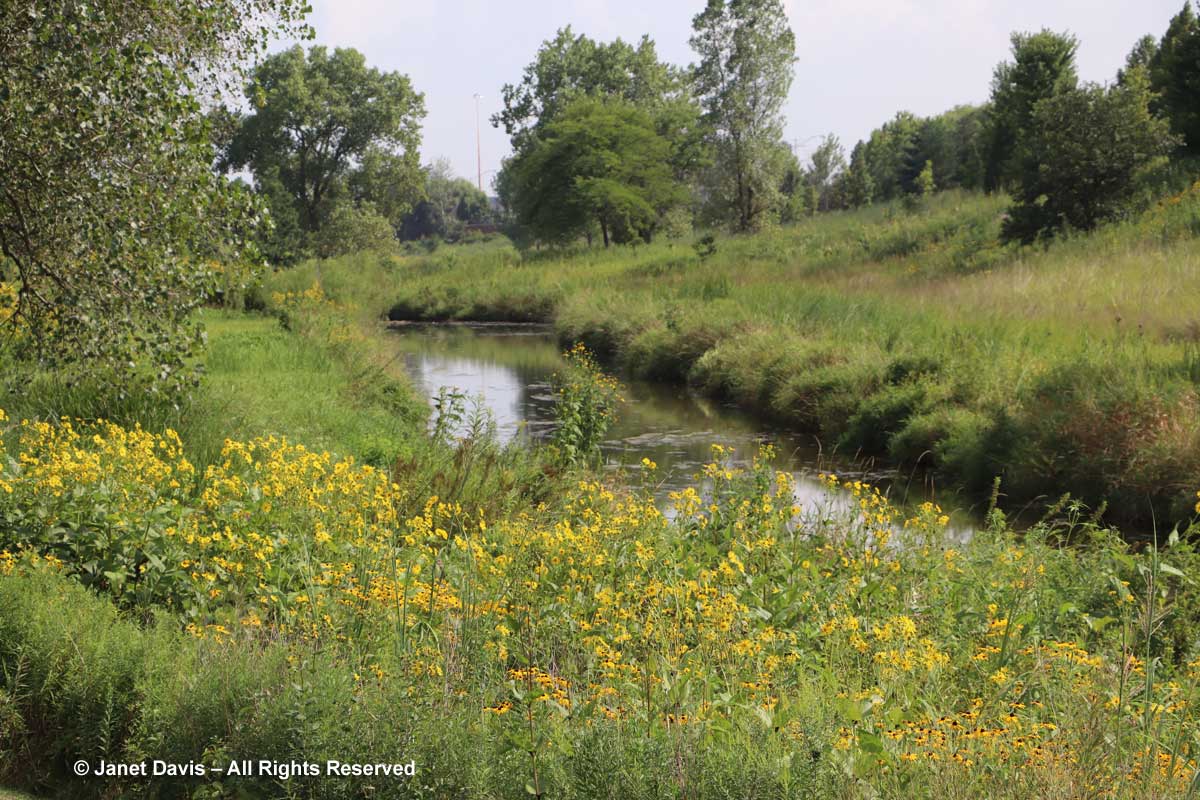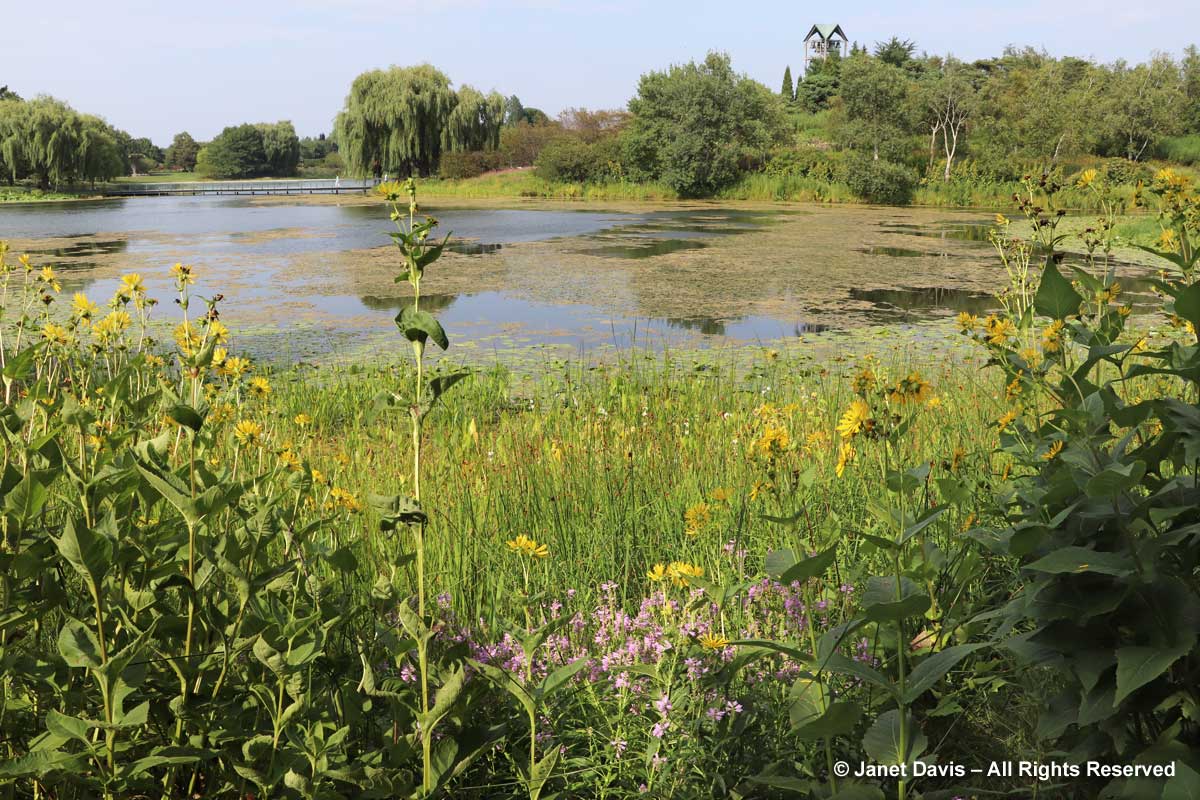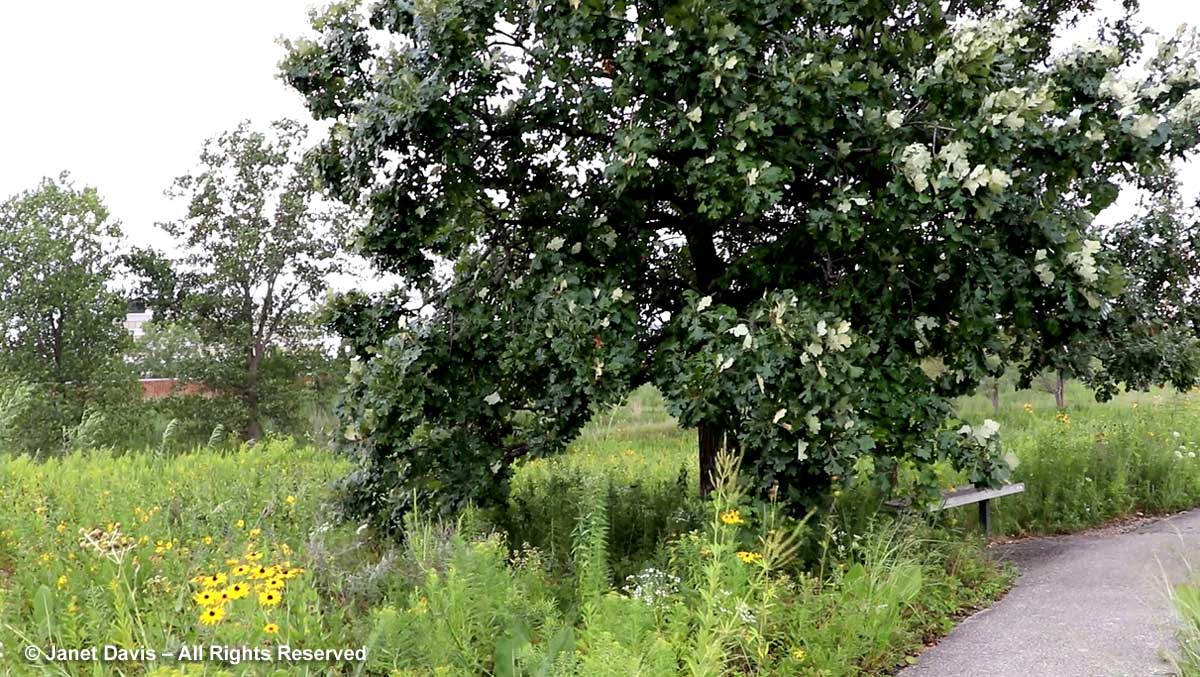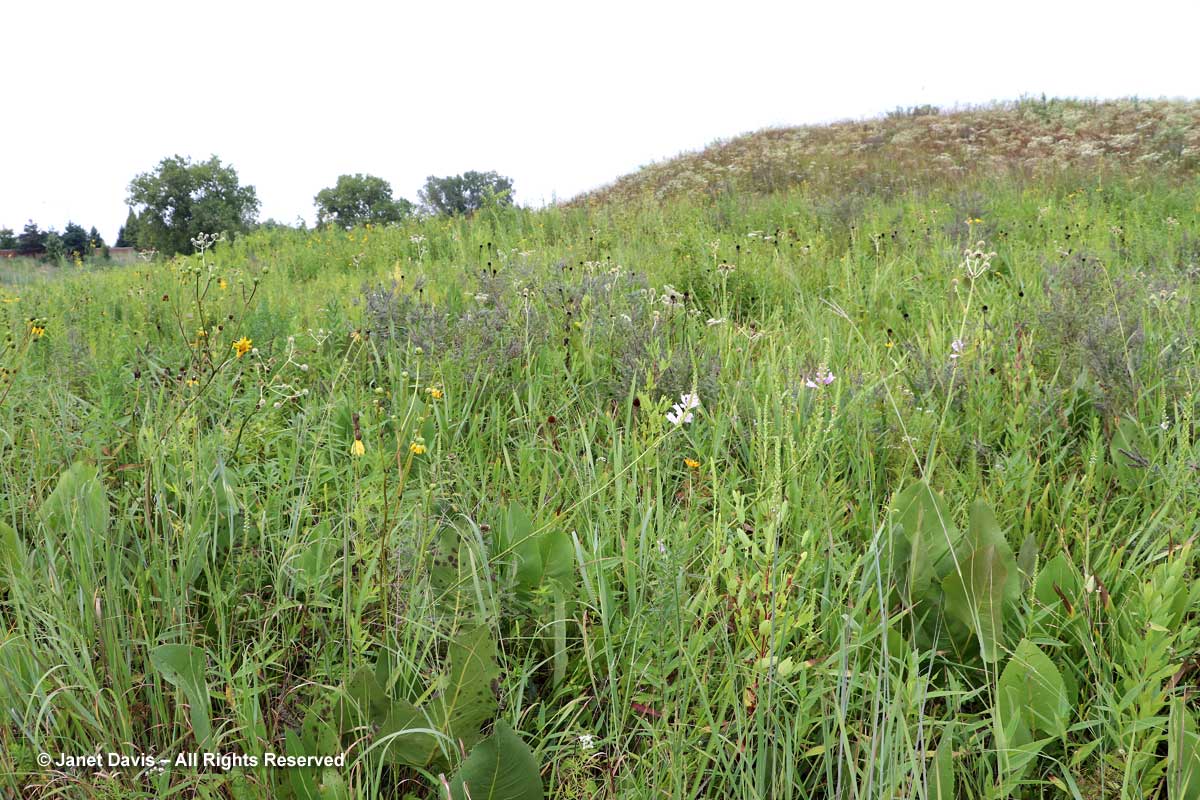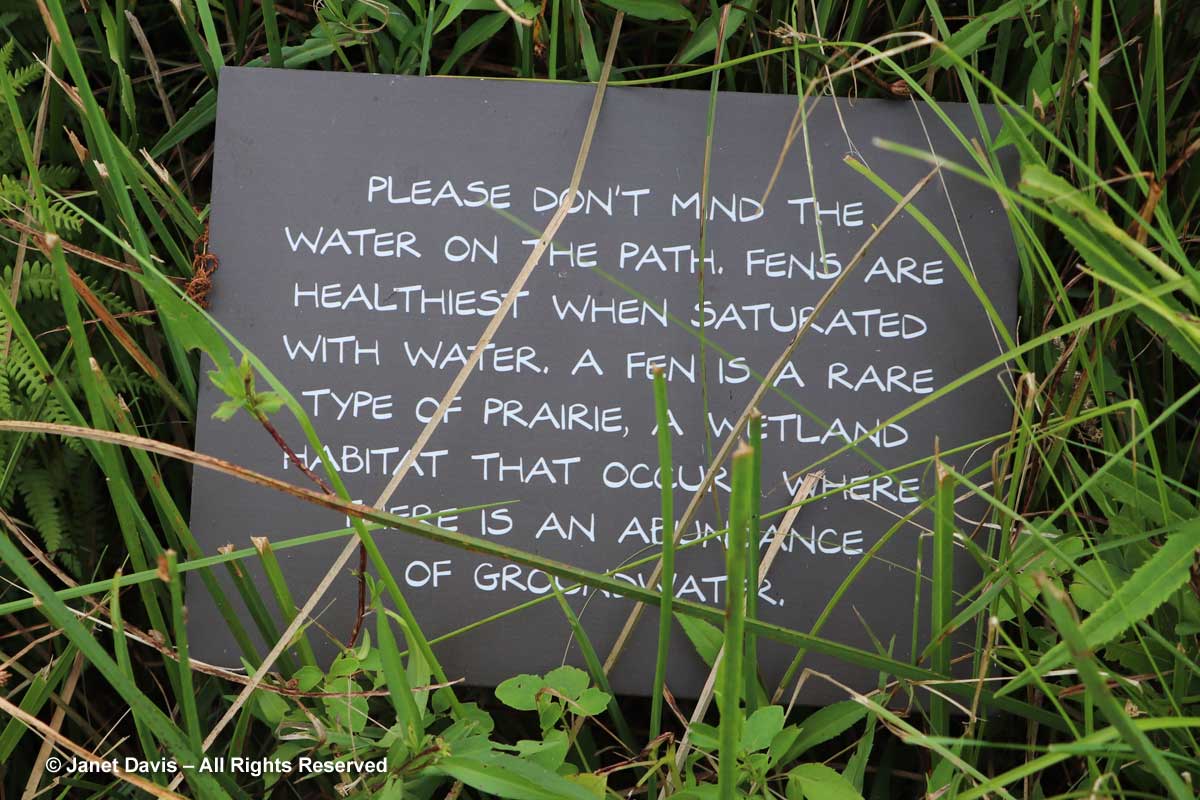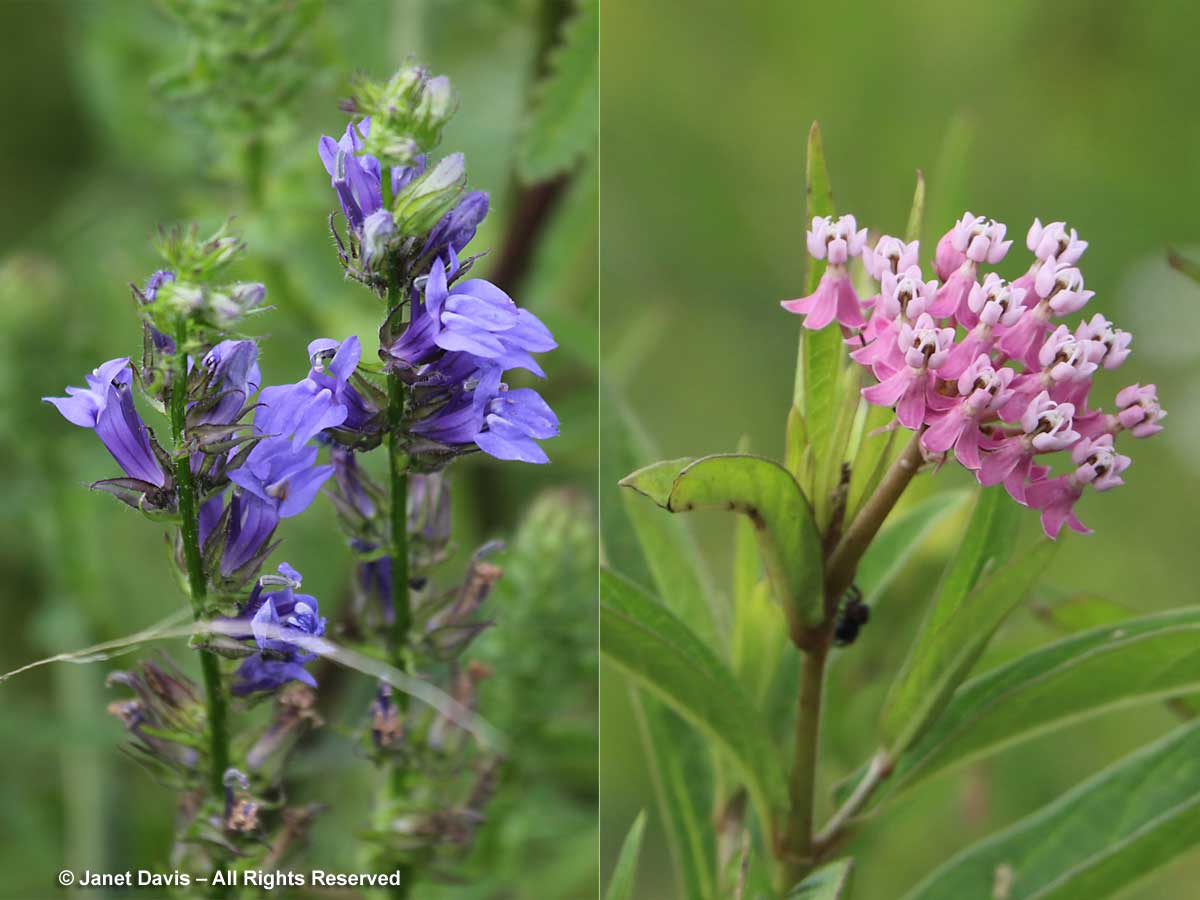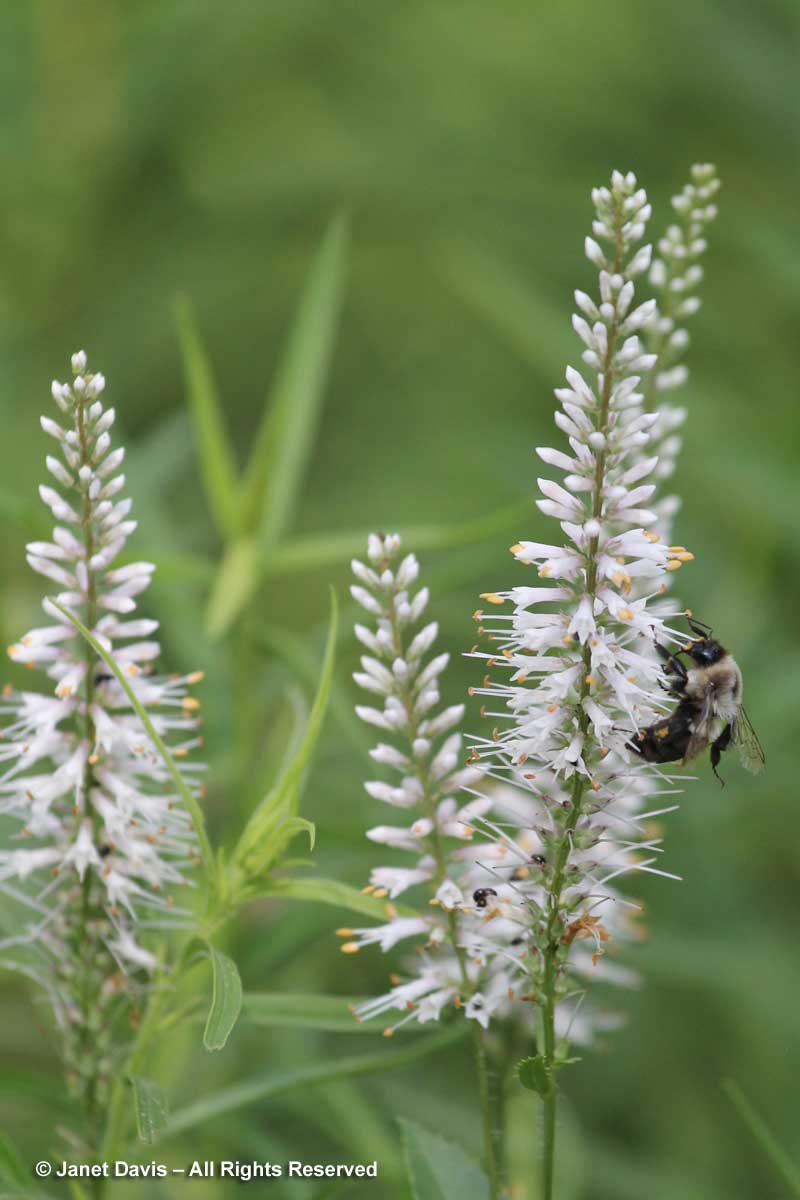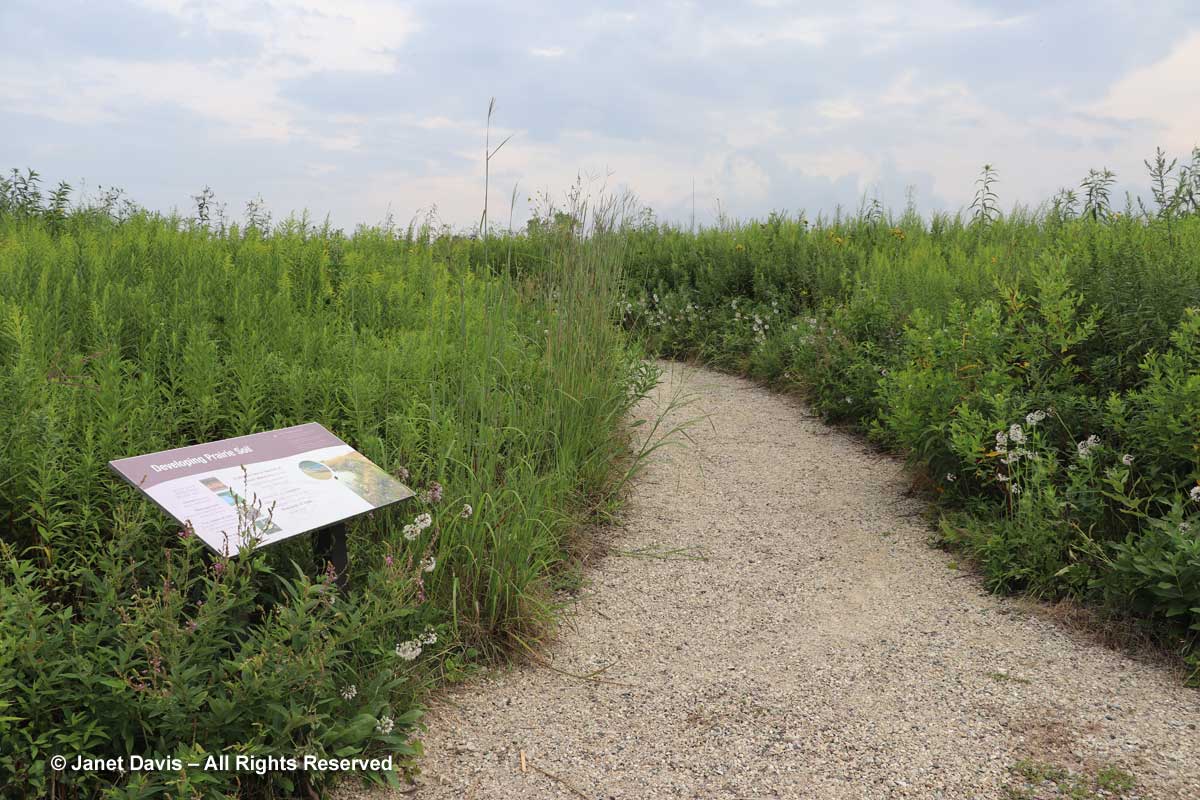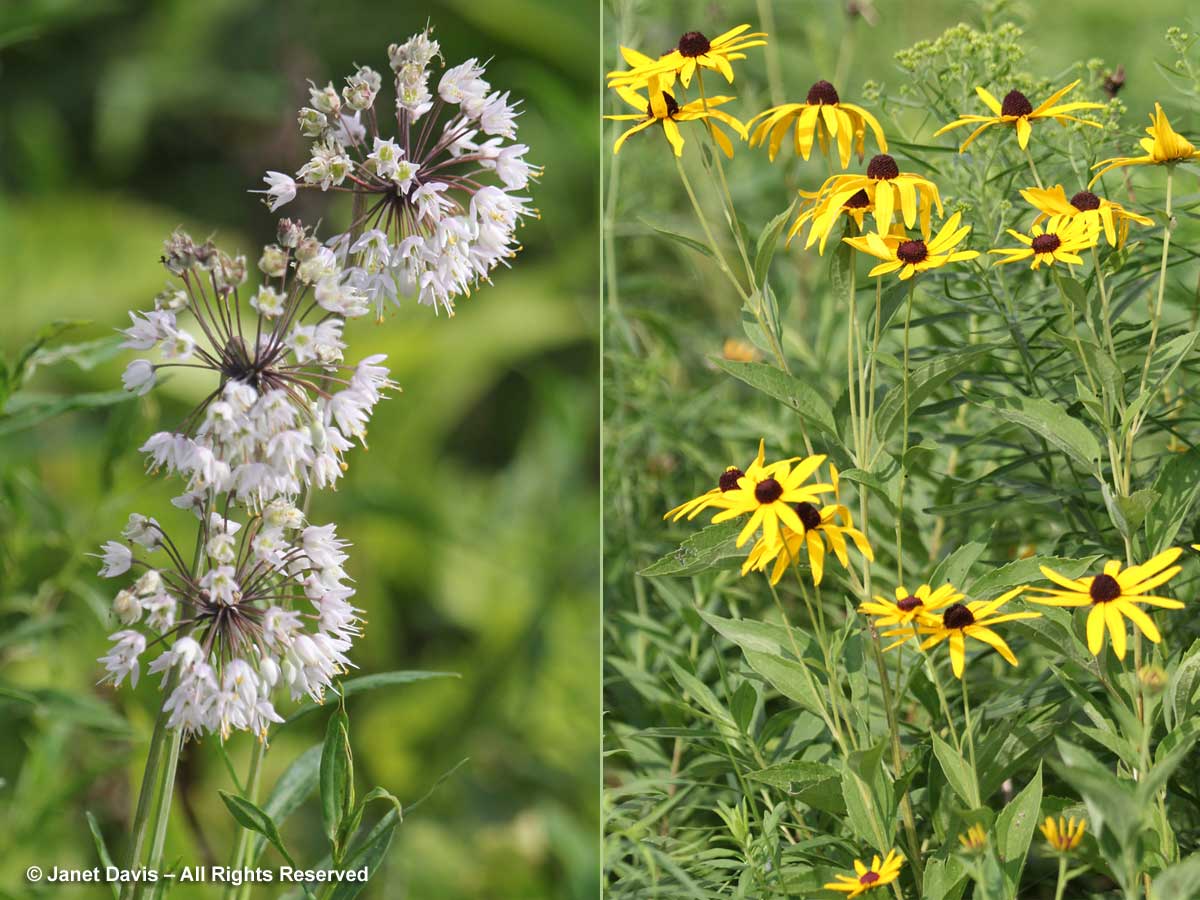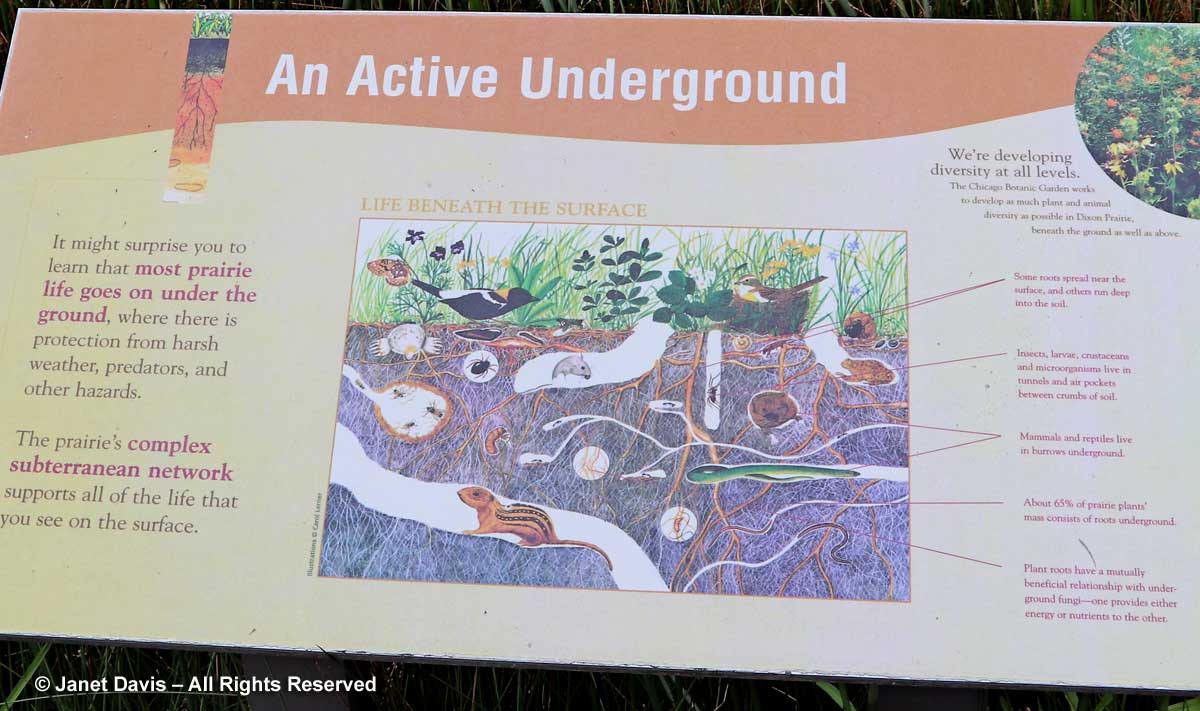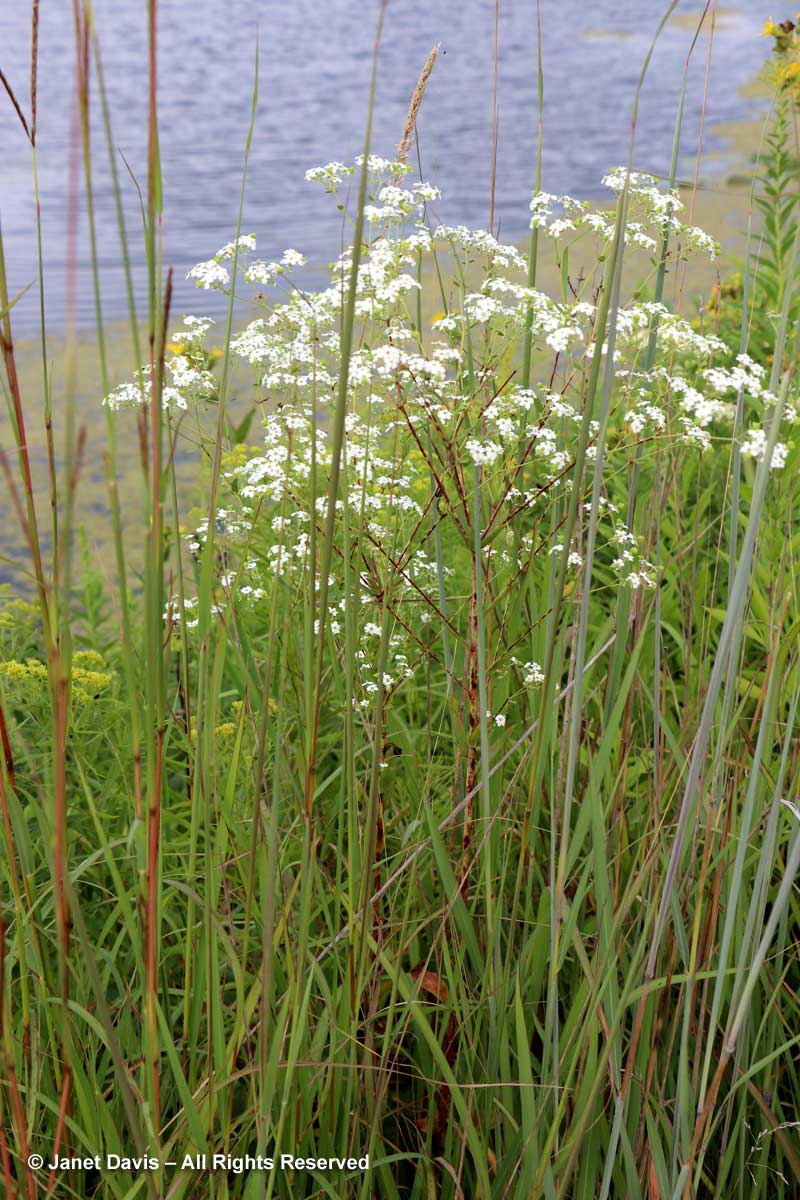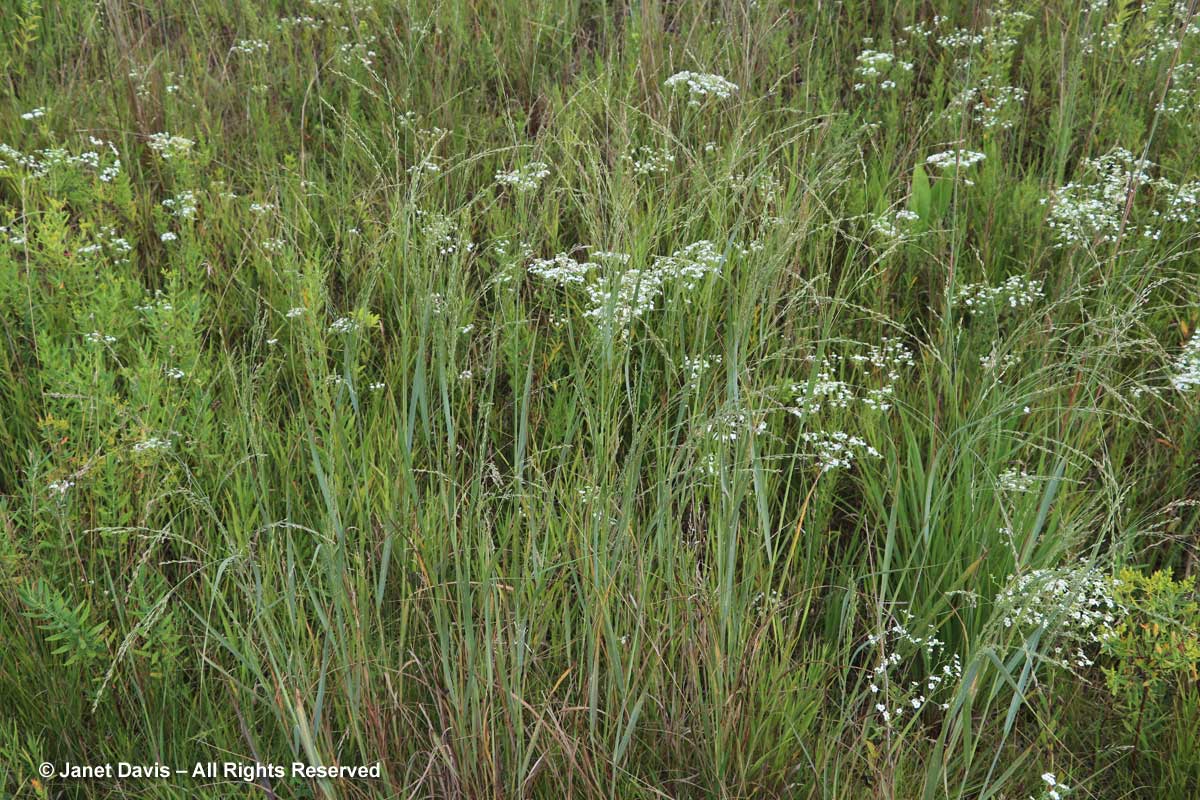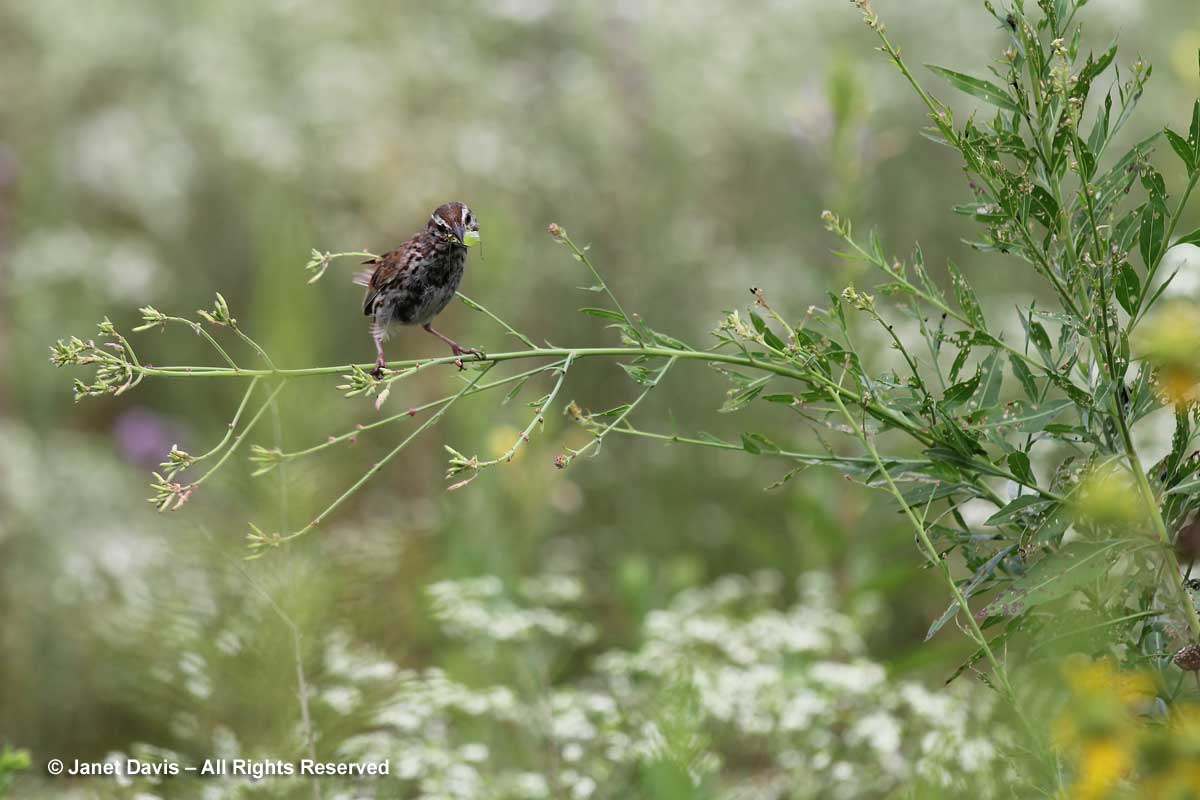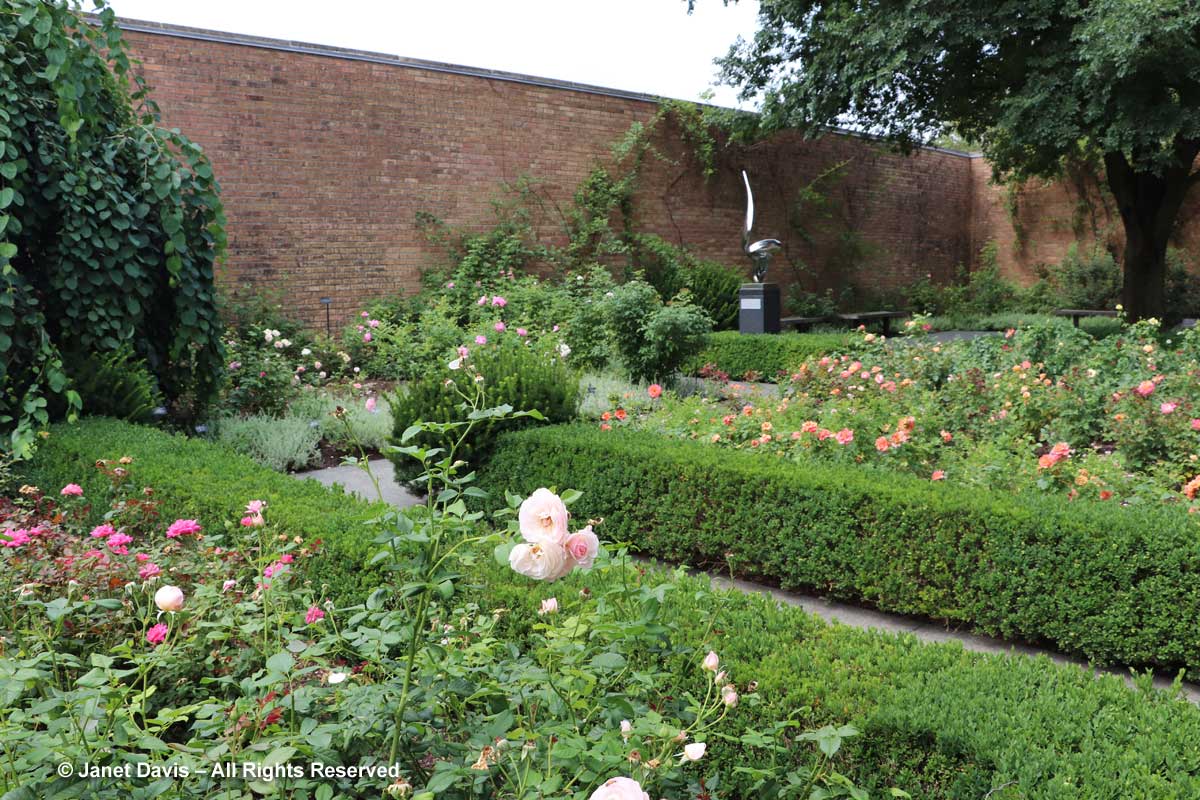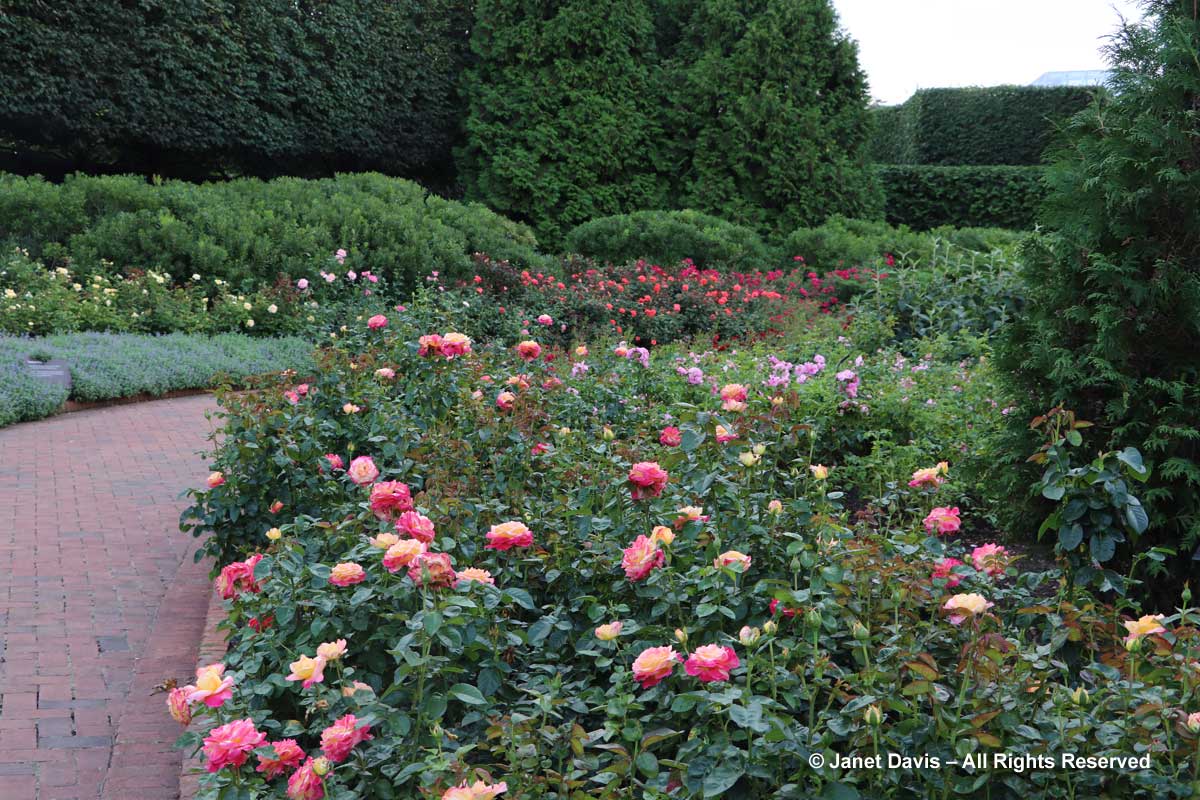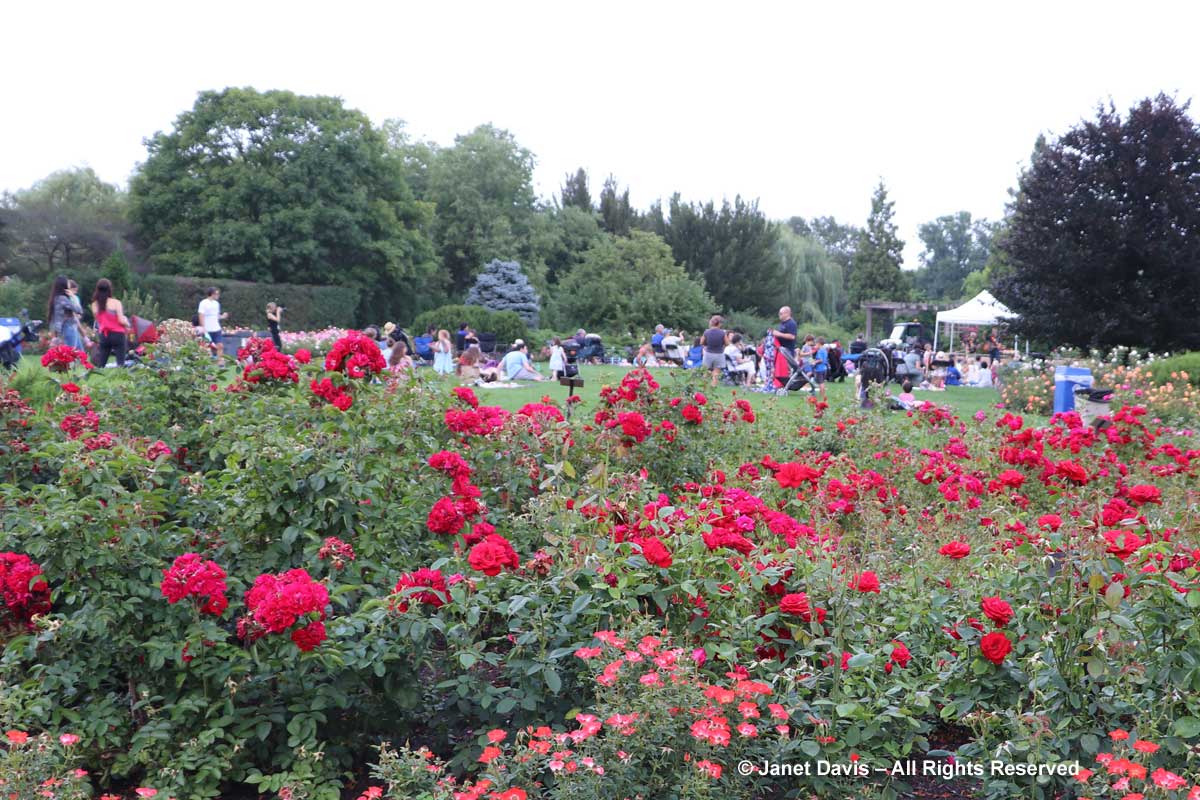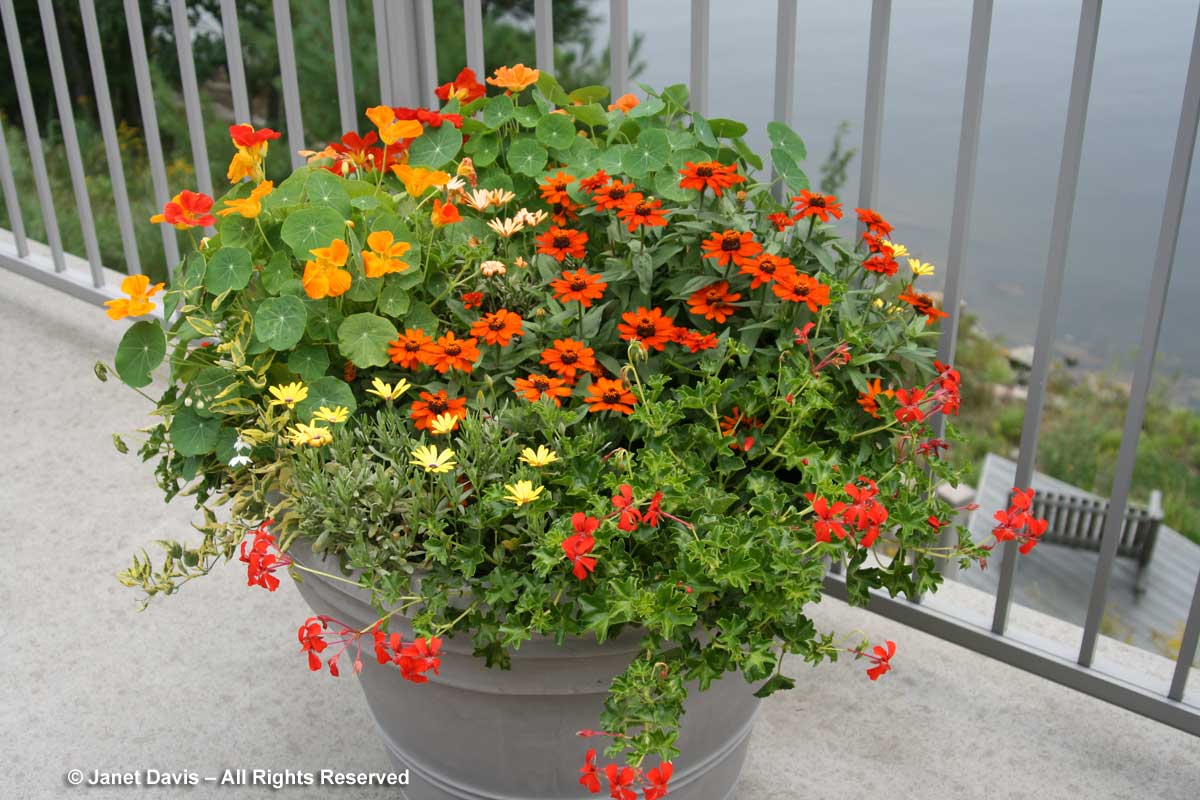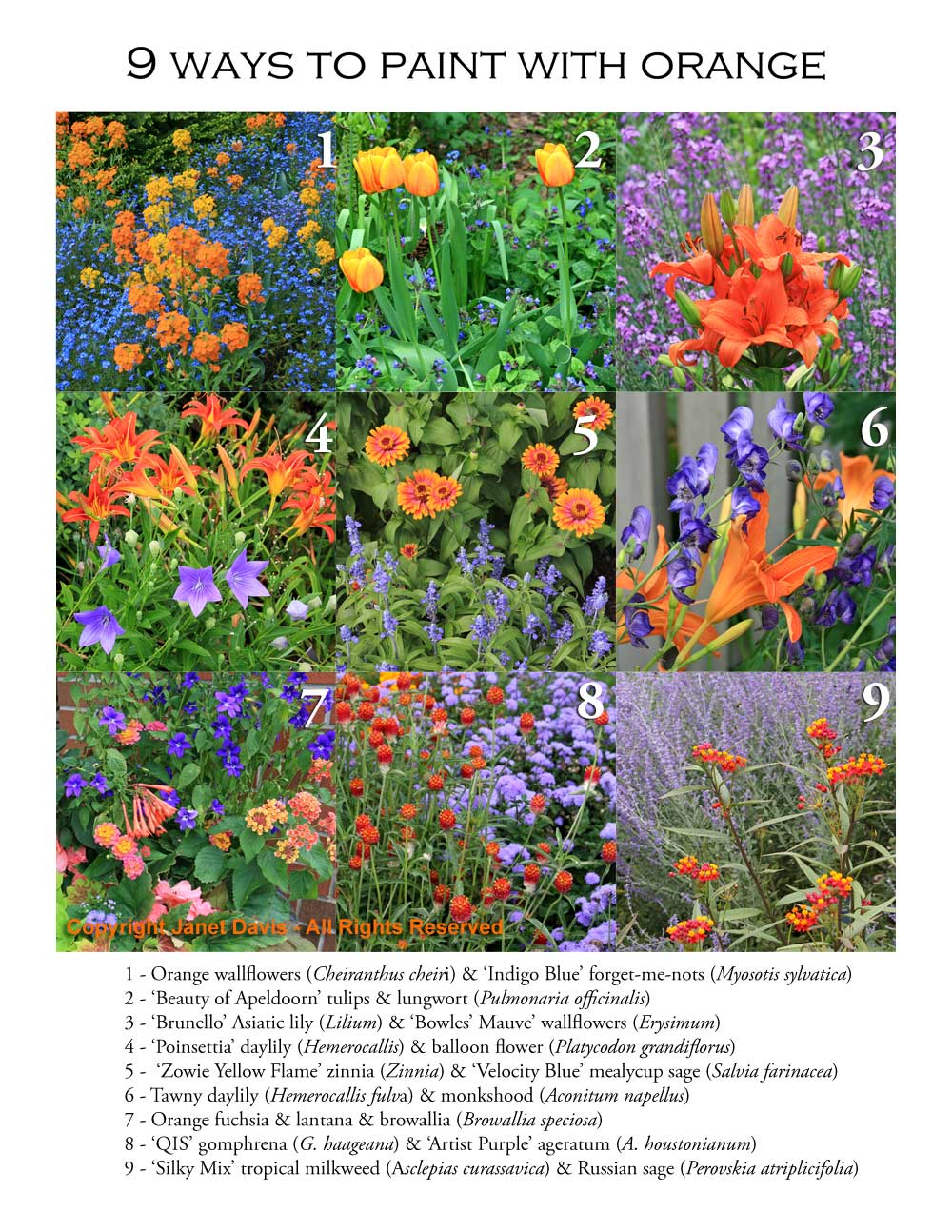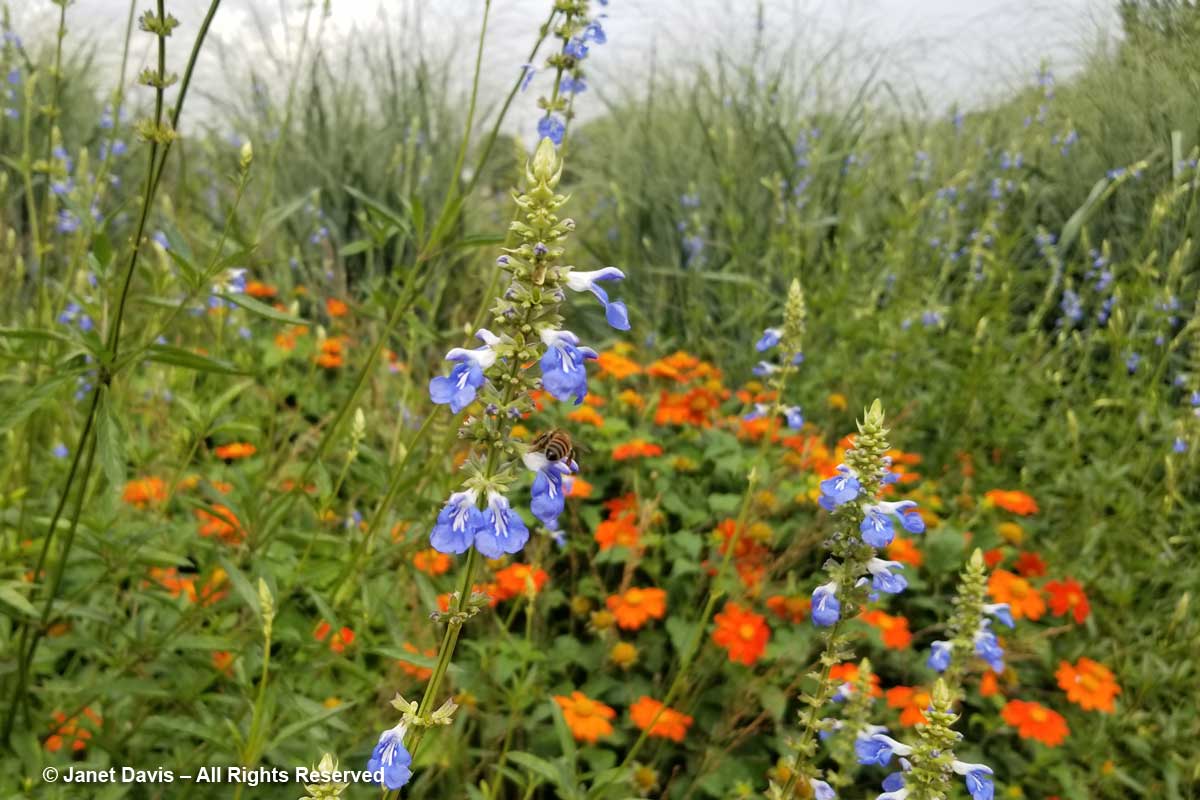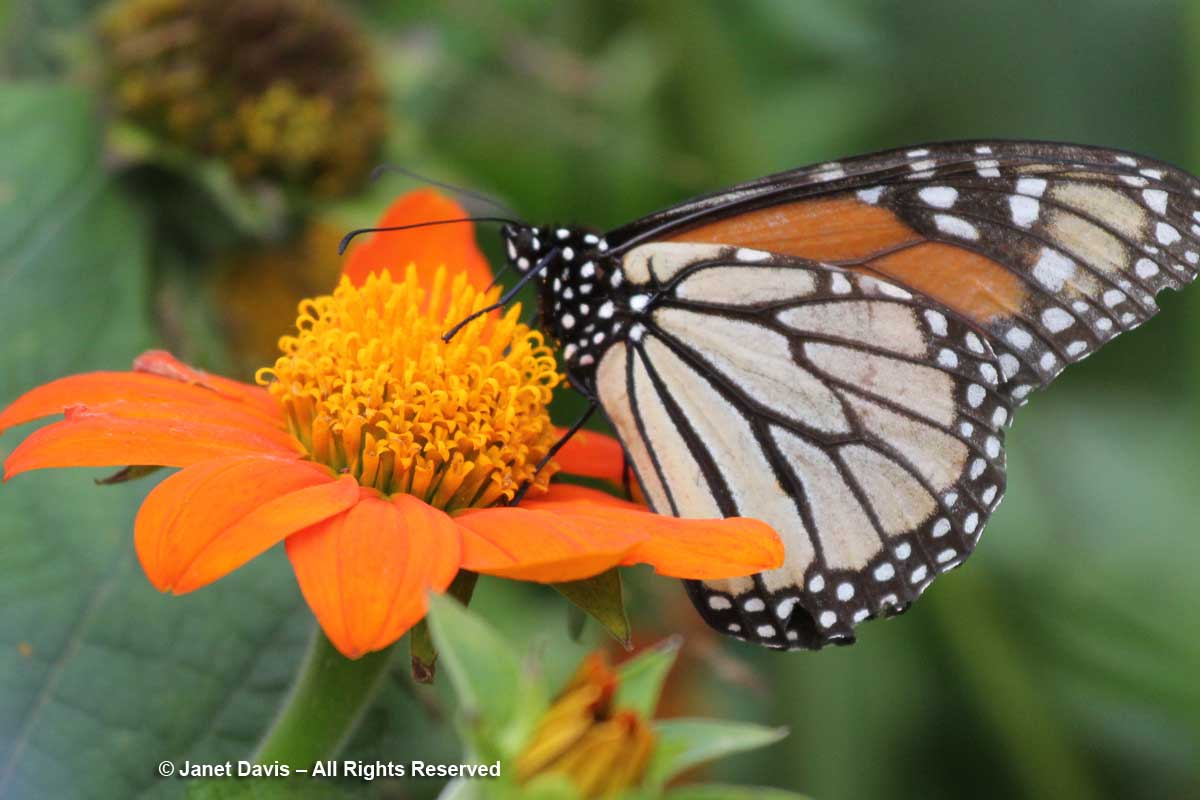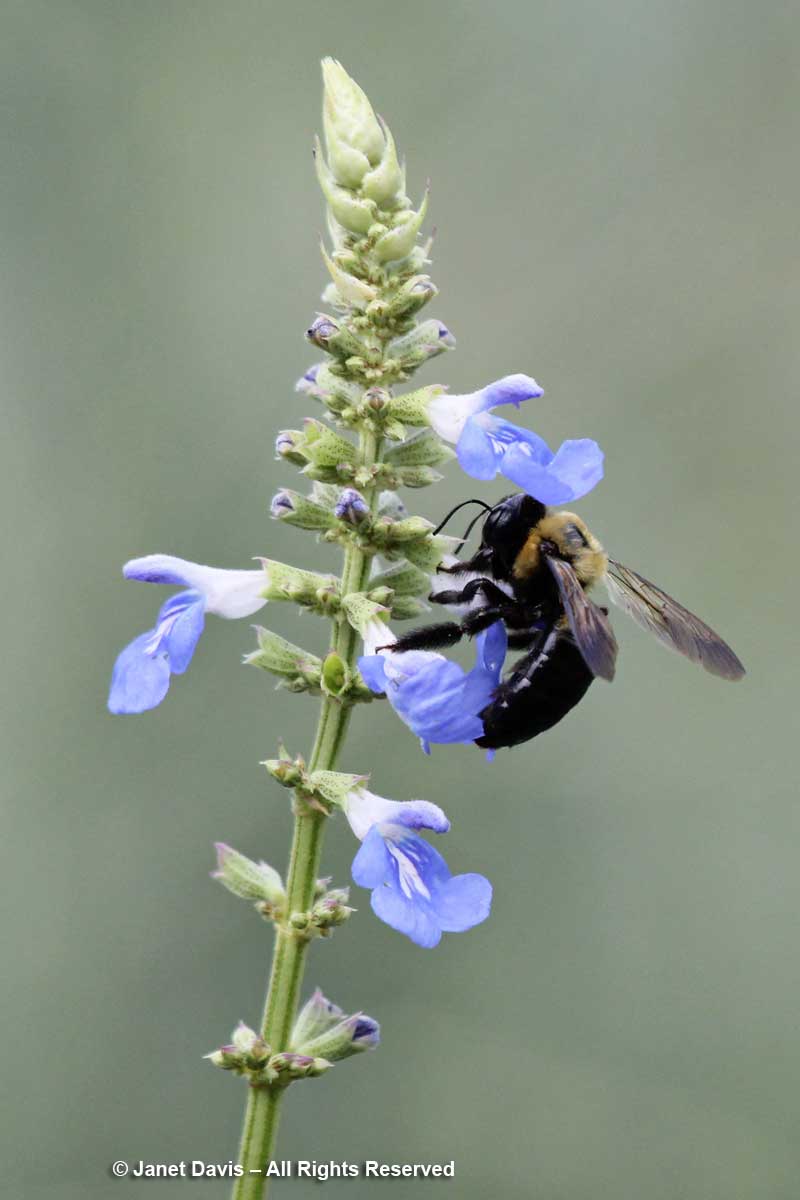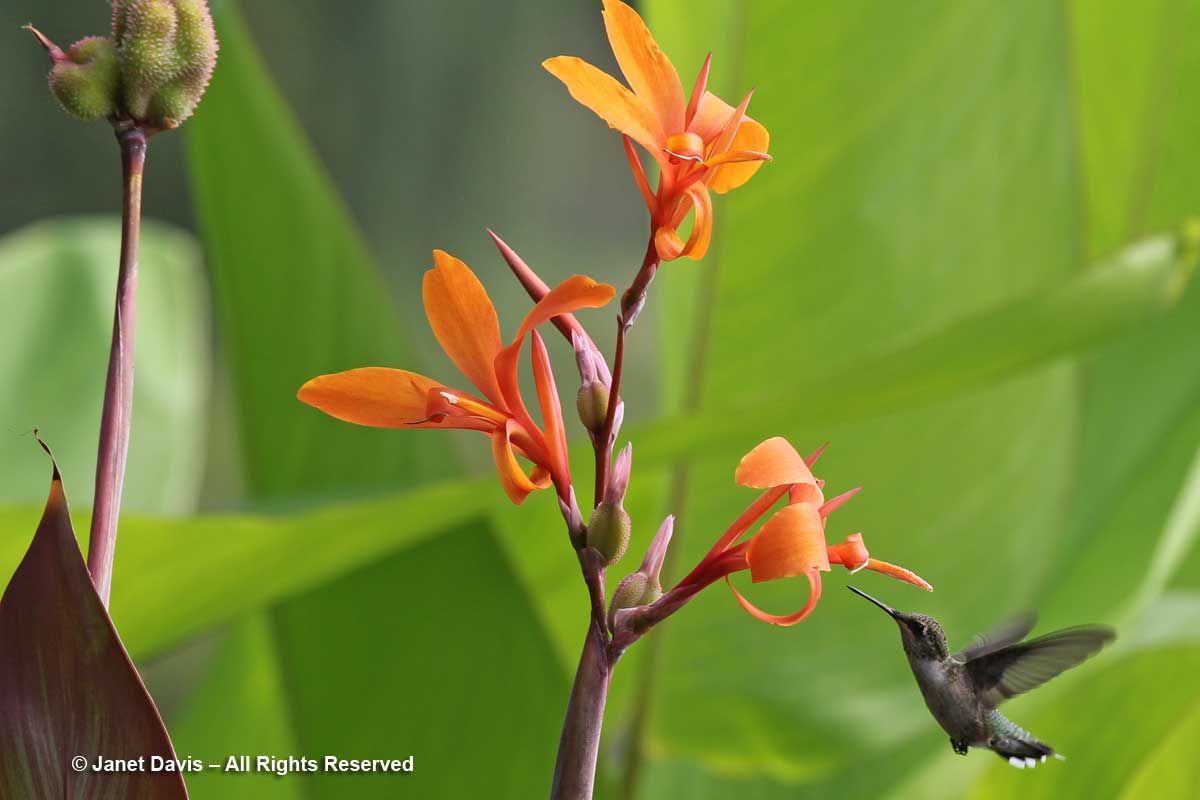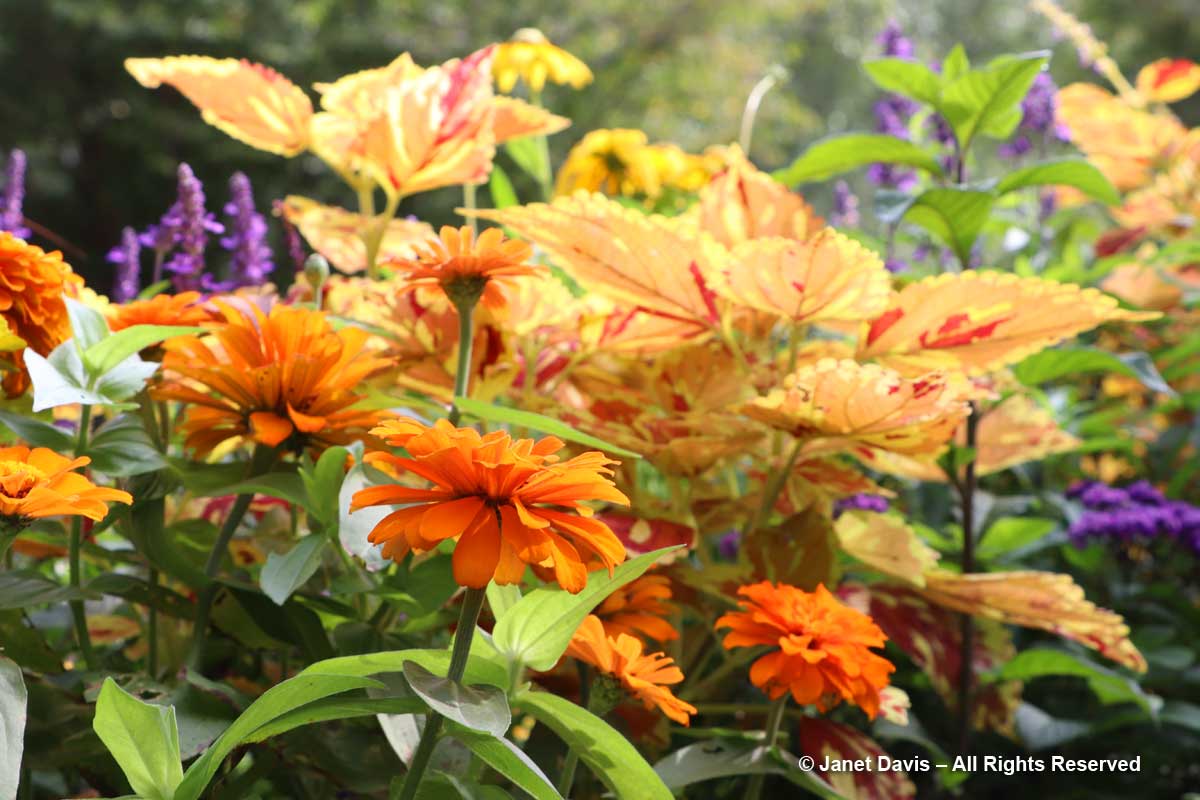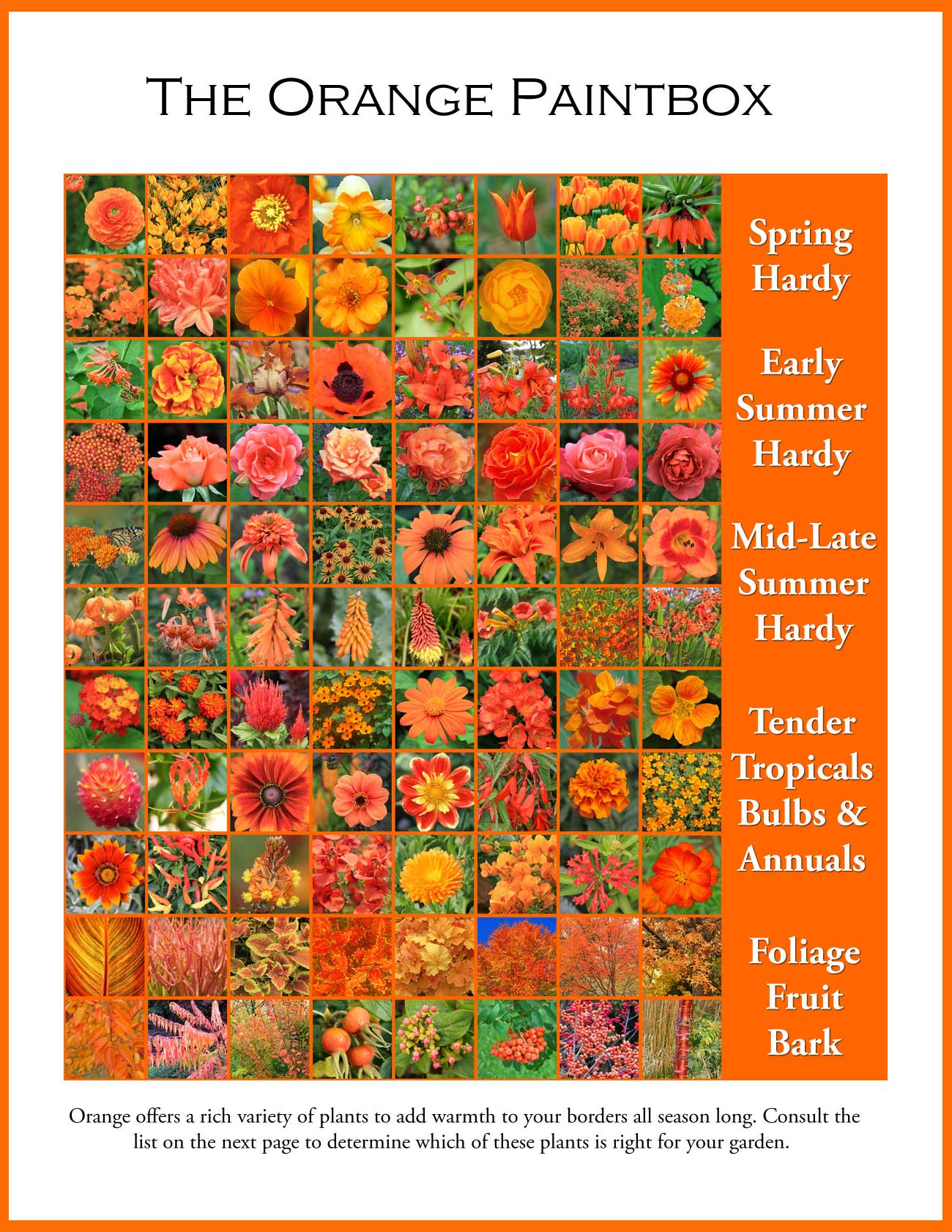I was excited when I heard that the Garden Writers Association was meeting in Chicago this past summer. I hadn’t attended for a long time because of calendar conflicts, but this symposium was one I was determined to make. Why? The lectures would be good and it would be fun to see some old friends, but mostly it was an opportunity to see the Lurie Garden downtown and the Chicago Botanic Garden in their late summer glory. A glance at the tours being offered suggested that CBG would be a small part of a northern suburbs tour, so I decided I would take an entire day and Uber myself the 25 miles up to the garden north of the suburb of Glencoe. I shared the cost of the $50 (approximate) ride with another GWA member, arriving before 10 am. If you go, it’s a good idea to take a look at the comprehensive garden map online and upload the Smartphone App. Keep in mind that CBG is 385 acres, featuring 27 interesting, far-flung gardens and 9 islands set in 60 acres of lakes comprised of the Skokie River lagoons. Even with my 7-hour stay in August, I didn’t see all the gardens. It is also a spectacular resource for students of some of the most eminent contemporary landscape architects, including Dan Kiley, John Brookes and Oehme, van Sweden.
CBG offers free admission, but charges a fee for parking. Even in the Parking Lot, you can see that CBG’s gardeners pay close attention to colour, with signs referring in several places to relationships on the artist’s colour wheel.
I walked past the Visitor Center containing the restaurant (where I would dine with a local relative later) and marvelled at this…..
…… amazing planting, below, on the edge of one of the garden’s many water courses: the big red flowers of ‘Lord Baltimore’, a hardy swamp hibiscus hybrid, with wine-red Joe Pye weed (Eutrochium sp). Isn’t it beautiful?
The Crescent near the entrance is devoted to seasonal displays of spring bulbs and annuals set in concentric, crescent-shaped, boxwood-lined beds. It was conceived by the renowned modernist landscape architect Dan Kiley in 2002, and installed posthumously.
Dan Kiley also conceived of the plan for the adjacent formal garden, The Esplanade, which is described as the garden’s “village green”. Here is the view along its sculpted walkway back beneath the alleé of Commendation™ elms towards the entrance. As CBG says, “Kiley saw the Esplanade as an opportunity to create a great sense of place and arrival, offering visitors glimpses of vivid sweeps of color against the water and sky as they pass over the bridge outside the Visitor Center.” Following his death in 2004, the designs for both the Crescent and Esplanade were completed and installed by Kiley’s colleague Peter Morrow Meyer.
And here are the Esplanade’s lovely niches. You can see here the influence that André LeNôtre’s 17th century work at Versailles had on Kiley, who visited France while working as chief designer for the U.S. Army during WWII.
As CBG notes of the modernist ethos: “The tenets of modern landscape architecture continue to resonate: Keep it simple. Make it useful. Let the spaces flow. Strive to make connections. Dan Kiley was a master of these ideas.” The Esplanade’s lake walk and water terrace offer visitors a unique opportunity to engage with the garden’s “deep ties to the water”.
Similarly, the three long water fountains and their line of splashing water plumes (very Versailles!) create music that draws visitors towards them.
The beautiful Gertrude Nielsen Heritage Garden, opened in 1982, was funded by the daughter of the man who invented the Nielsen Ratings for television.
Designed by Pittsburgh landscape architect Geoffrey Rausch, it pays tribute to the early tradition of botanic gardens with its circular, four-quadrant shape modelled after the earliest such garden, in Padua, Italy, the Orto Botanico di Padova (1545). The central bed recalls a classic ‘physic garden’ and medicinal plants from around the world.
The garden is dedicated to Carl Linnaeus, who developed our modern system of binomial nomenclature to name plants, and whose statue, by Robert Berks, adorns the border in the background.
Canna lilies are just one of many aquatic plants represented in the three water gardens arrayed around the central bed.
Visitors are educated about taxonomy as they circle the garden. For example, they learn that both snapdragons (light-yellow flowers halfway up the border) and…..
….. butterfly bush (Buddleja davidii ‘Pink Delight’) are both in the Scrophulariaceae or Figwort Family. Late summer monarchs enjoy nectaring on butterfly bush.
Tender plants from the Bromeliaceae family are brought from greenhouses into the border, like this Aechmea ‘Yellow Berries’.
Or they might discover (via a sign in the border) that chaste-tree (Vitex agnus-castus ‘Lecompte’), below, has been moved by the naming authorities from Verbenaceae to Lamiaceae. In this way, even beginning gardeners understand the complexity of the plant world.
I made a quick stop in the Buehler Enabling Garden, where various strategies are demonstrated for people with physical infirmities that prevent them from traditional gardening, or for gardeners who find it harder to follow the same methods as they age. Raised beds, below, are one way to make gardening easier.
There are lots of beautiful planting ideas in the garden, all in delicious colour combinations, and many with perfume to create a sensory garden. In the background you can see the Tool Shed, which features adaptive tools for gardeners.
I loved the violet, lilac and pale-blue tones in this combination.
Gardeners limited to tight spaces will find inspiration in the living wall vertical gardens and splashing water wall in the Buehler Garden. (To learn much more about the Enabling Garden, download the .pdf at this American Public Gardens site.)
I was determined to spend lots of time at Evening Island so I hurried there via the interesting Water Gardens edging the Great Basin. That’s white-flowered bog bean (Menyanthes trifoliata) with red-stemmed thalia (Thalia geniculata var. ruminoides) out there near the duckies.
Standing quietly, I watched a ruby-throated hummingbird nectar on canna flowers. I believe this is a cultivar called ‘Intrigue’.
Although the water gardens were located near the meandering Serpentine Bridge to Evening Island…..
……. I went down the shore to the Arch Bridge.
Unsurprisingly, this sleek bridge with its overhanging weeping willows and waterlilies was inspired by Impressionist painter Claude Monet’s bridge at Giverny.
There are some wonderful gardens along the water here, filled with aquatic and marginal plants like pink-flowered swamp hibiscus (H. moscheutos) with sacred lotus (Nelumbo nucifera), below…..
….. and a native North American duo with which I’m very familiar from fens and swamps here in Ontario: blue-flowered pickerel weed (Pontederia cordata) and pink water willow (Decodon verticillatus).
Then it was over the bridge and onto Evening Island itself. (I made a video of my tour of the island which you’ll find below, complete with birds chirping and kids laughing.) Dedicated in 2002, the island was designed by Oehme van Sweden of Washington, D.C. whose founding principals James van Sweden and the late Wolfgang Oehme are renowned for articulating a garden style called the New American Landscape. From the OvS website, “The style is characterized by large swaths of grasses and layered masses of perennials that boldly celebrate the ephemeral through mystery, intrigue, and discovery.” After walking along a pathway from the bridge, I arrived at my favourite spot: a simple, linear garden arrayed along the Great Basin and featuring some of those bold plants. I took the steps down past yellow daylilies, blue Russian sage (Perovskia atriplicifolia) and ‘Tardiva’ hydrangeas (H. paniculata).
Along the path was more Russian sage, threadleaf coreopsis, feather red grass (Calamagrostis x acutiflora ‘Karl Foerster’) and ‘Gateway’ Joe Pye weed (Eutrochium purpureum ssp. maculatum) nearest the water.
Here you see the genius of James van Sweden and Wolfgang Oehme. These beautiful, low maintence plants, used in masses, are not just attractive to people and pollinators, they are designed to frame the view in the most beautiful way. Through the layers of perennials, grasses and waterlilies at the shore, visitors look across the Great Basin and see the formal gardens of the CBG, including the McGinley Pavilion where weddings and receptions are held.
From the path, I could look up at the Theodore C. Butz Memorial Carillon on a rise nearby. Its 48 bells ring out the hours throughout the day. You can hear it in the video, too. Bell concerts are also held here.
I took a quick peek into the stone-walled Nautilus terrace at a family waiting for their child to finish nature camp nearby.
Then I took the path around the island, stopping to admire the eye-popping hillside meadow of the white-flowered hardy hibiscus hybrid ‘Blue River II’, annual spider flower (Cleome hasslerana) and more Joe Pye weed.
I loved the random insertion of big sunflowers (Helianthus annuus) into this garden, Some birds were going to be very happy with all that seed!
Further along was a drift of purple coneflower (Echinacea purpurea) with ‘Heavy Metal’ switch grass (Panicum virgatum) under ‘Whitespire’ birches (Betula populifolia), which are more disease- and insect-resistant than paper birches.
Though many native plants are used, the flower meadows on Evening Island are stylized with colourful combinations that have the advantage of being wildlife-friendly, like this pretty vignette of purple chaste-tree (Vitex agnus castus), annual orange Mexican sunflower (Tithonia rotundifolia ‘Fiesta del Sol‘) and blue bog sage (Salvia uliginosa).
Check out the bee on the sage – and there were monarchs nectaring on the tithonia.
I found myself at the beautiful Trellis Bridge connecting Evening Island to the Lavin Plant Evaluation Garden.
Look at all that gorgeous, purple New York ironweed (Vernonia noveboracensis) mixed with ‘Karl Foerster’ feather reed grass (Calamagrostis x acutiflora)!
And this is a view of the bridge looking back at Evening Island. I think this is my favourite of the three bridges.
The Bernice E. Lavin Plant Evaluation Garden is filled with all kinds of perennials being trialed side-by-side over a 4-6 year period for their worthiness in Midwest gardens. I had a quick look at the blackeyed susans (Rudbeckia sp.) and hardy hibiscus beds but no time, alas, to visit the new Daniel E. & Ada L. Rice Plant Conservation Science Center beyond with its 16,000 square foot green roof. (Definitely another trip needed!)
So it was back across the Trellis Bridge to Evening Island. As I walked over the bridge I spotted this weed harvester, used to reduce the growth of various aquatic plants in the Great Basin, North Lake and elsewhere. The garden also has a zebra mussel problem in the lakes and waterways; these mollusks filter the water for the algae they eat, increasing its clarity and paving the way for even more aquatic weeds.
Back on Evening Island, I stopped at the outlook below to gaze out through another carefully-designed Oehme van Sweden view: under the sycamore and over the feather reed grass, utilized so perfectly here as a shimmery half-curtain framing the view of the water.
Then I came upon a native shrub we don’t see in Ontario, for some reason, though it is perfectly hardy for us: shining sumac (Rhus copallinum).
And that Evening Island video I promised? Here it is…..
I left Evening Island and took a fast tour through the English Walled Garden, designed in 1990 by the late English John Brookes. When he updated it 20 years later, he called it a “mix of Sissinghurst, Great Dixter and a bit of Hidcote”. This is the formal garden….
…. and this is the lovely cottage garden with its mix of flowers and vegetables….
….. and a sunken garden with hexagonal pool.
I hurried back to the visitor center to meet a relative for lunch in the lovely Garden View Cafe. Then it was on to the Native Plant Garden. For me this is one of the most important gardens at CBG, especially as gardeners aim for more pollinator- and bird-friendly gardens using indigenous plants adapted to the climate and soil conditions. In August this garden is filled with a profusion of Chicago area native forbs and grasses and divided broadly into three spaces, a prairie garden, a bird and butterfly garden, and a woodland garden for shade. As a prairie-lover, I focused on what was in bloom at this peak time of summer, like white flowering spurge (Euphorbia corollata), tall compass plant (Silphium laciniatum) and a yellow daisy, possibly heliopsis or Rudbeckia subtomentosa.
You rarely see bright-red royal catchfly (Silene regia) in a garden but it’s a wonderful hummingbird and swallowtail butterfly lure. Here it is with prairie blazing star (Liatris pycnostachya).
Part of the prairie section of the Native Plant Garden overlooks North Lake and Smith Fountain. This is a combination of purple coneflower (Echinacea purpurea) and showy tick trefoil (Desmodium canadense).
I loved the muscled bark of this old American hornbeam (Carpinus caroliniana) in the woodland garden.
I moved on to the Regenstein Fruit and Vegetable Garden whose horticulturist Lisa Hilgenberg I would have the pleasure of meeting the next evening at my GWA Symposium. Grapes cascaded over the long pergola….
….. and were nearing ripeness.
Naked ladies, aka resurrection lilies (Lycoris squamigera) popped up in several places in the garden, here with just one of a series of fruit tree espaliers in the background.
Sunflowers and corn are native North American food plants, along with squash, barely visible under the corn at rear.
Visitors can check out unusual offerings like okra, front.
What beautiful leafy crops!
Education is a principal mandate of CBG, and the Fruit and Vegetable Garden tool wall offers an excellent how-to primer.
Vegetables are planted everywhere, including in these beds terraced out over the water. Vegetable growing is part of the internship program of CBG’s Windy City Harvest Apprenticeship Program, which educates and employs 80-90 teens from low-income communities at four sites in the Chicago area. Through the program, vegetables grown here are sold to the CBG’s cafe.
Next up was the Graham Bulb Garden. As I gazed at the bees foraging on the wonderful ‘Millenium’ flowering onions (hybridized by my friend Mark McDonough), I thought how beautiful this garden must be in springtime after Chicago’s long winter, filled with tulips, daffodils and loads of tiny bulbs.
Nearby were some great color ideas, with explanations based on the artist’s color wheel. This happy melange of zinnias with dahlias and cannas represented analogous colours of red, orange and yellow.
Nearby was the Farwell Landscape Garden and I had a brief look at the Informal Herb Garden, below, but aware of the time I elected to keep going.
Though my knees were beginning to complain about all the walking I’d done, I made the decision to head out to the Dixon prairie. My walk paralleled the 22-acre Skokie River Corridor which introduced me to this little profile on Joan O’Shaughnessy, the lawyer-turned-ecologist in charge of the Skokie River Corridor and the nearby Dixon Prairie. If you’re interested in riparian and prairie ecology, you might enjoy this podcast with Joan.
The Suzanne Searle Dixon Prairie, opened in 1982, is named for a long-time Lake Forest resident who was so passionate about the Illinois prairie and its wetlands, that she made conservation and ecology a prime focus of her community activism and philanthropy (her great-grandfather founded G.D. Searle, a pharmaceutical company which invented the first birth control pill and aspartame, i.e. Nutra-Sweet.) Though the Dixon Prairie occupies a 15-acre site that was never part of the iconic Illinois tallgrass prairie, it has nevertheless been painstakingly designed to represent 6 prairie ecotypes that exist in northeastern Illinois: 1) sand prairie; 2) gravel hill prairie; 3) bur oak savannah; 4) tallgrass prairie; 5) fen prairie; and 6) wet prairie. (I got to all of them but the wet prairie.) My first look was over cup plant (Silphium perfoliatum) and moisture-loving obedient plant (Physostegia virginiana) onto the lake separating the prairie from Evening Island in the background. CBG is proud of its lakes, and a sign nearby states that its 60 acres of lakes support native plants and largemouth bass, crappie, carp, bluegill as well as ducks, egrets, herons and cranes.
To be honest, without a guide it’s not easy to distinguish the different communities, but if there are bur oaks (Quercus macrocarpa), you know that’s savannah, which features occasional trees in a sea of grasses and forbs.
I could discern the gravel hill prairie easily, because it jutted up above the flat prairie and was bereft of tall species, as these relics from the last ice age tend to be. CBG achieved this rare habitat by adding a thick layer of gravel over topsoil. Around the hill’s base in more mesic soil, I saw the long, dark-purple seedheads of leadplant (Amorpha canescens), spotted Joe Pye weed (Eutrochium maculatum), blackeyed susans (Rudbeckia hirta), the spiky balls of rattlesnake master (Eryngium yuccifolium), pale-mauve obedient plant (Physostegia virginiana), the big basal leaves of prairie dock (Silphium terebinthinaceum) and the dancing flowers of gray-headed coneflower (Ratibida pinnata).
Visitors are introduced to the plants of a fen prairie, which features an abundance of groundwater…..
…. and supports prairie moisture-lovers like great blue lobelia (L. siphilitica) and swamp milkweed (Asclepias incarnata), a favourite larval food of the monarch butterfly.
Bumble bees were nectaring on pollinator-friendly culver’s root (Veronicastrum virginicum).
The Dixon Prairie is vast and full of so many interesting plants, but much more understated than CBG’s Native Plant Garden, which seems extra-floriferous in comparison.
Here are nodding onion (Allium cernuum) and sweet blackeyed susan (Rudbeckia subtomentosa).
I loved all the educational signs, especially this one showing the complexity of the below-ground community and deep roots of prairie species.
Big bluestem (Andropogon gerardii) features abundantly in the August tallgrass prairie, along with the baby’s-breath-like flowers of flowering spurge (Euphorbia corollata).
Switch grass (Panicum virgatum) is another mainstay of the tallgrass prairie.
It was time to leave but I stopped for a few minutes to watch a song sparrow foraging on the fruit of biennial gaura (G. biennis), one of those plants that many gardeners would likely pull out, given its tendency to look a little weedy. But that would deprive a lot of bees of nectar and birds like this one of food. These are the valuable lessons of the Dixon Prairie.
Despite the gusting wind, I made a little video to remember some of the sounds of my hour or so here on this special prairie.
Chicago Botanic Garden deserves at least a full day’s visit, but I certainly could have used at least four more hours. As it was, I missed the Aquatic Garden, the Bonsai Collection, the Children’s Growing Garden, the Japanese Garden, the Dwarf Conifer Garden and the greenhouses. I had seen a few of those on my previous visit a decade ago, but I do need to return to see them again. As I walked back through the gardens to catch an Uber back to the city, I heard singing coming from the Krasberg Rose Garden.
The roses were looking lovely in August….. this is Love and Peace™…..
….. but my takeaway from the Rose Garden was the crowd of little children and parents listening to the singer giving a nature-oriented outdoor show, one of hundreds of annual events, programs and classes that make Chicago Botanic Garden not just a beautiful, leafy oasis in urban Illinois, but a vital part of the cultural community here too.

